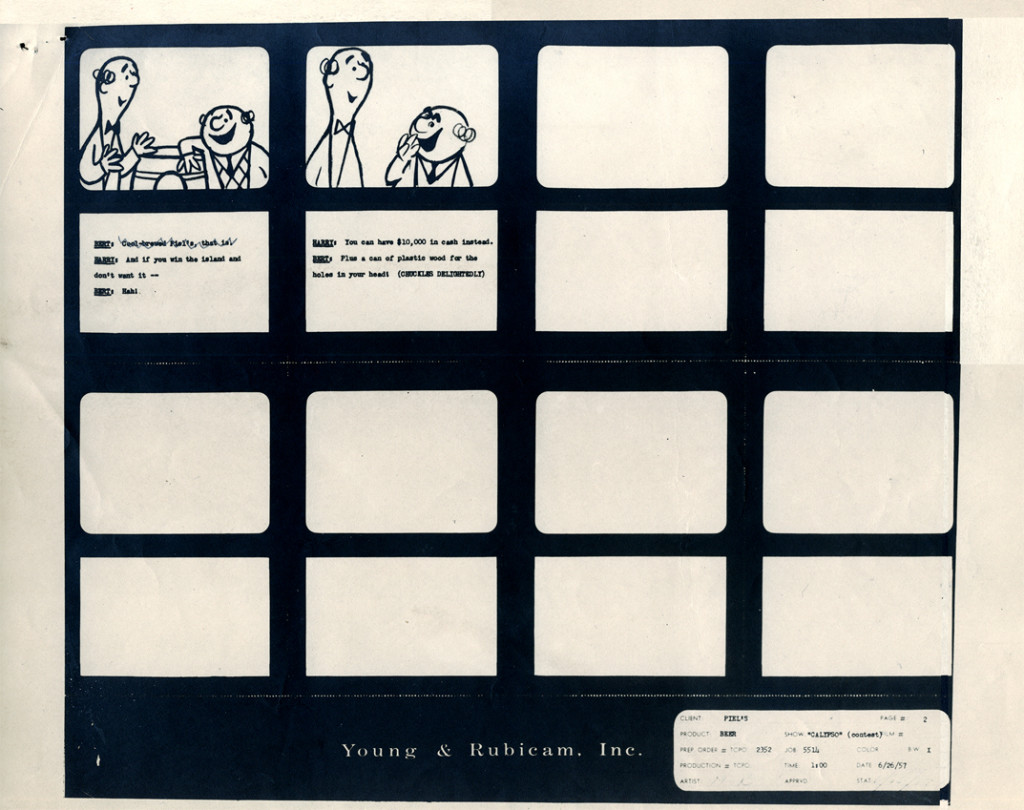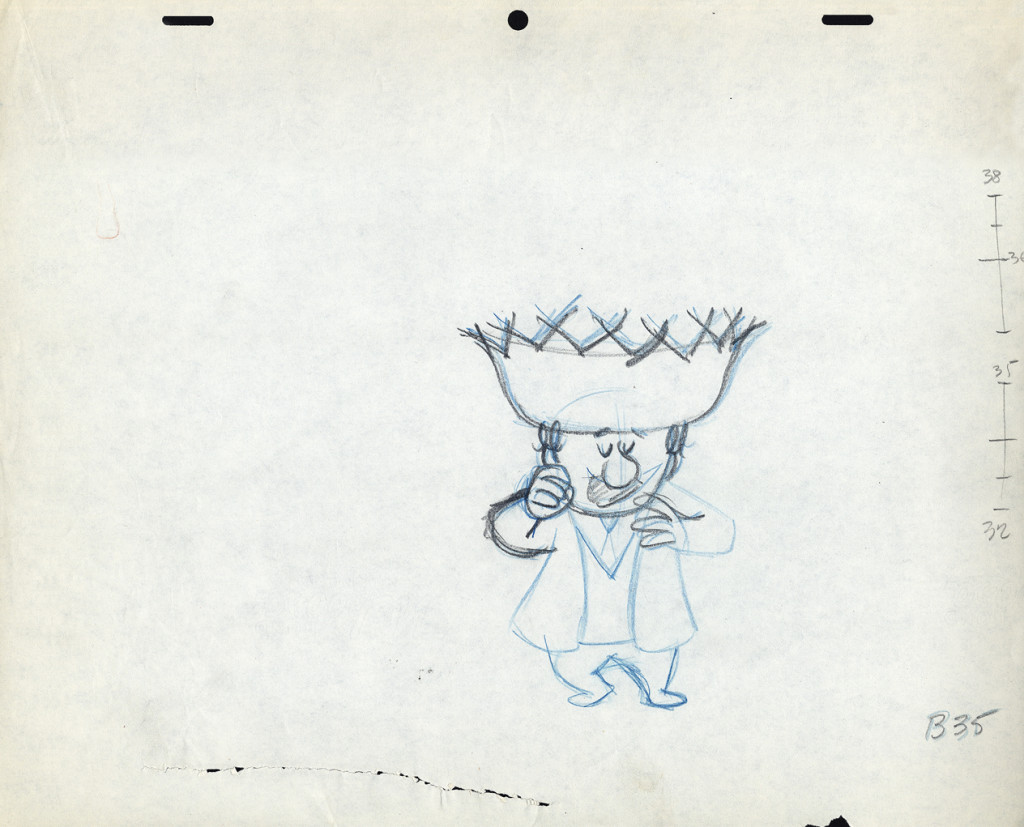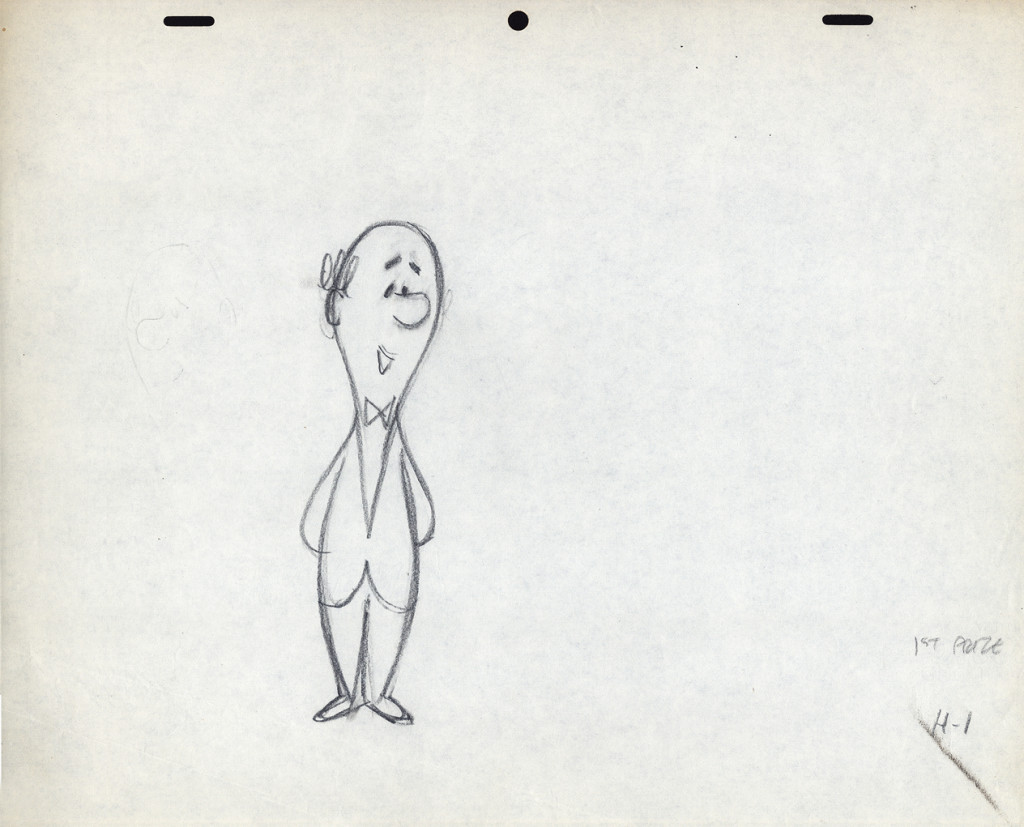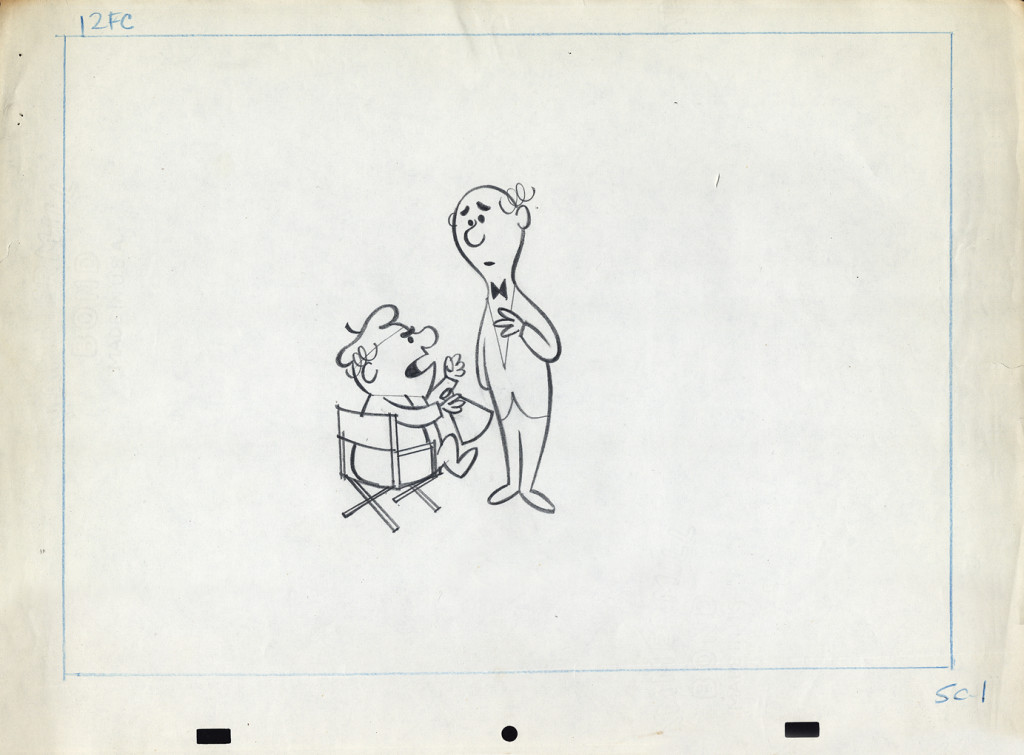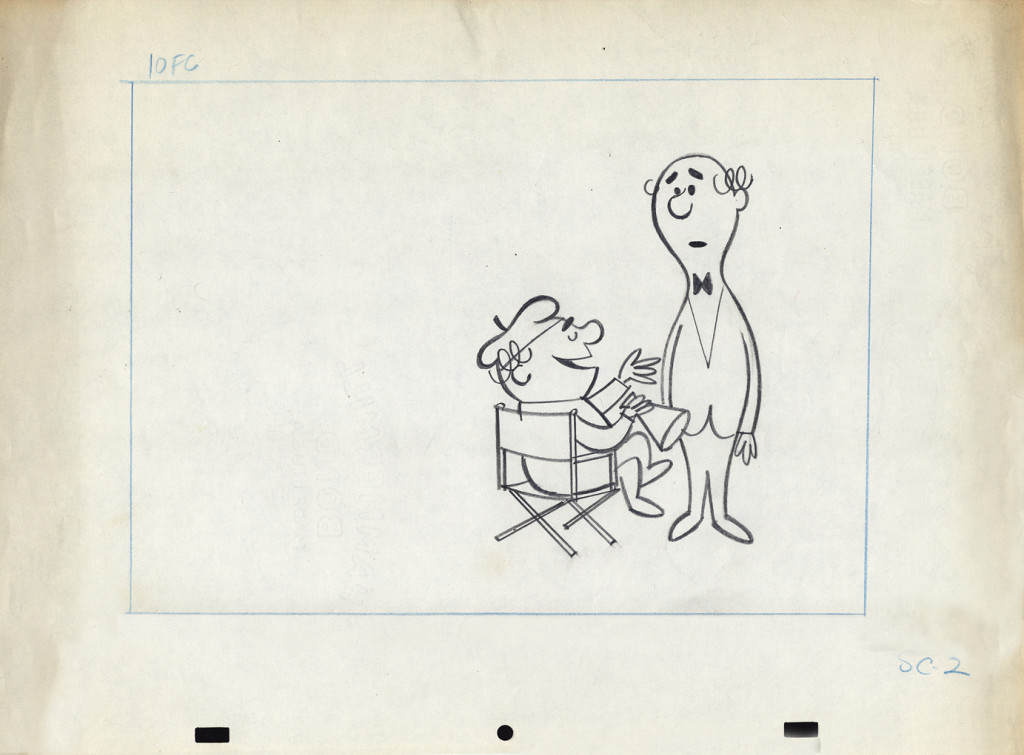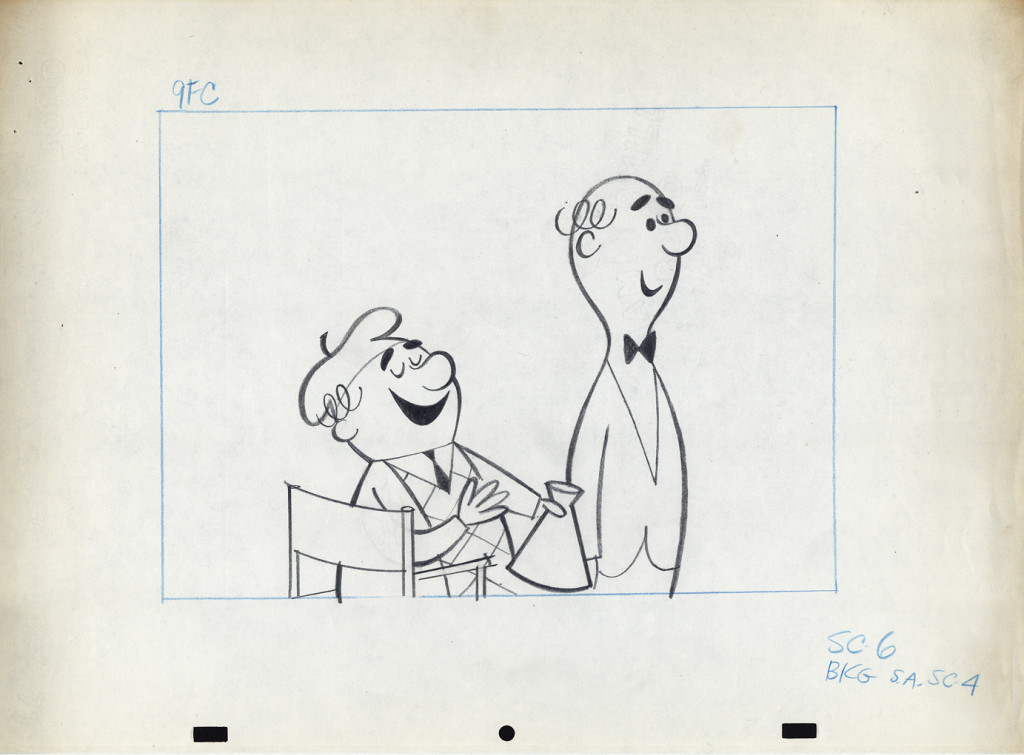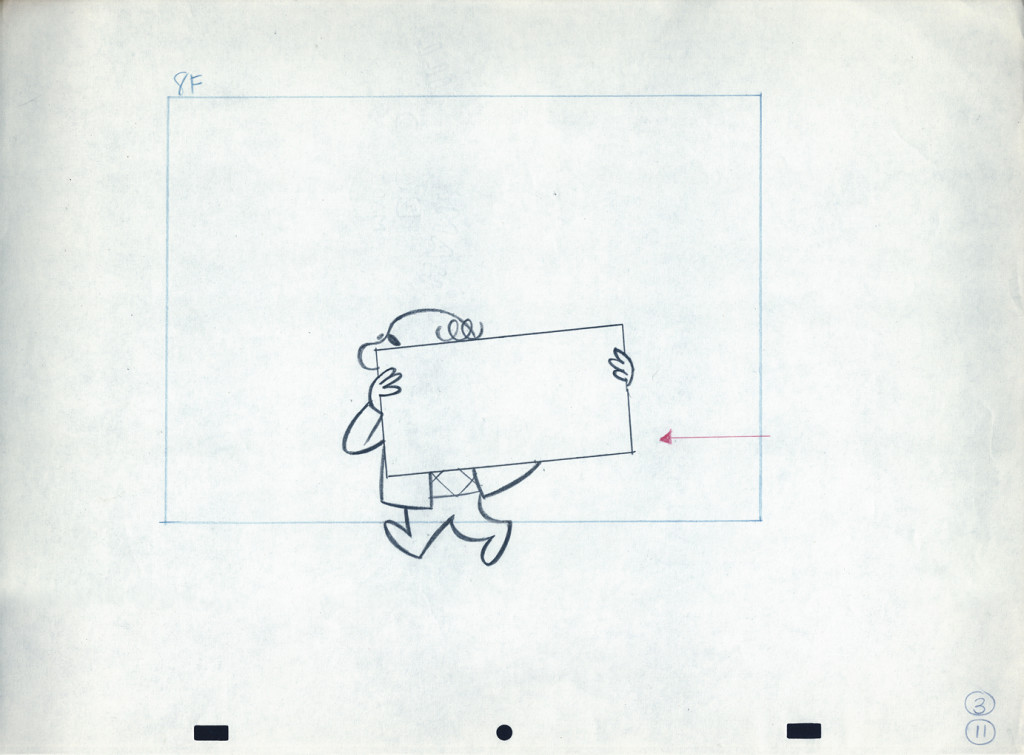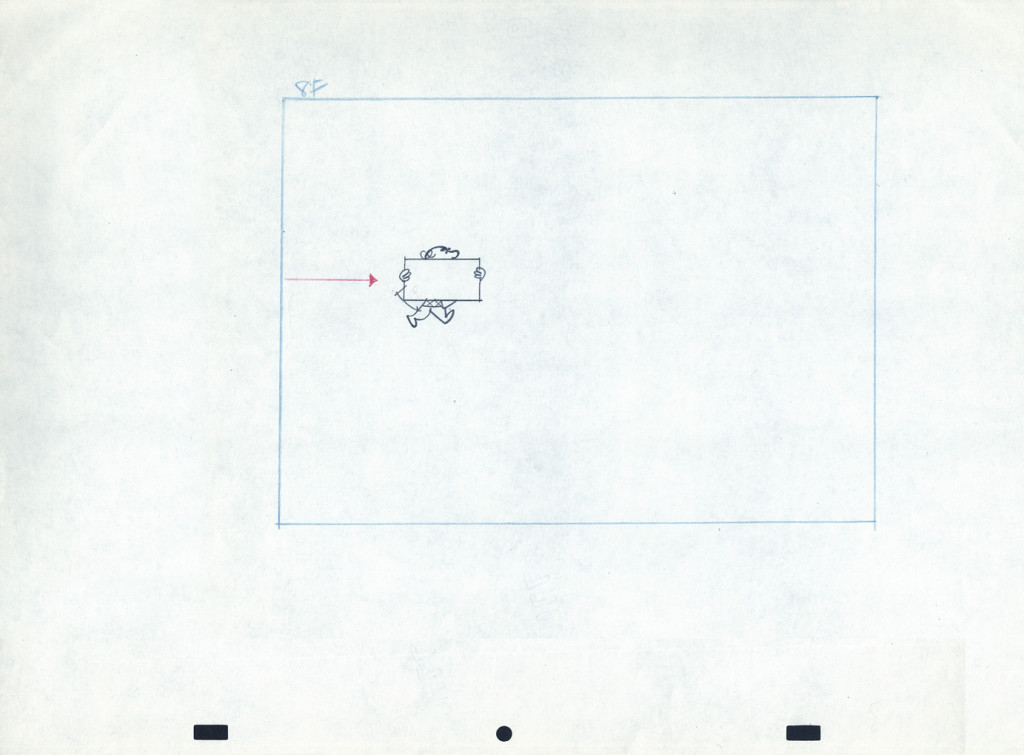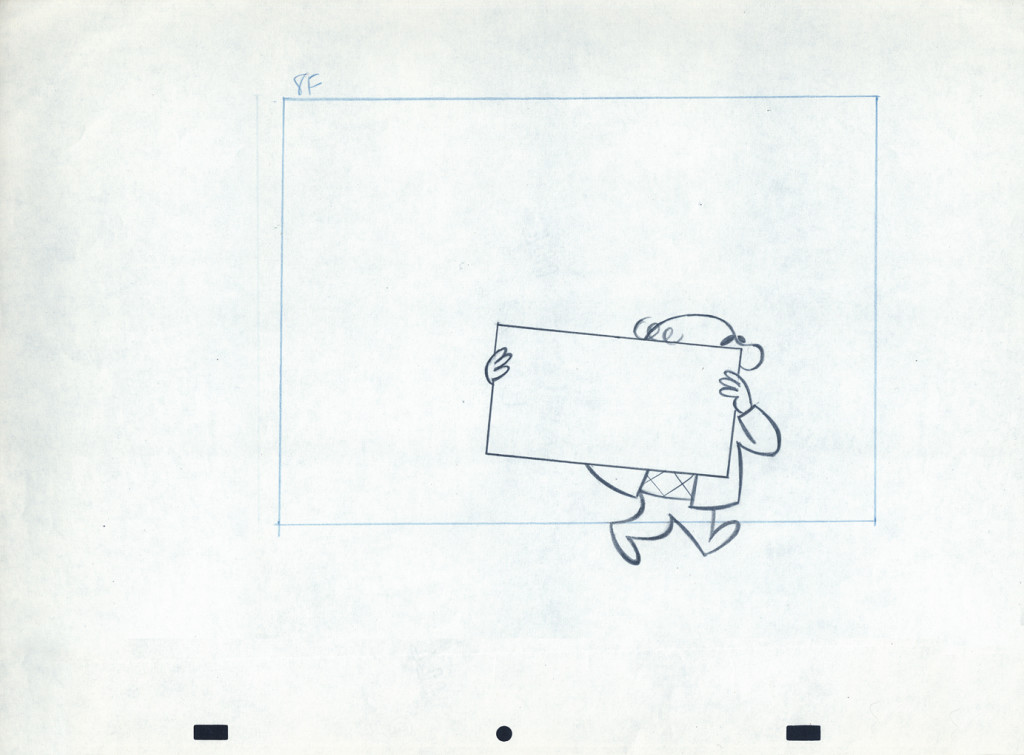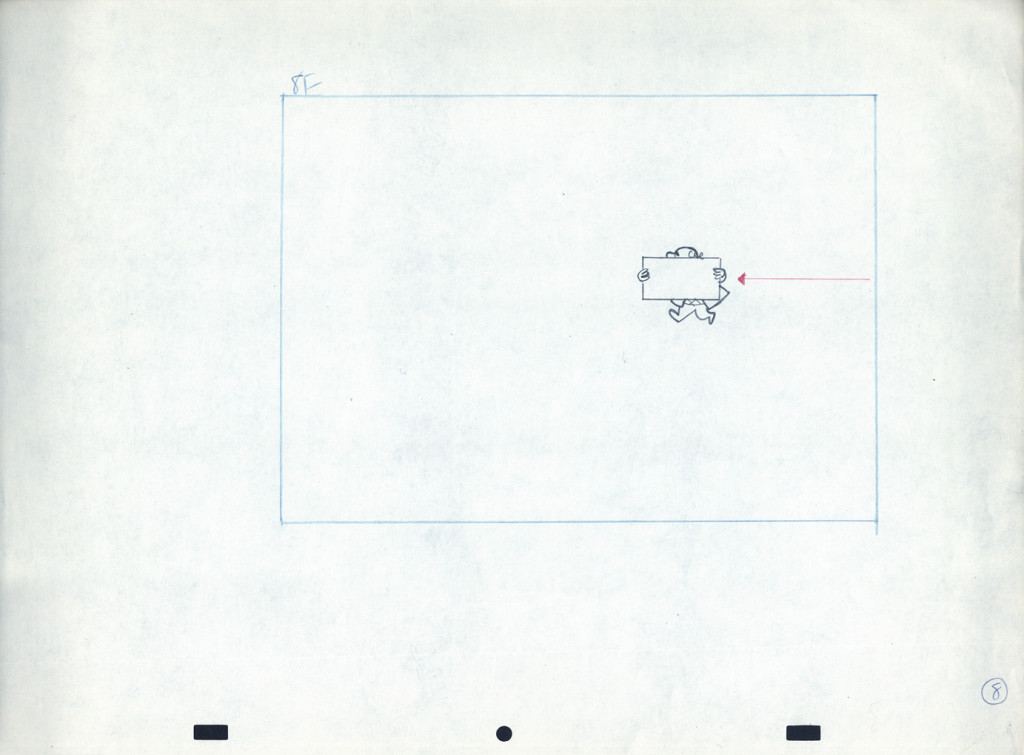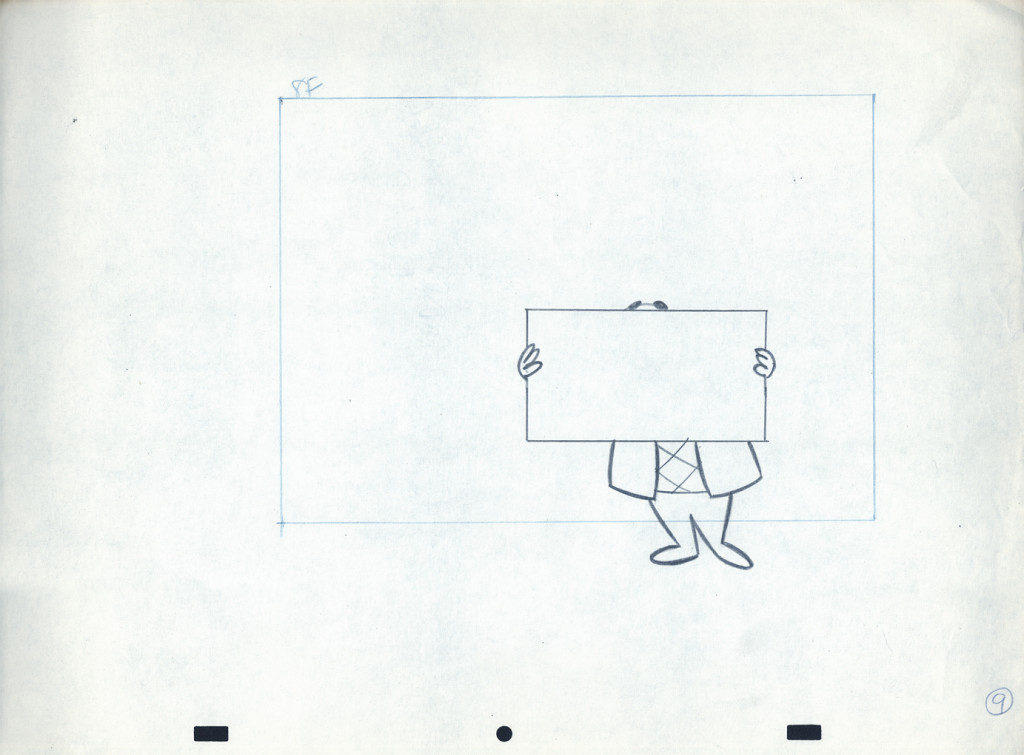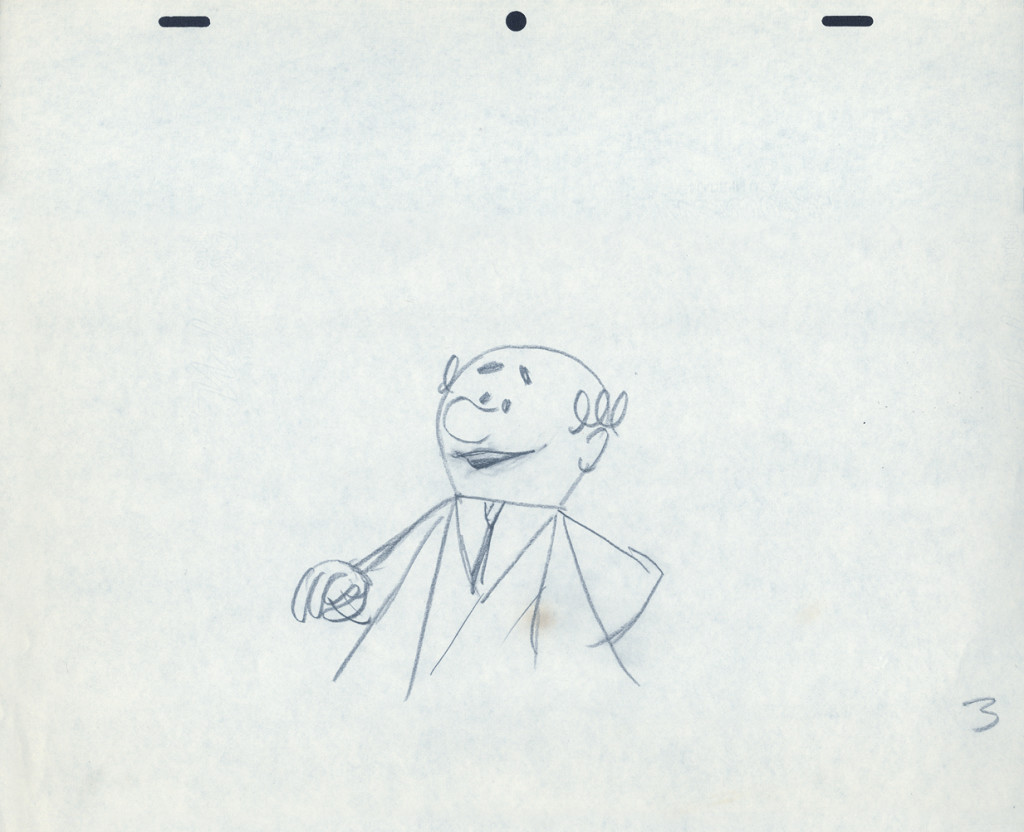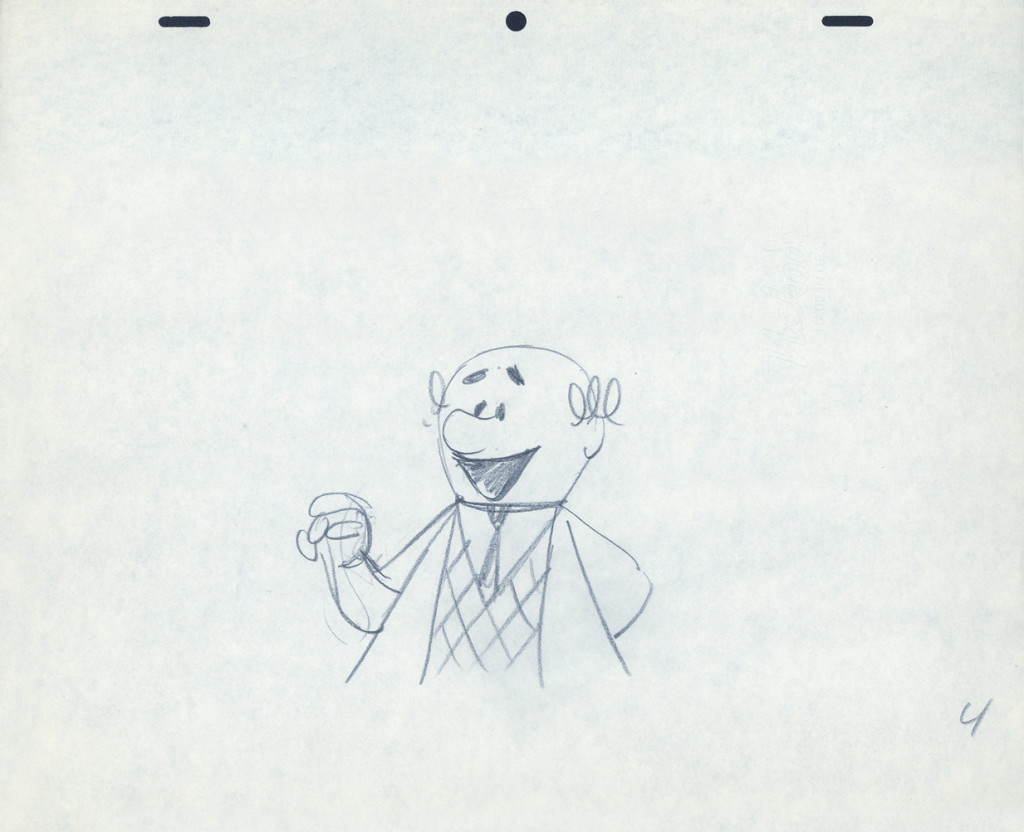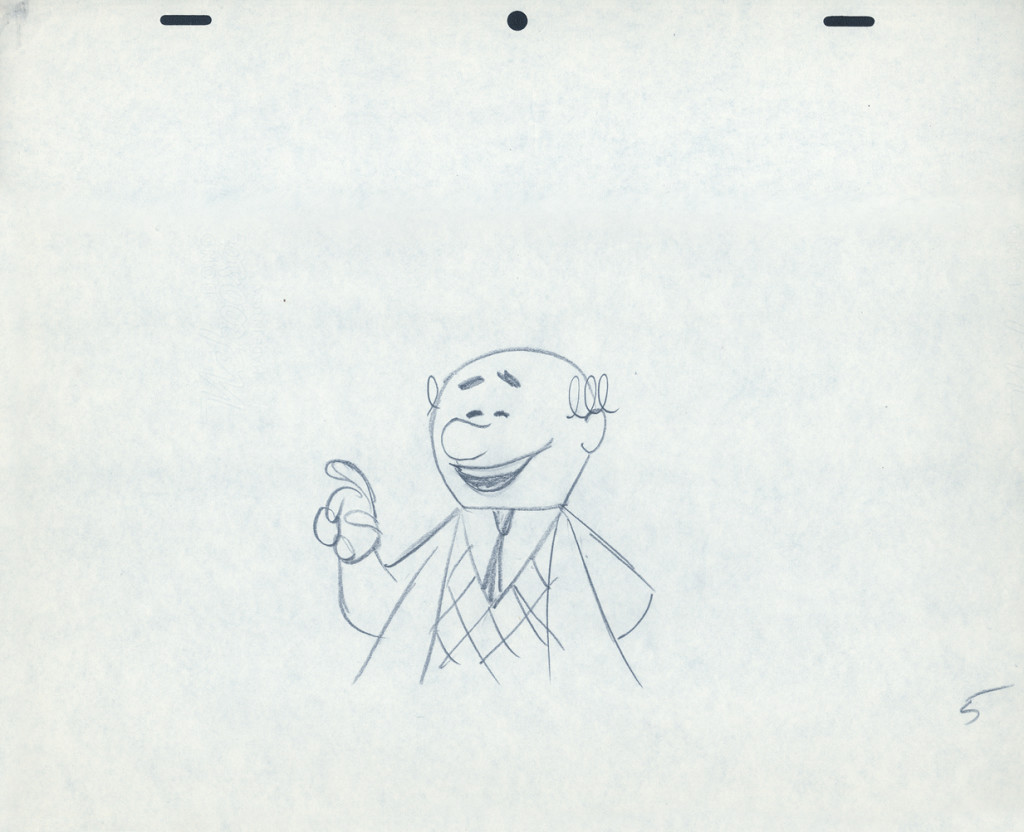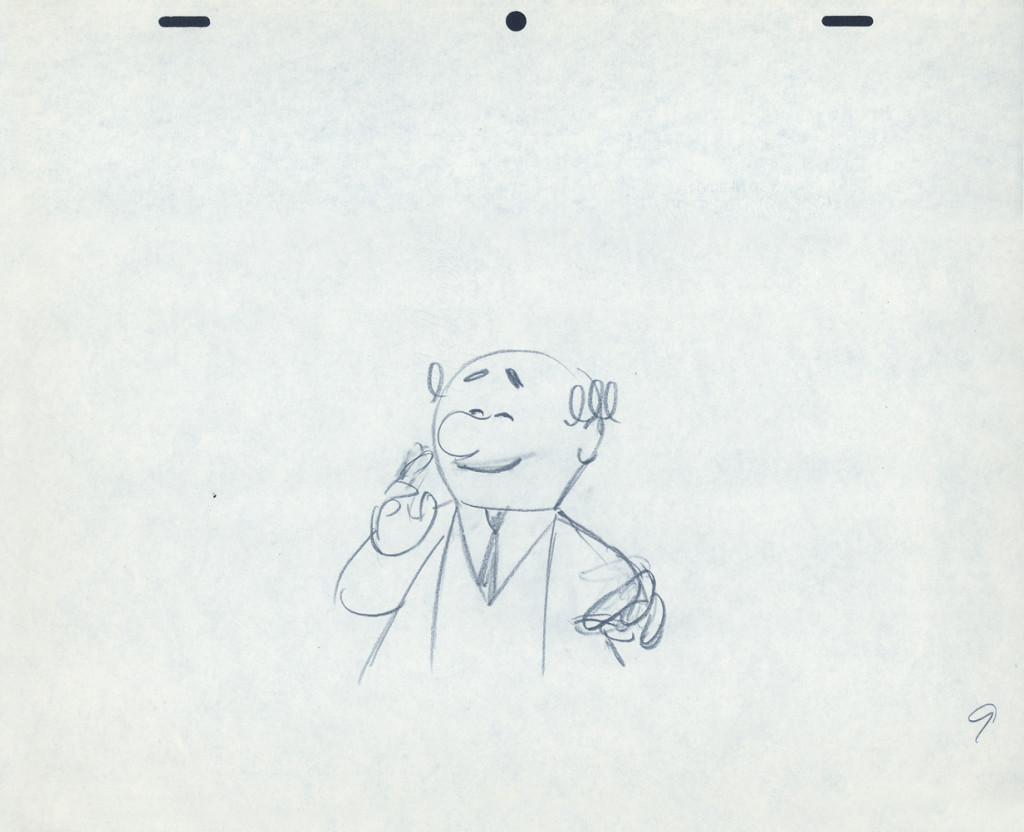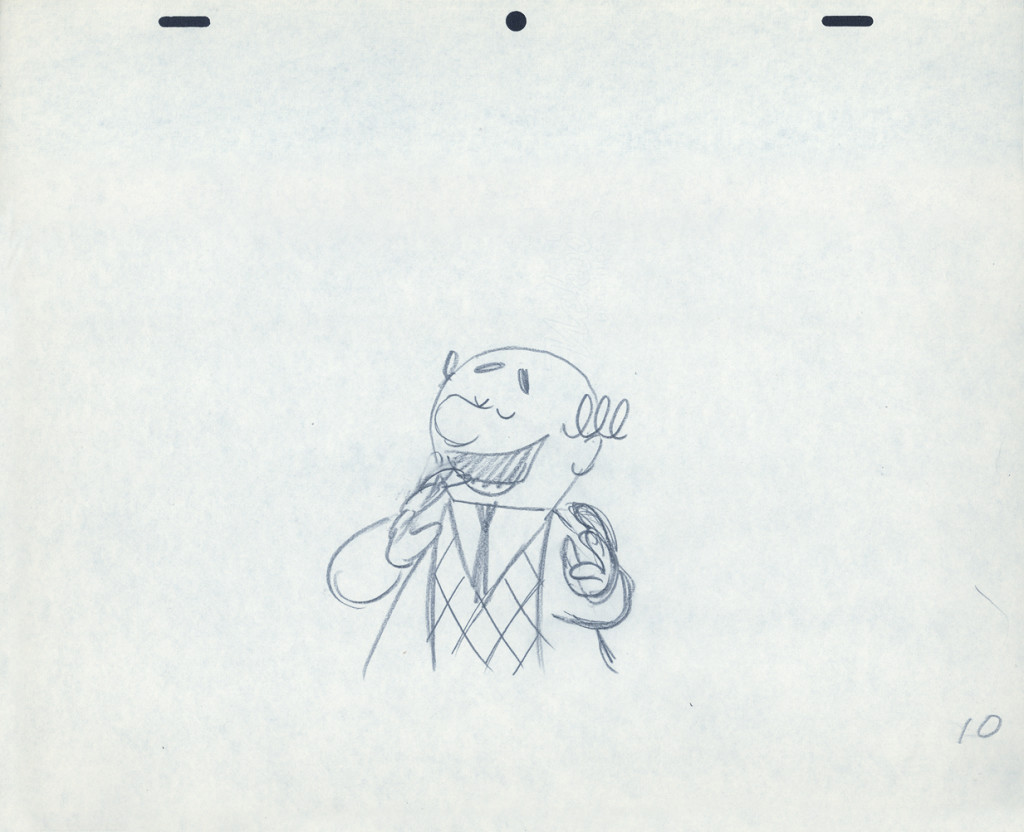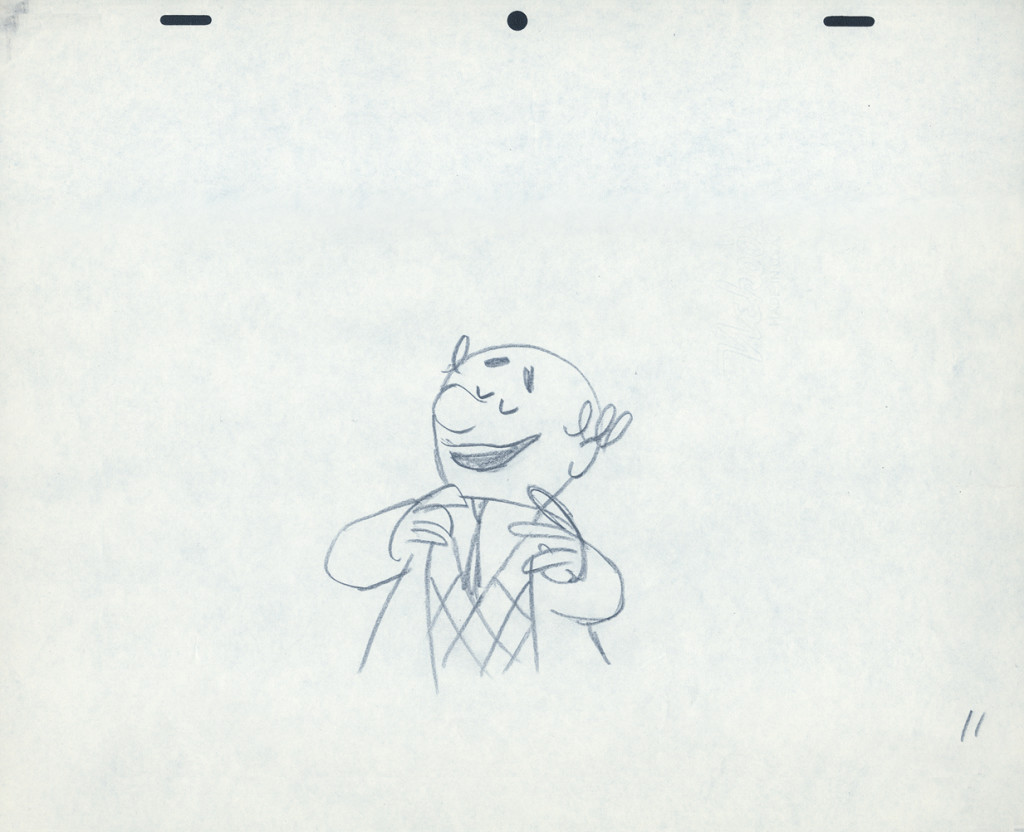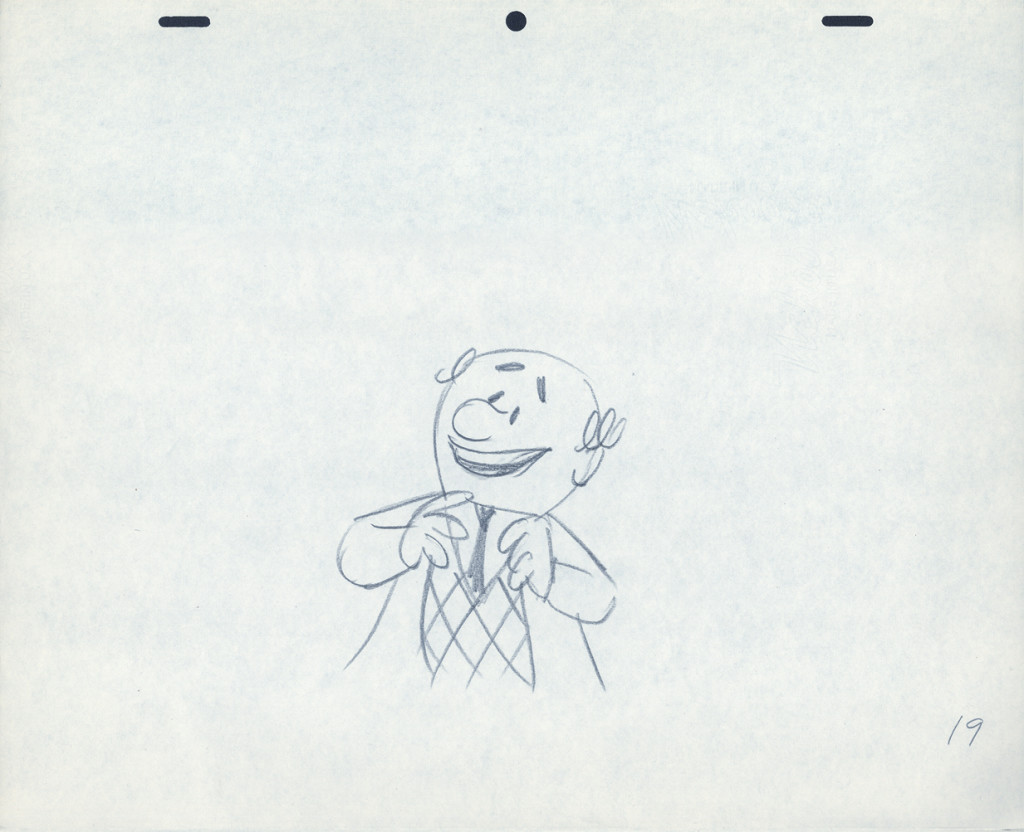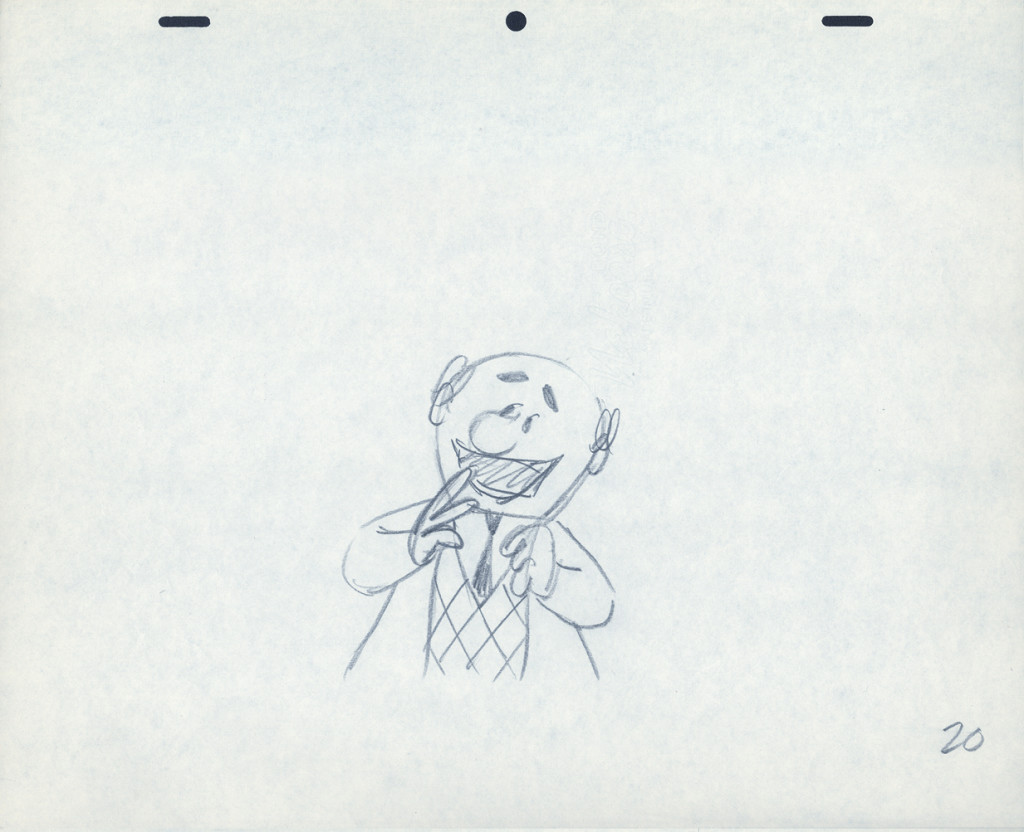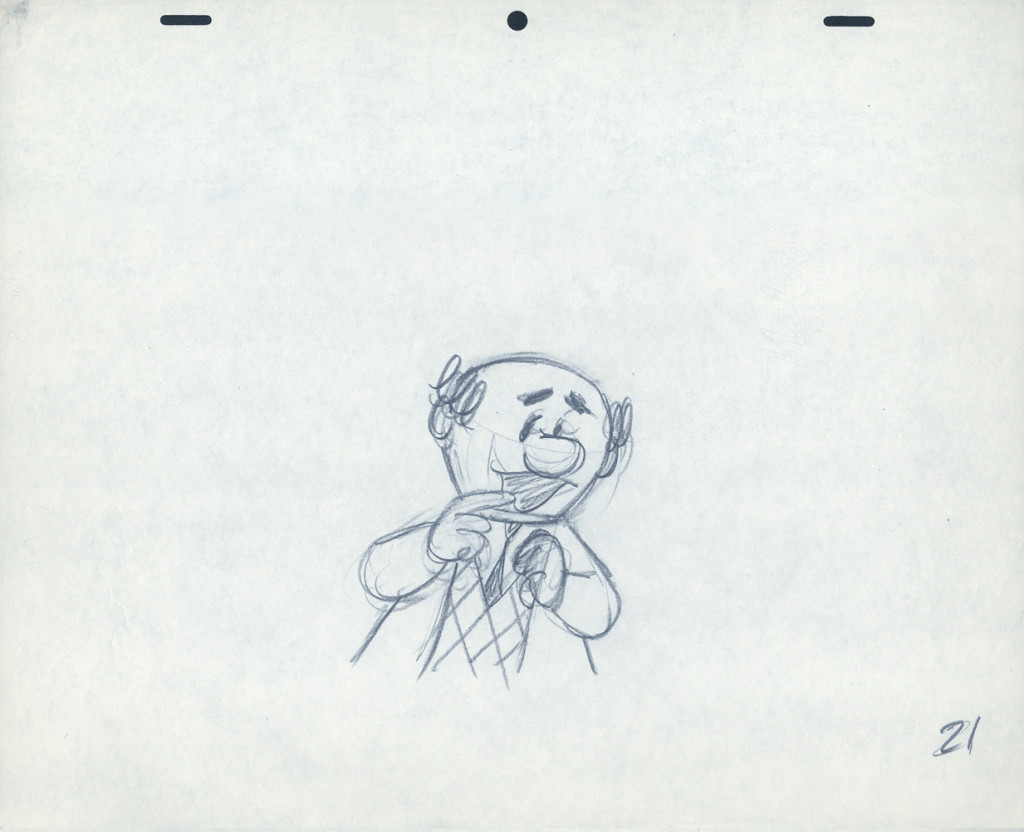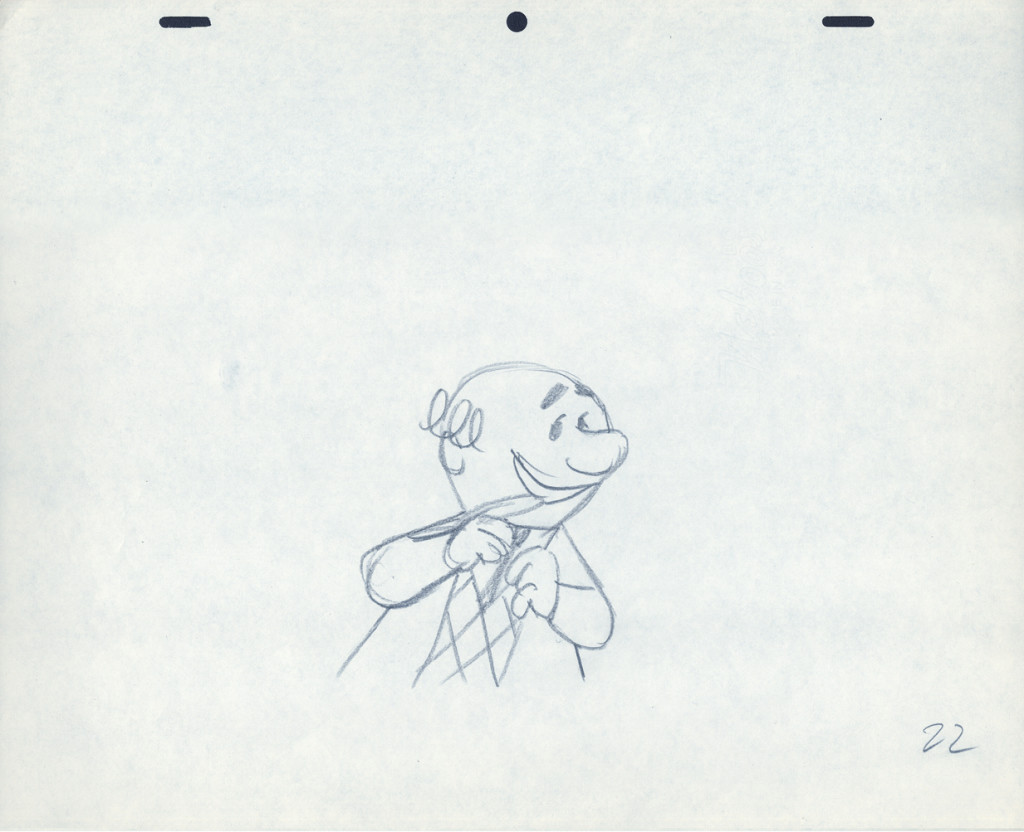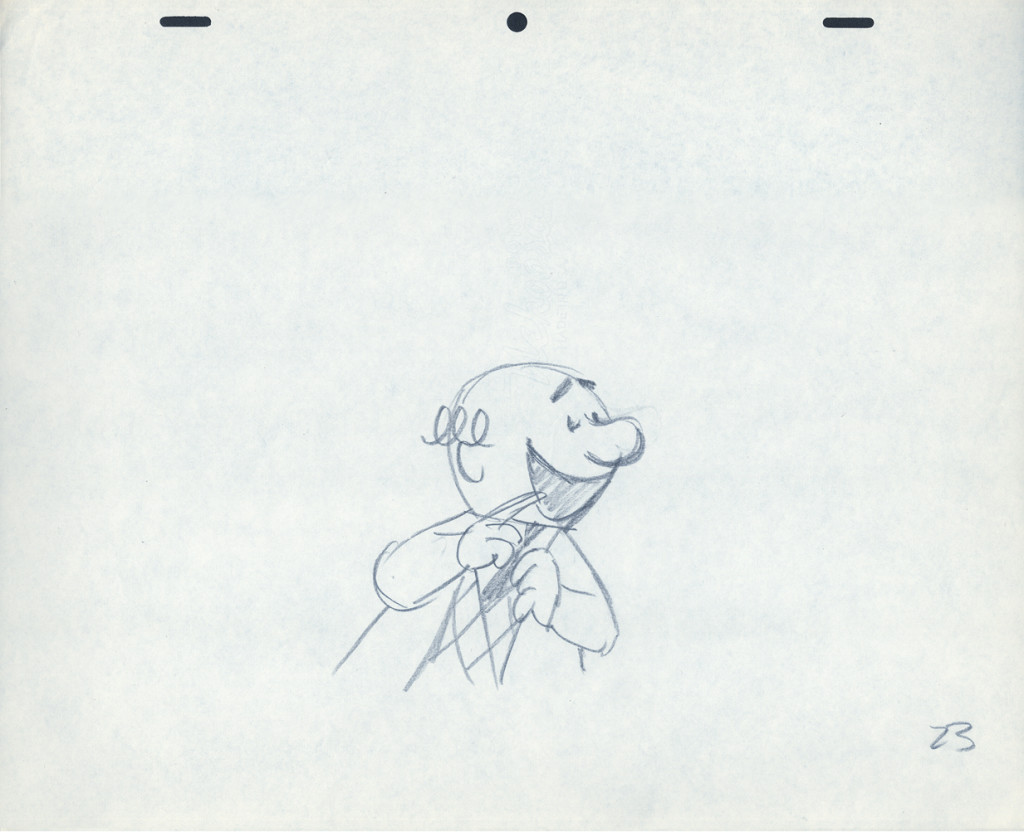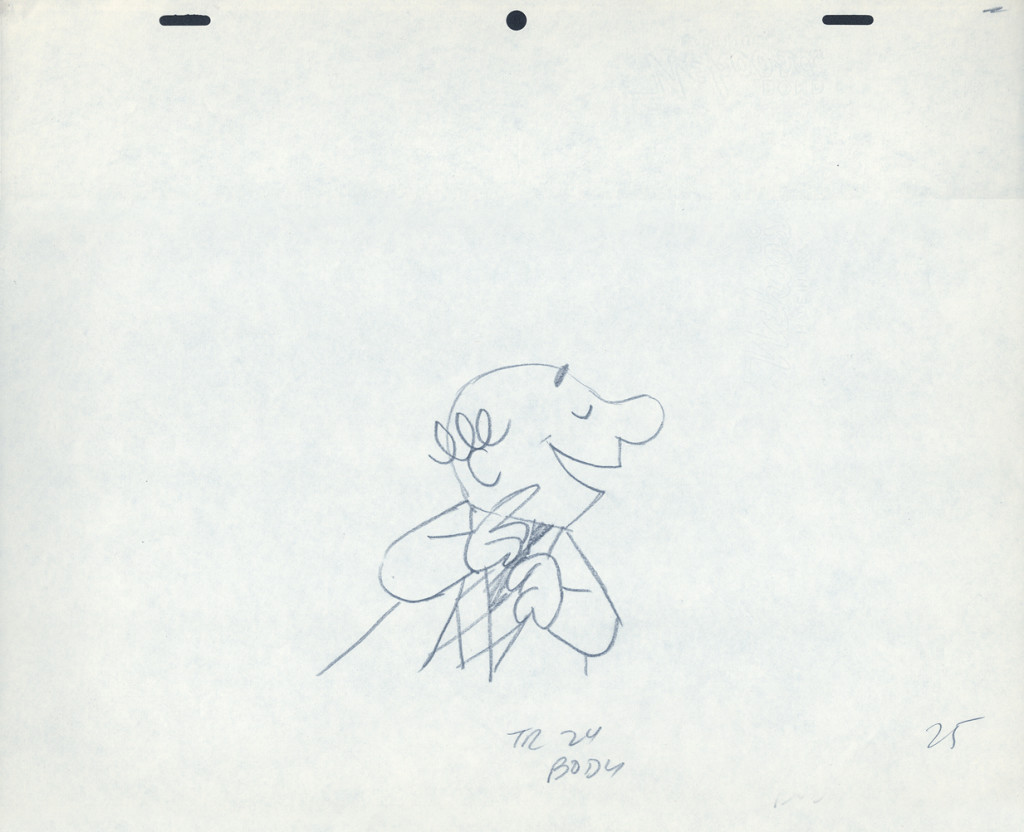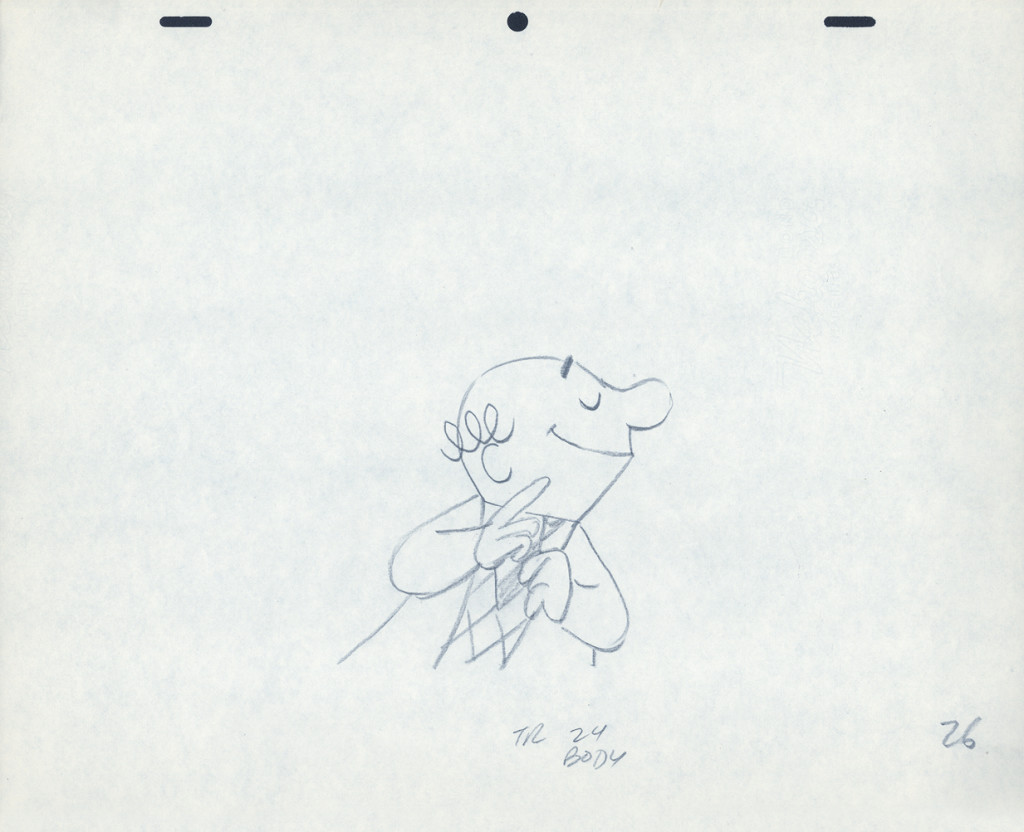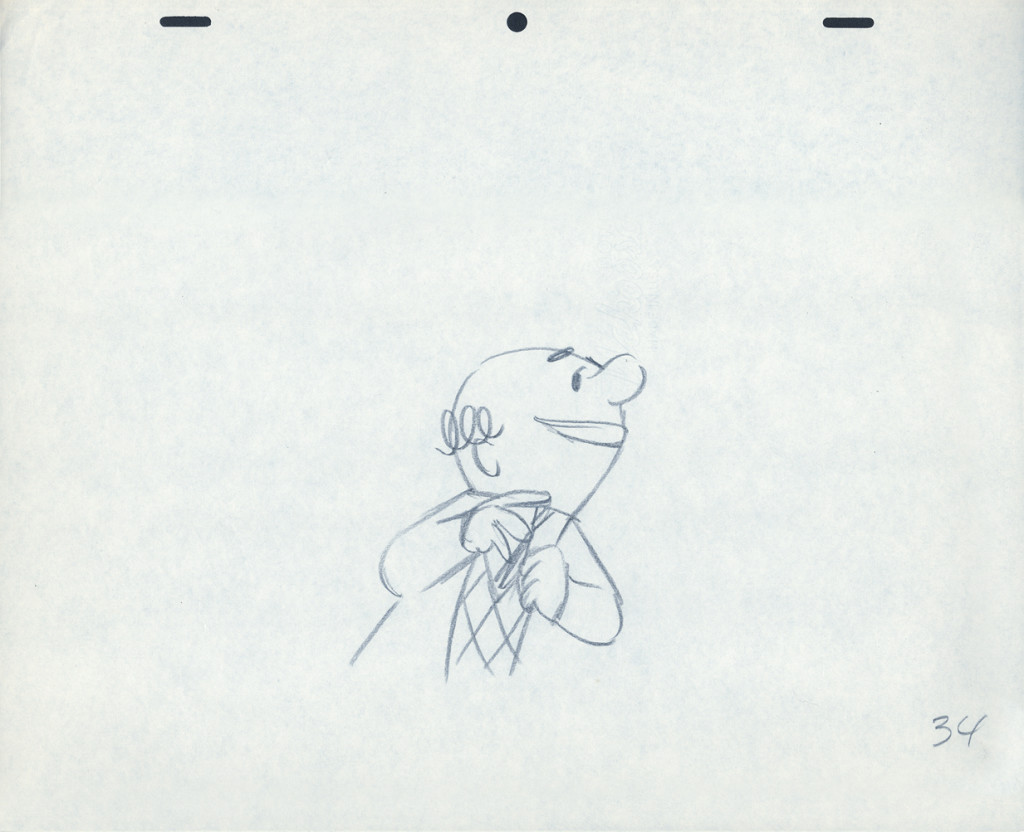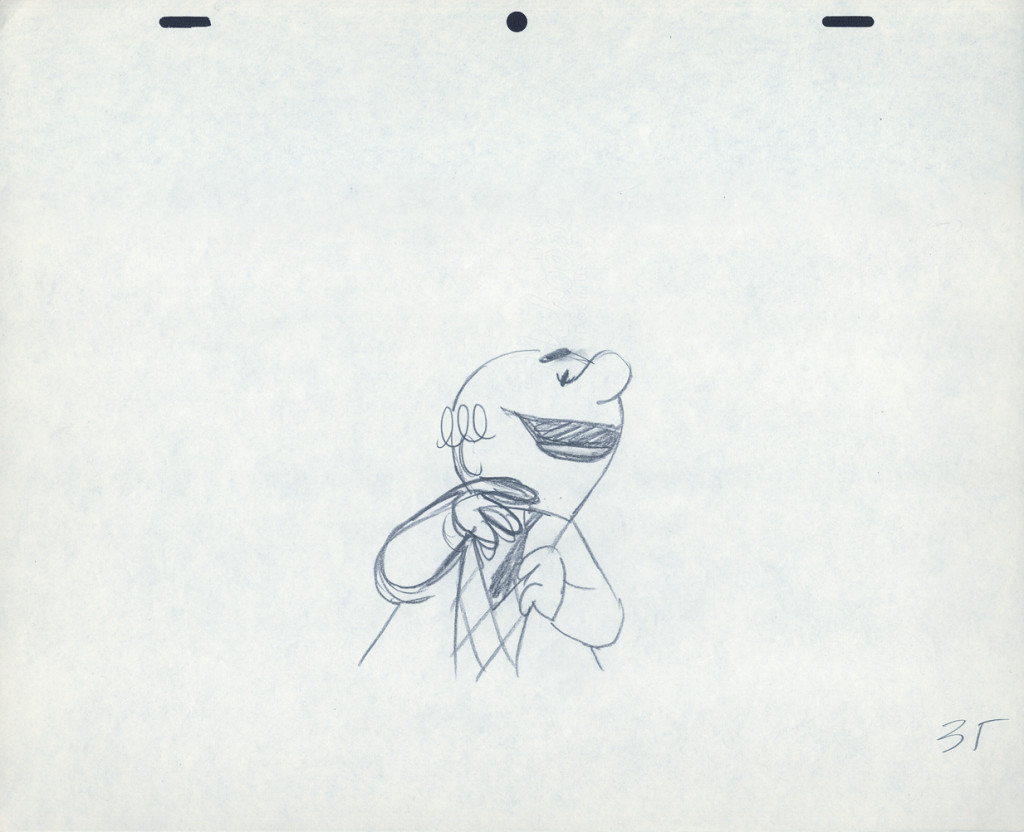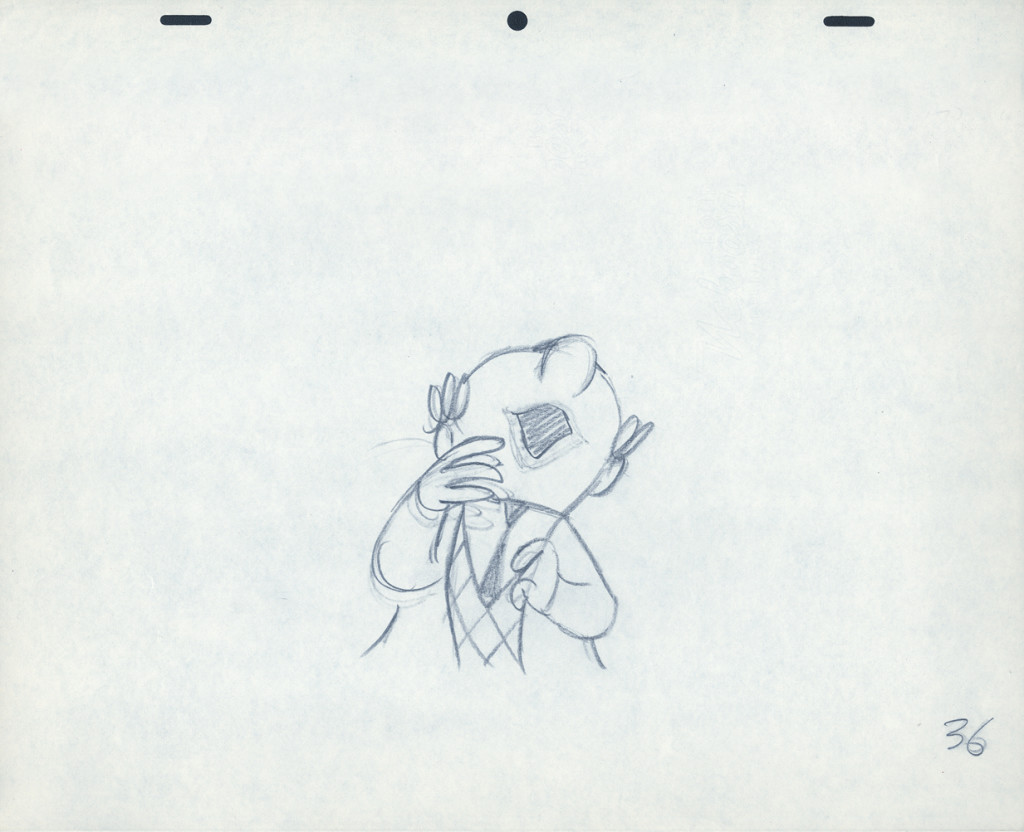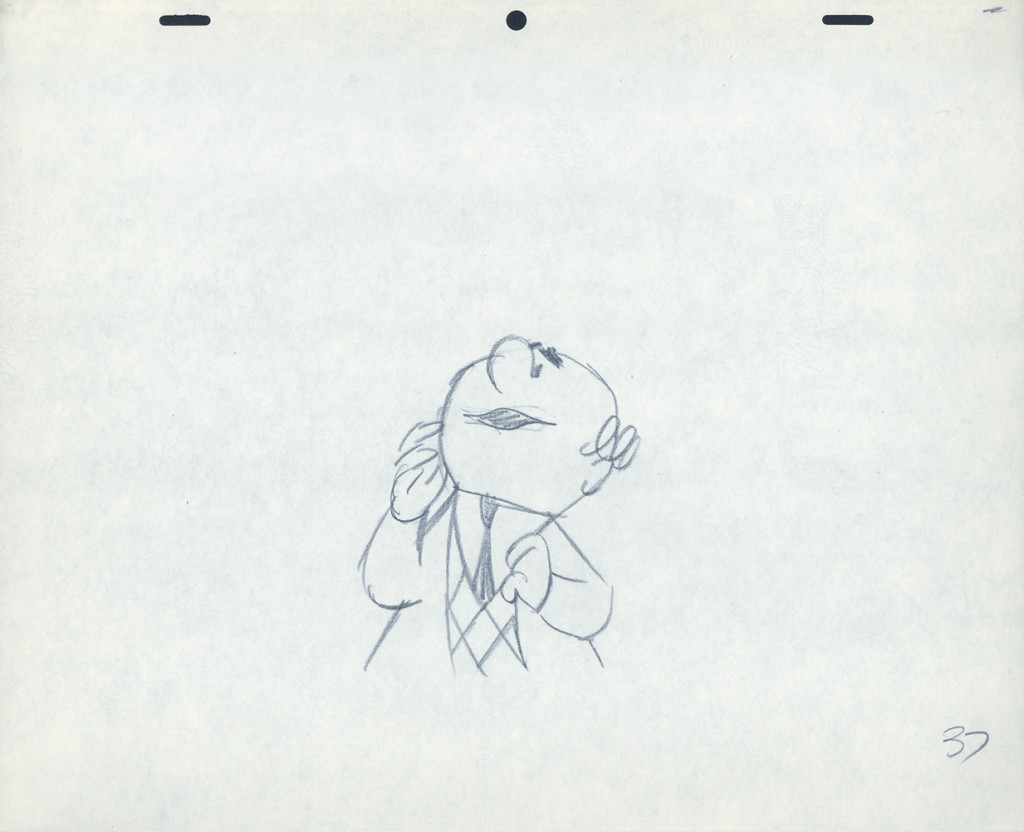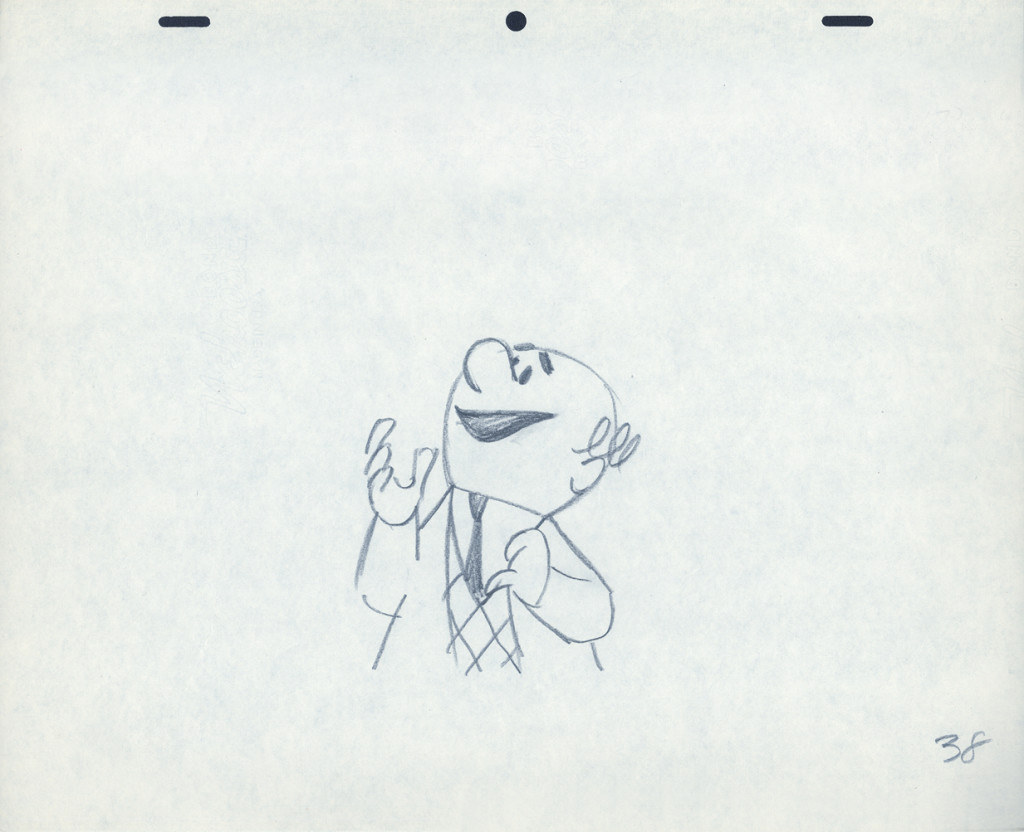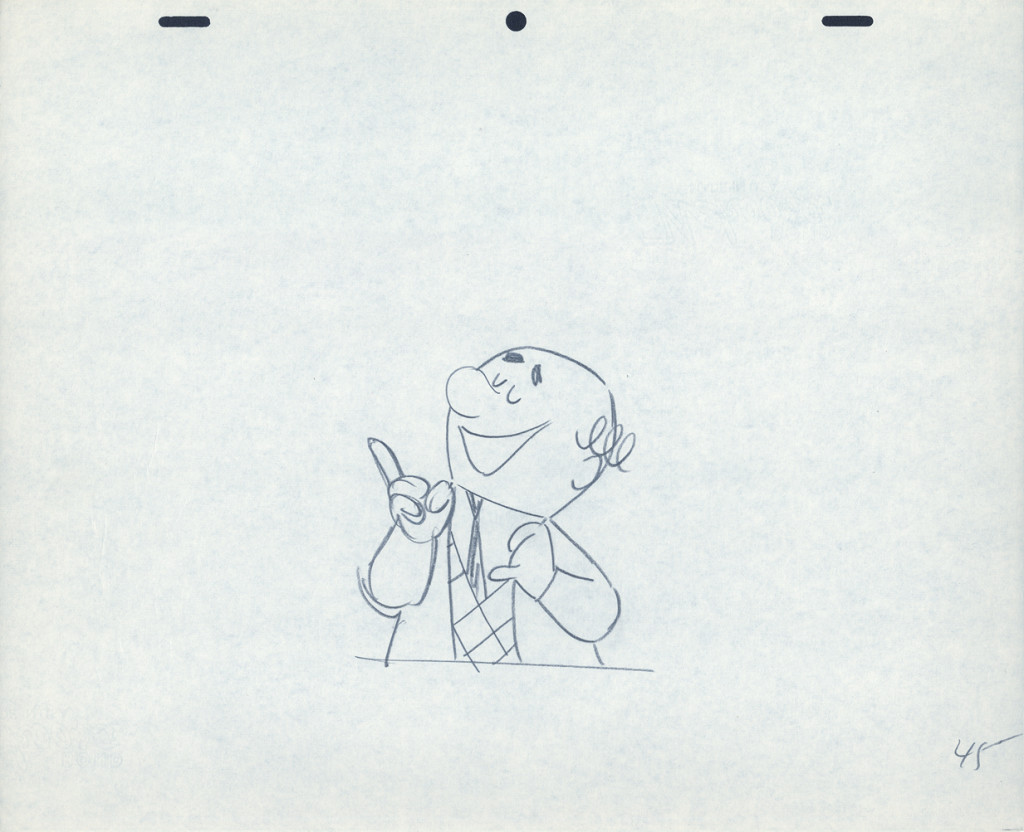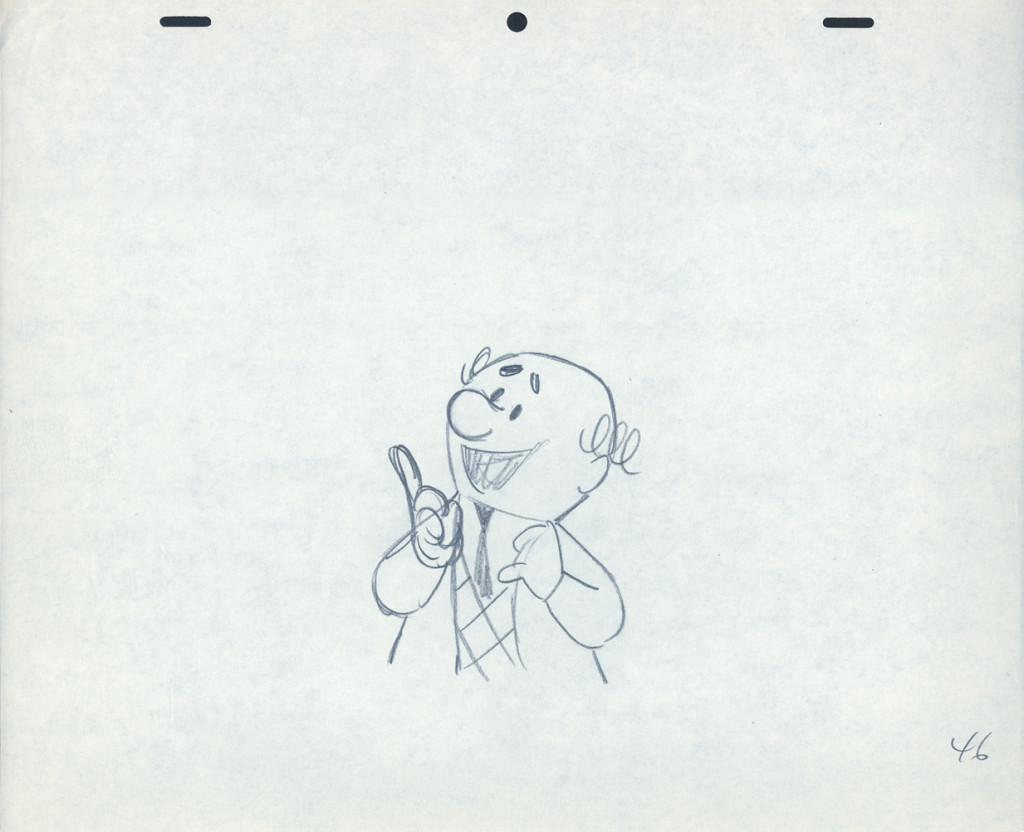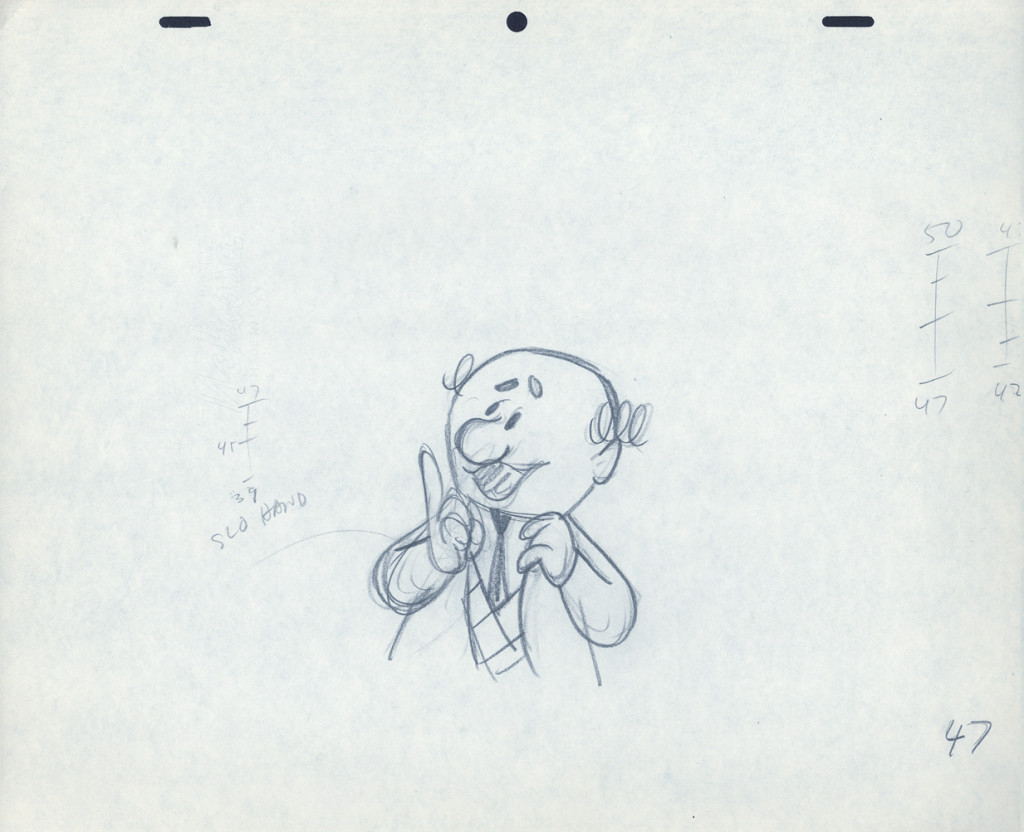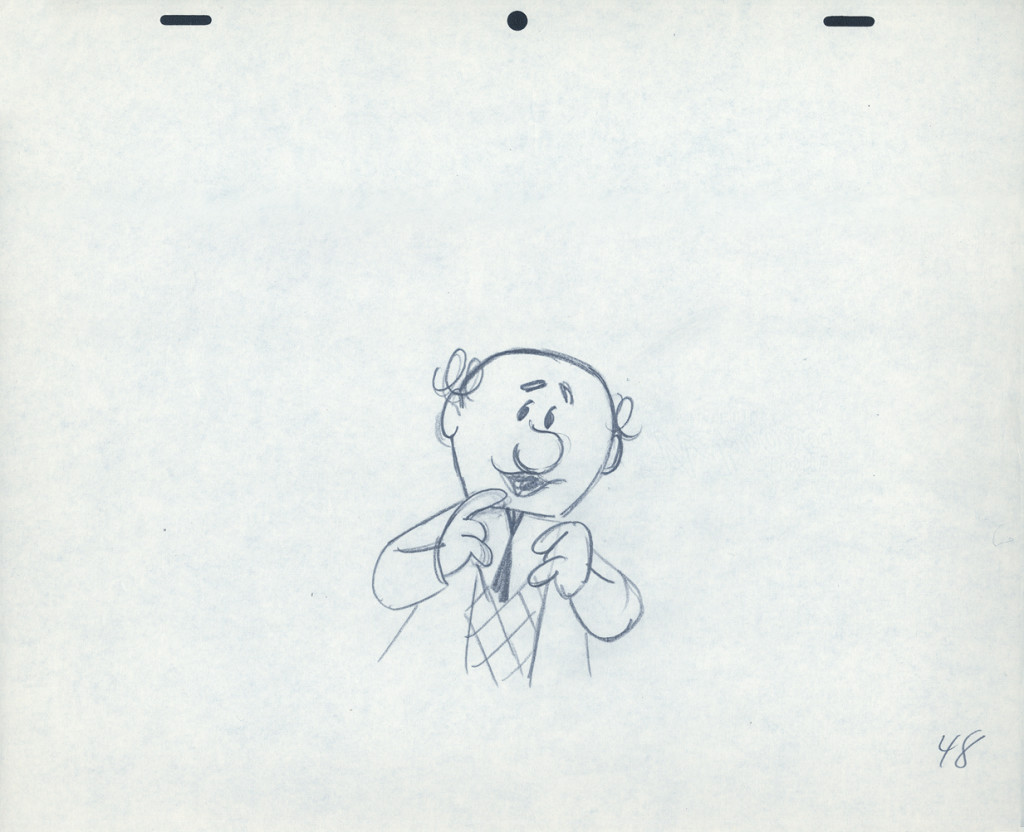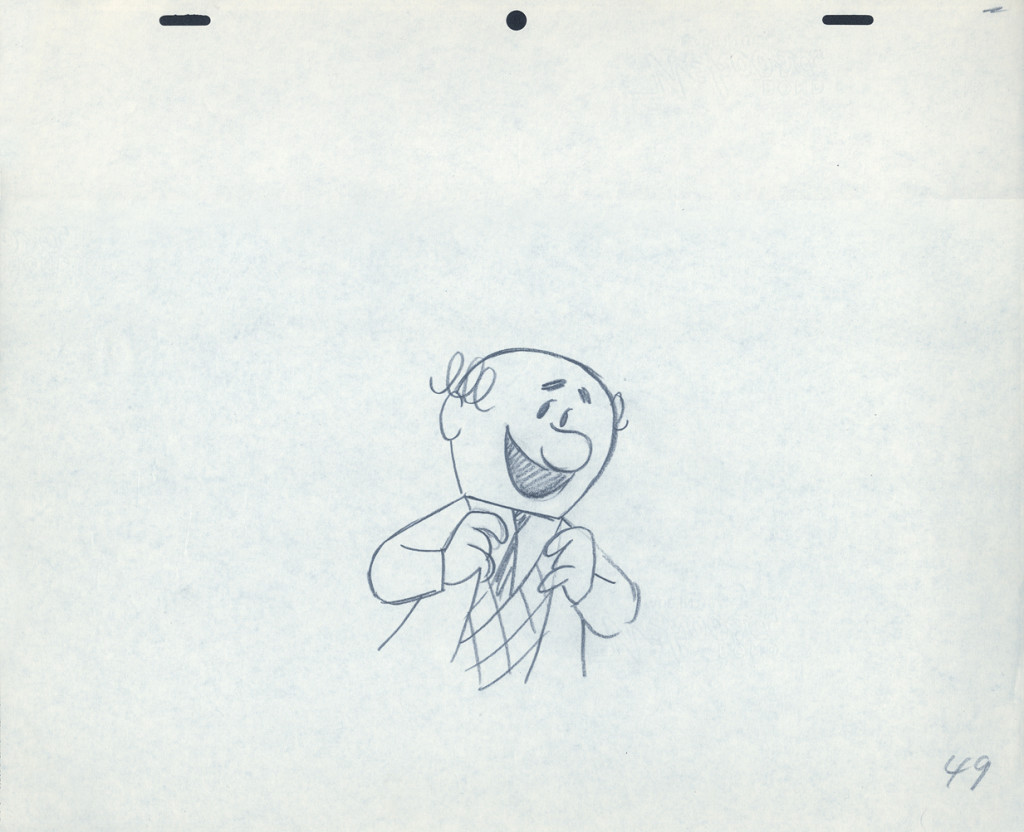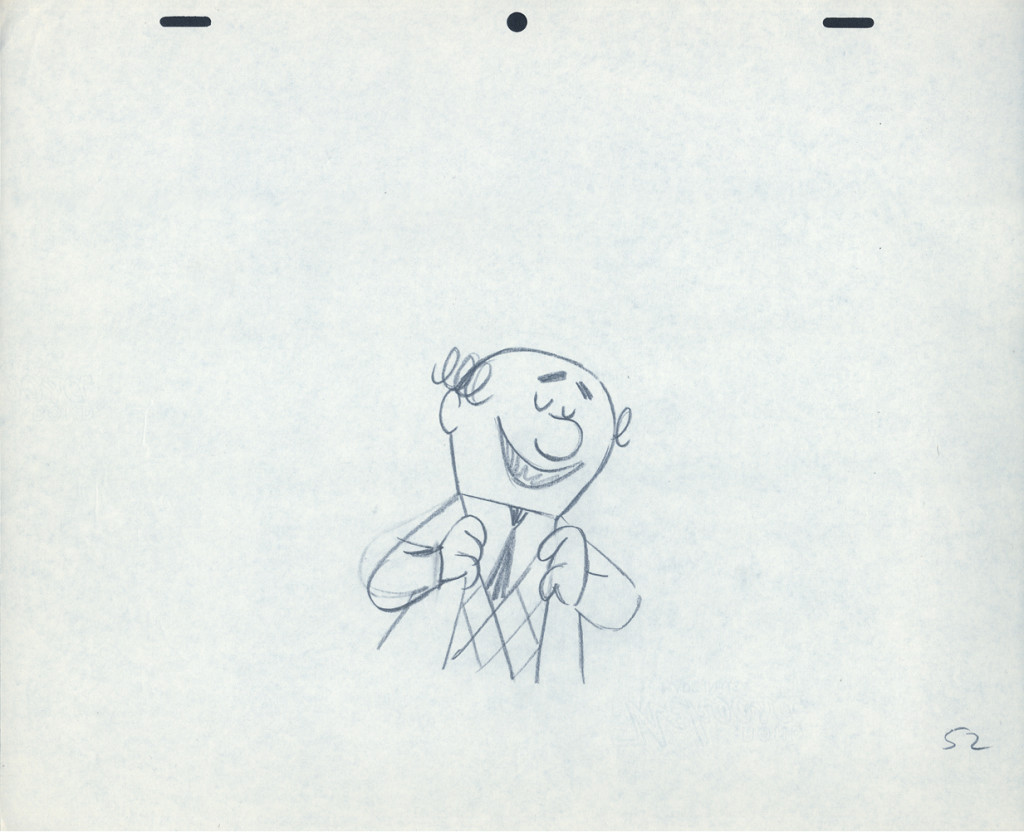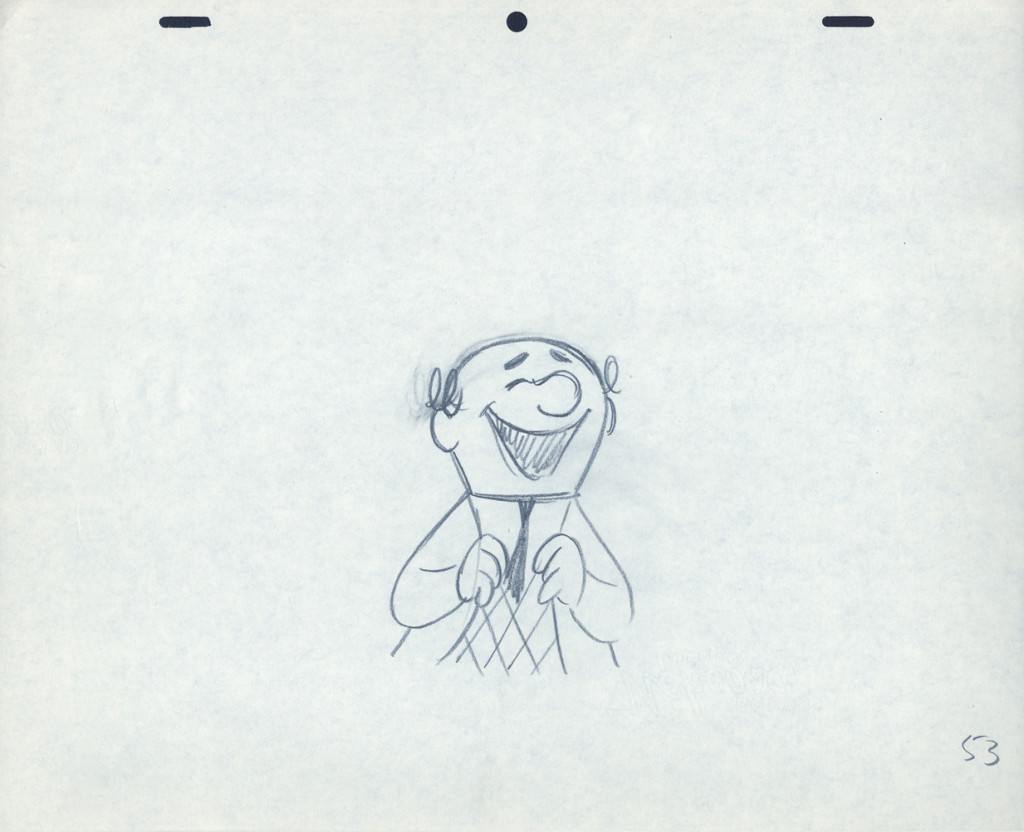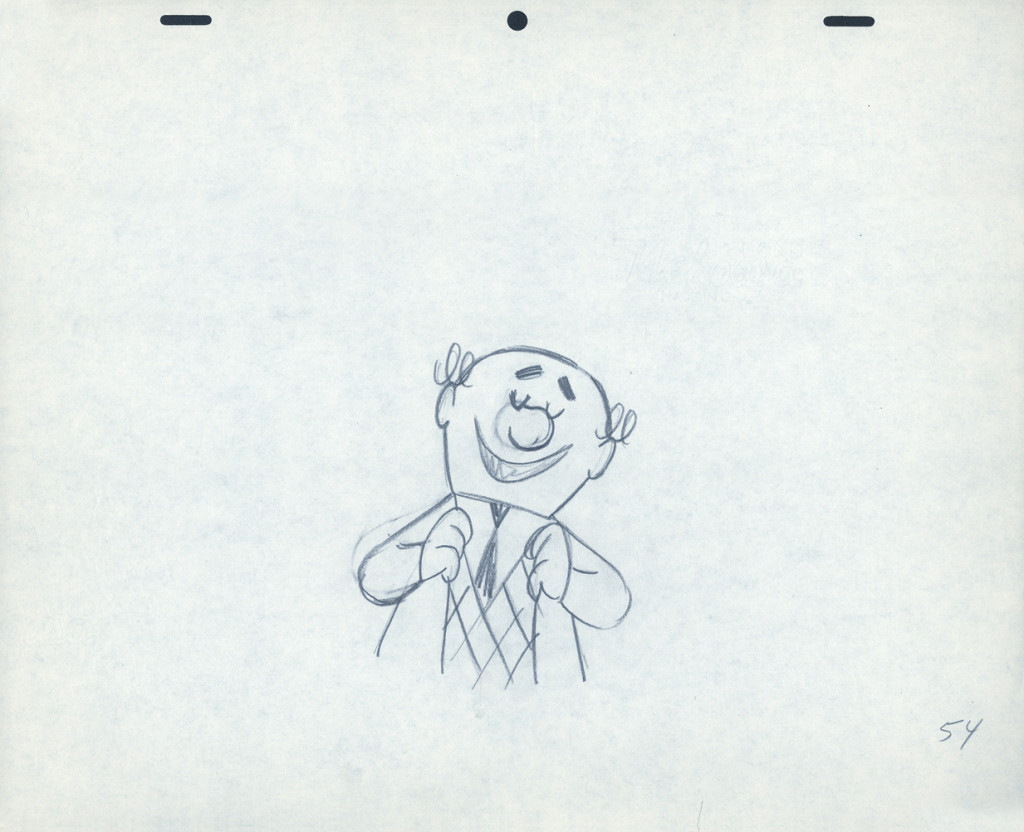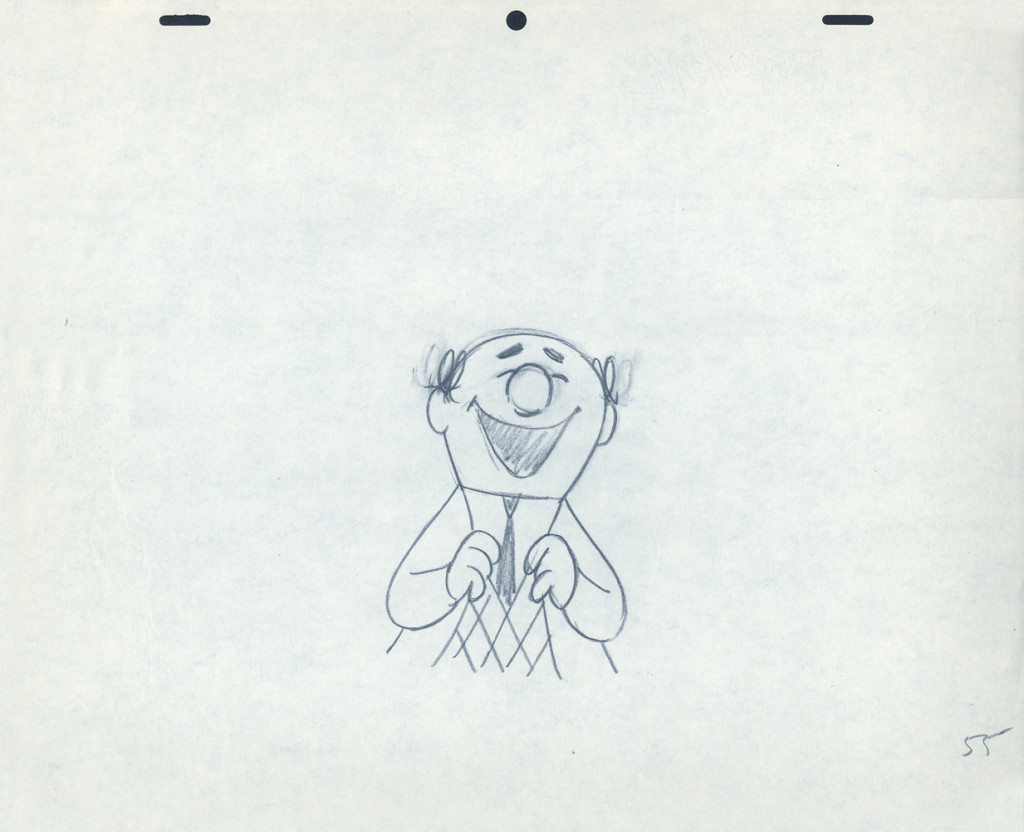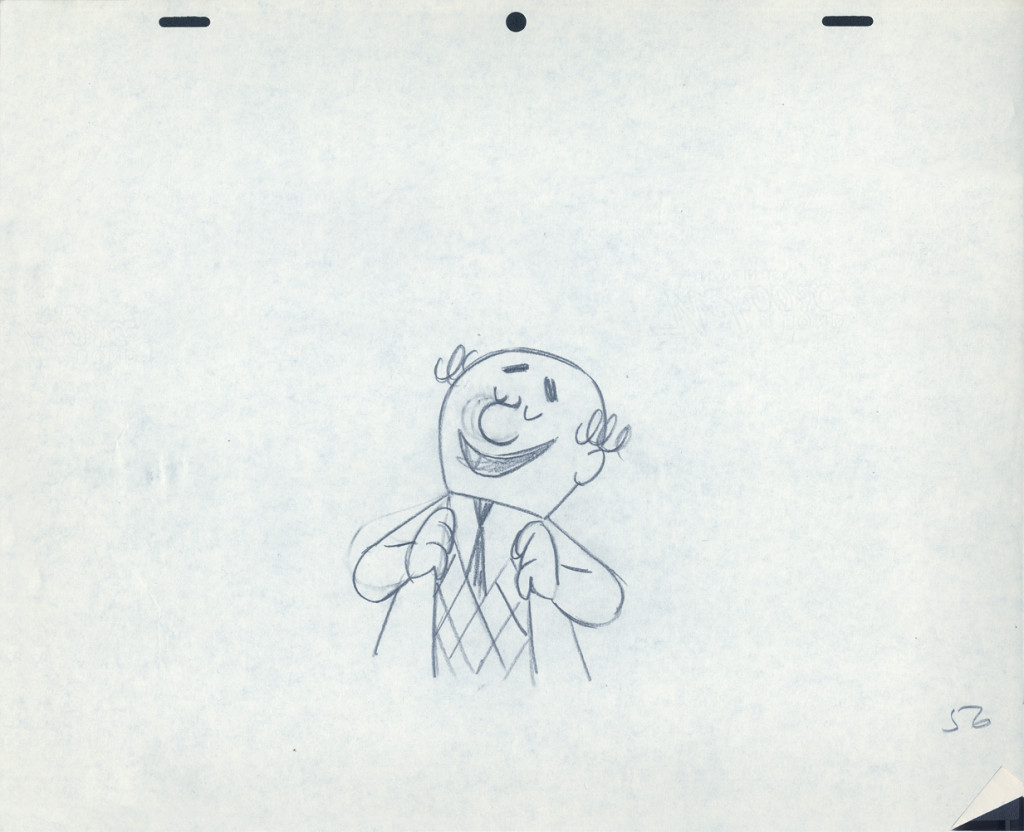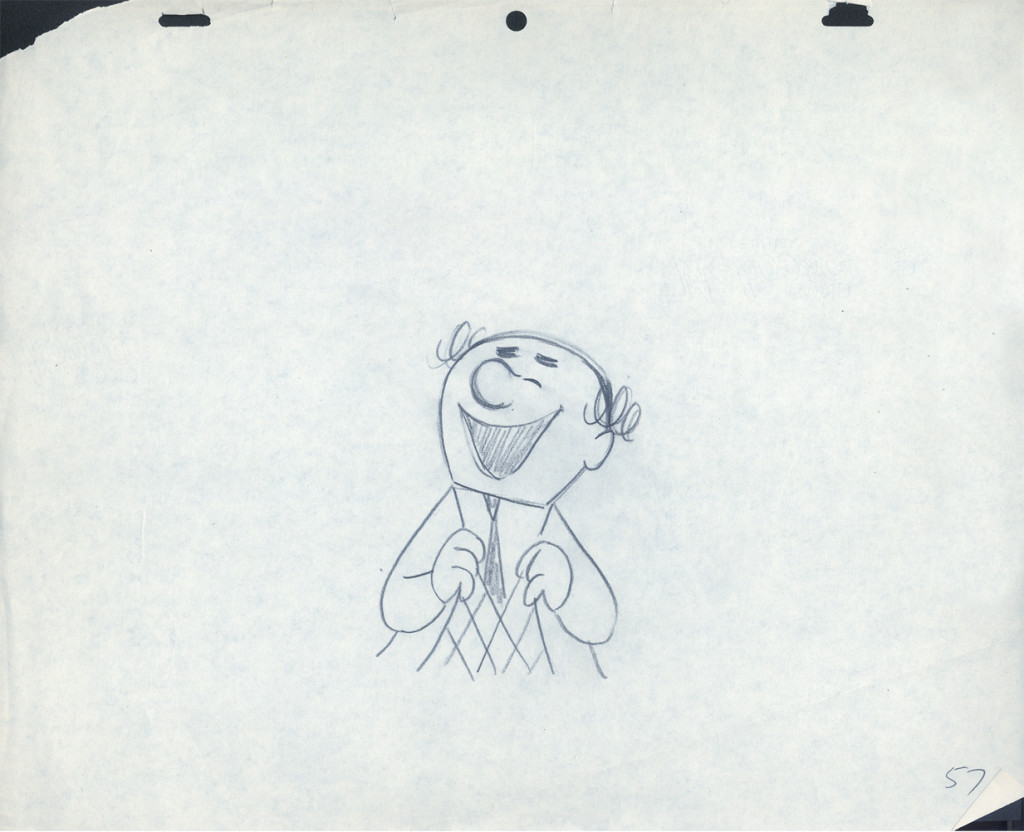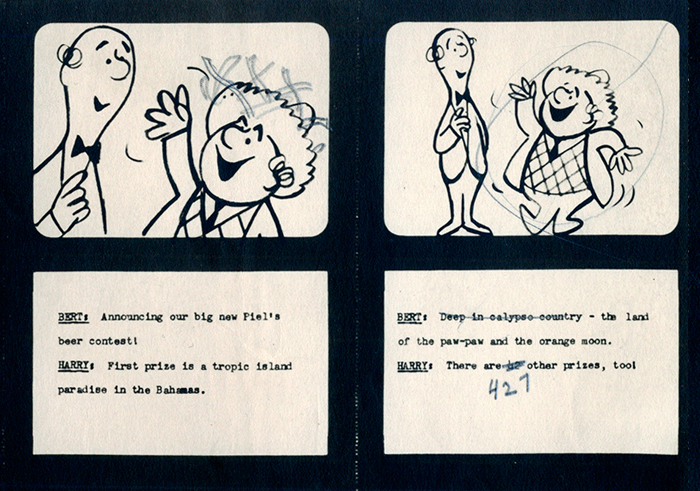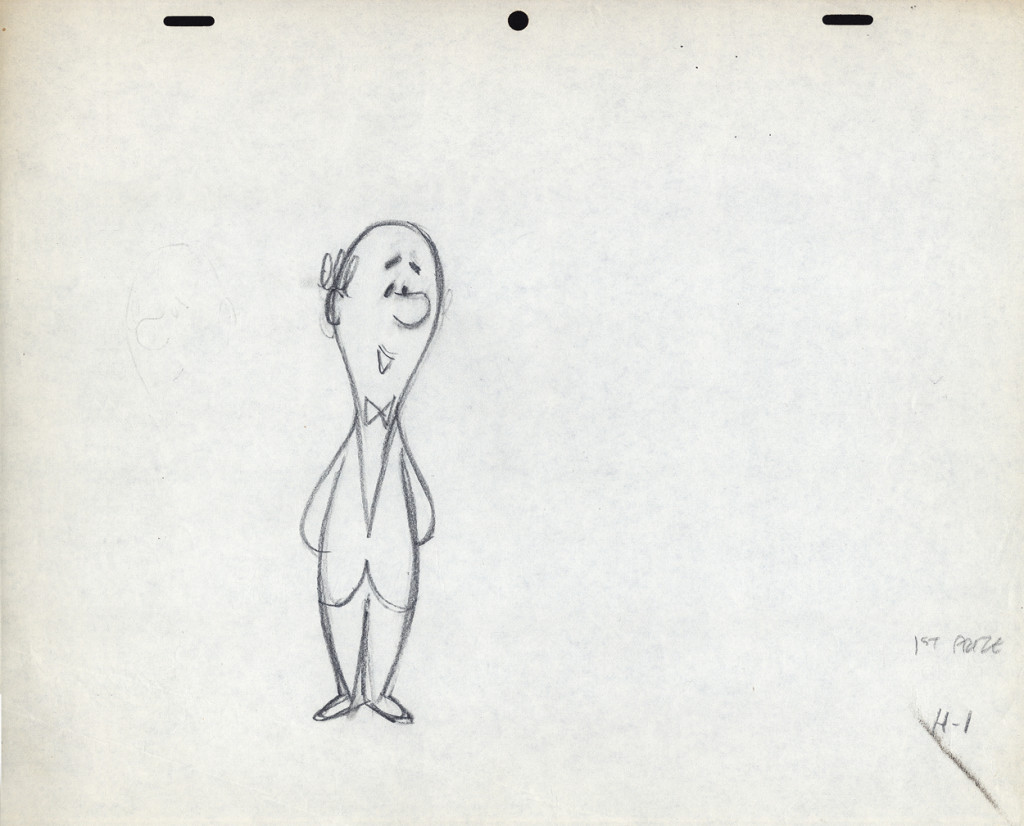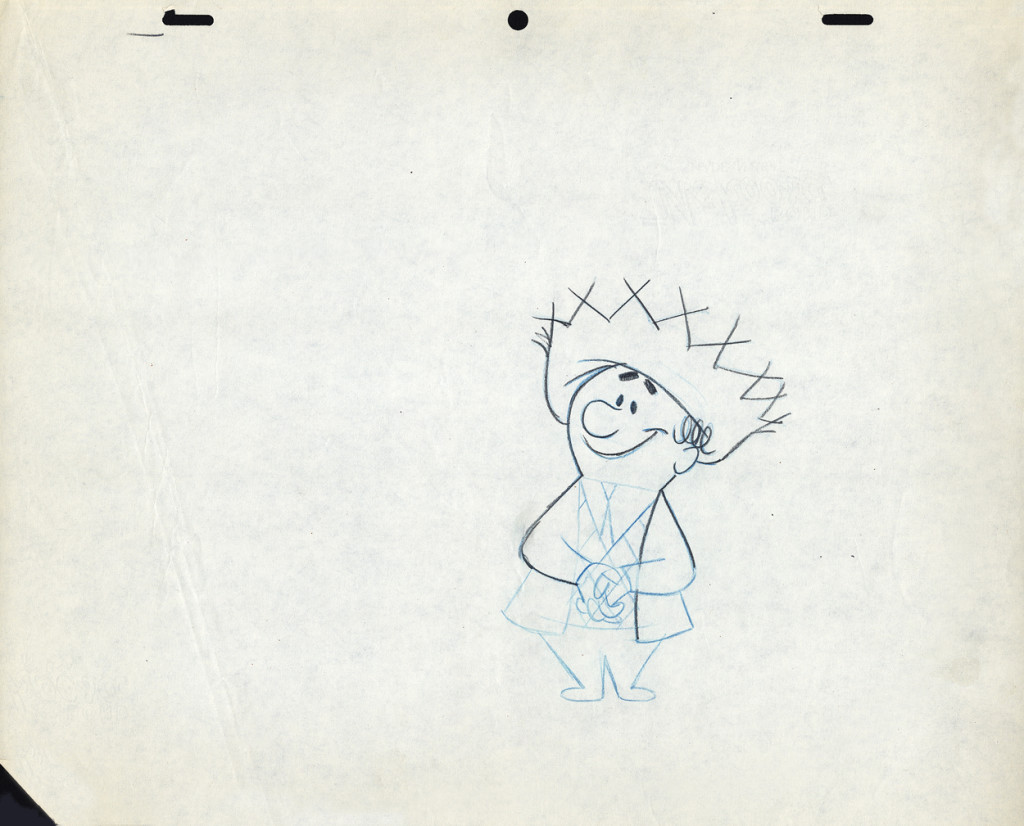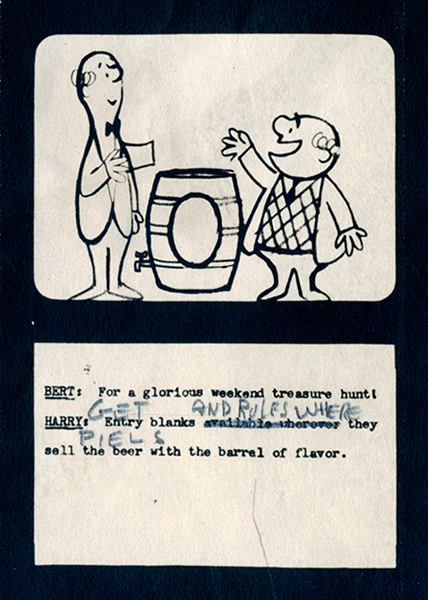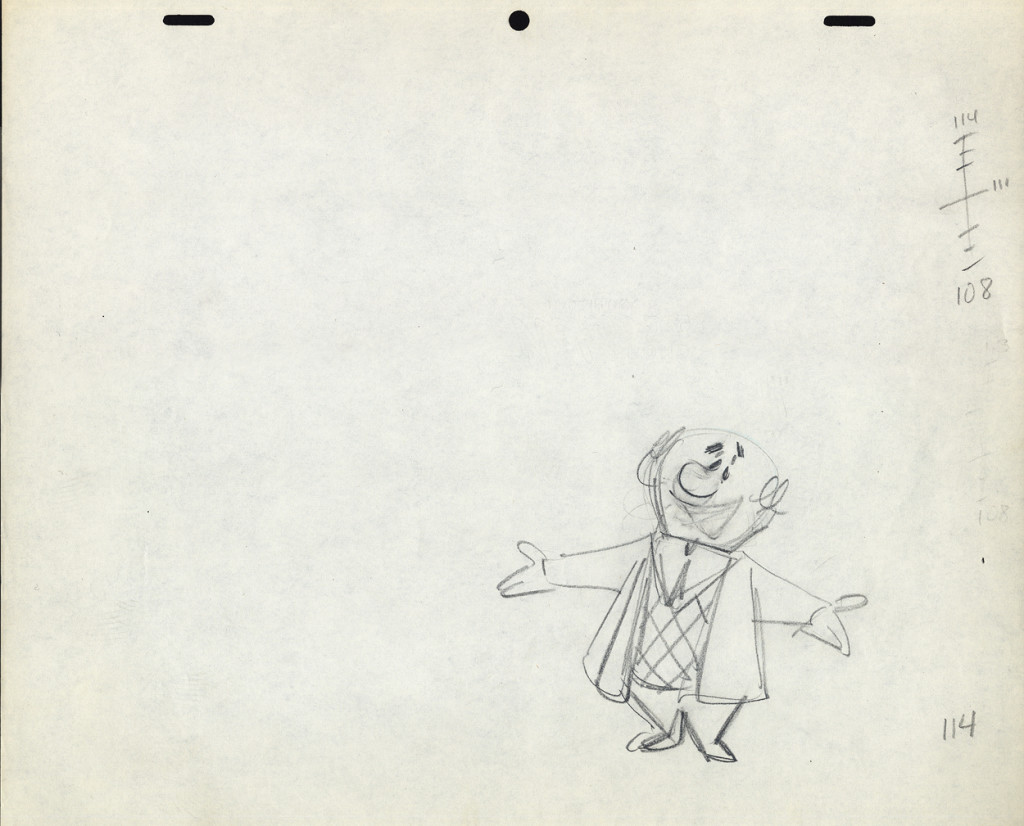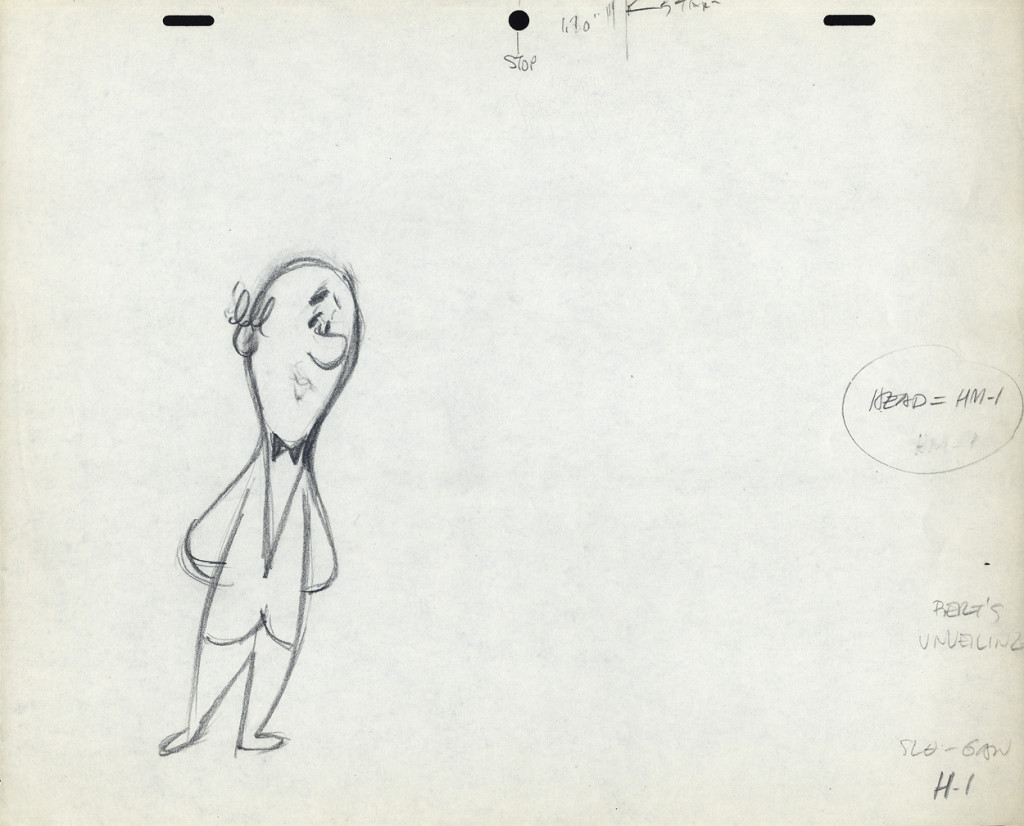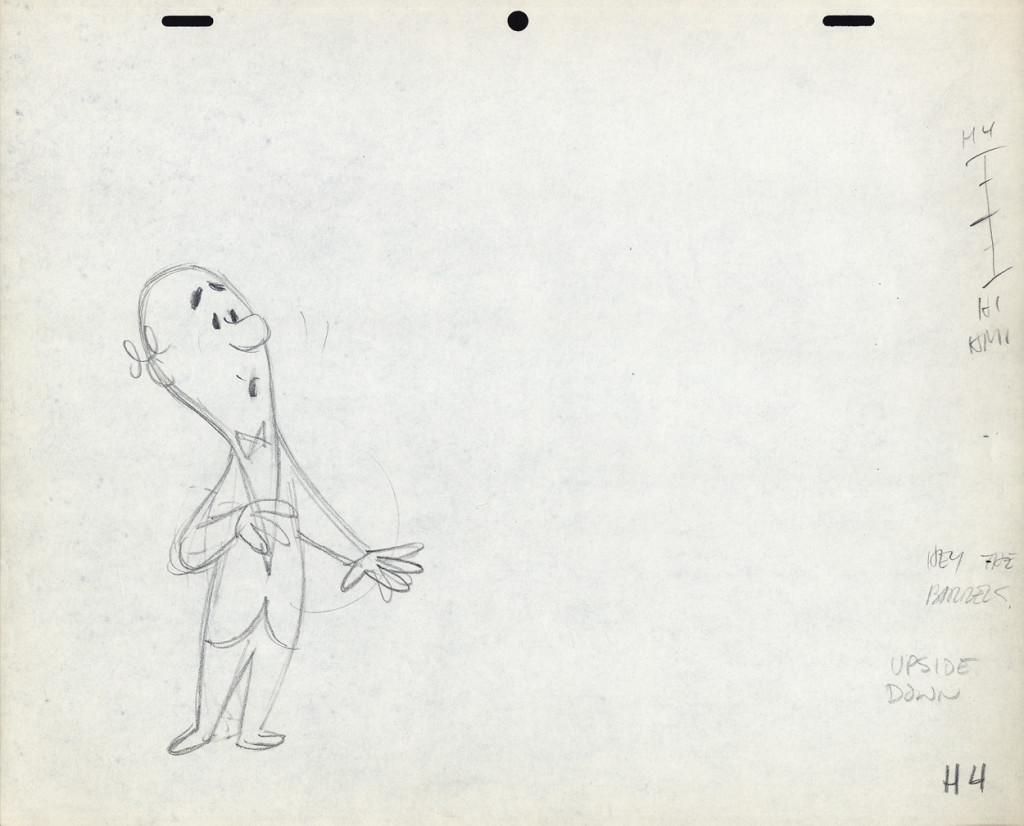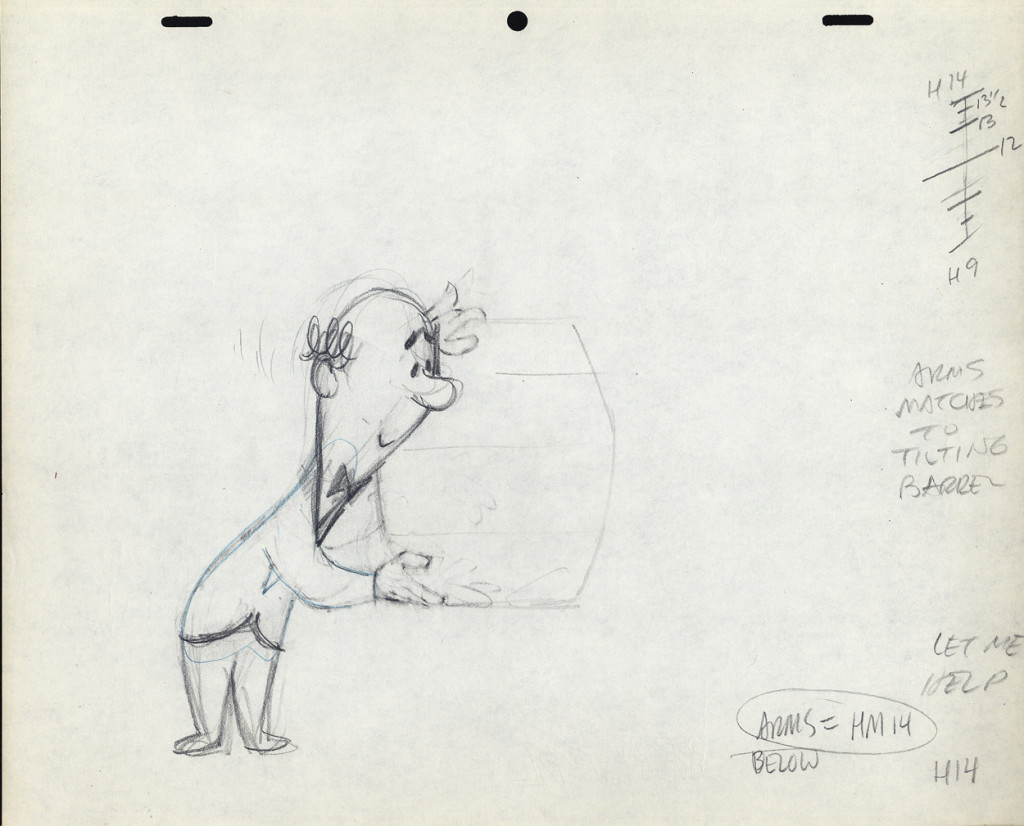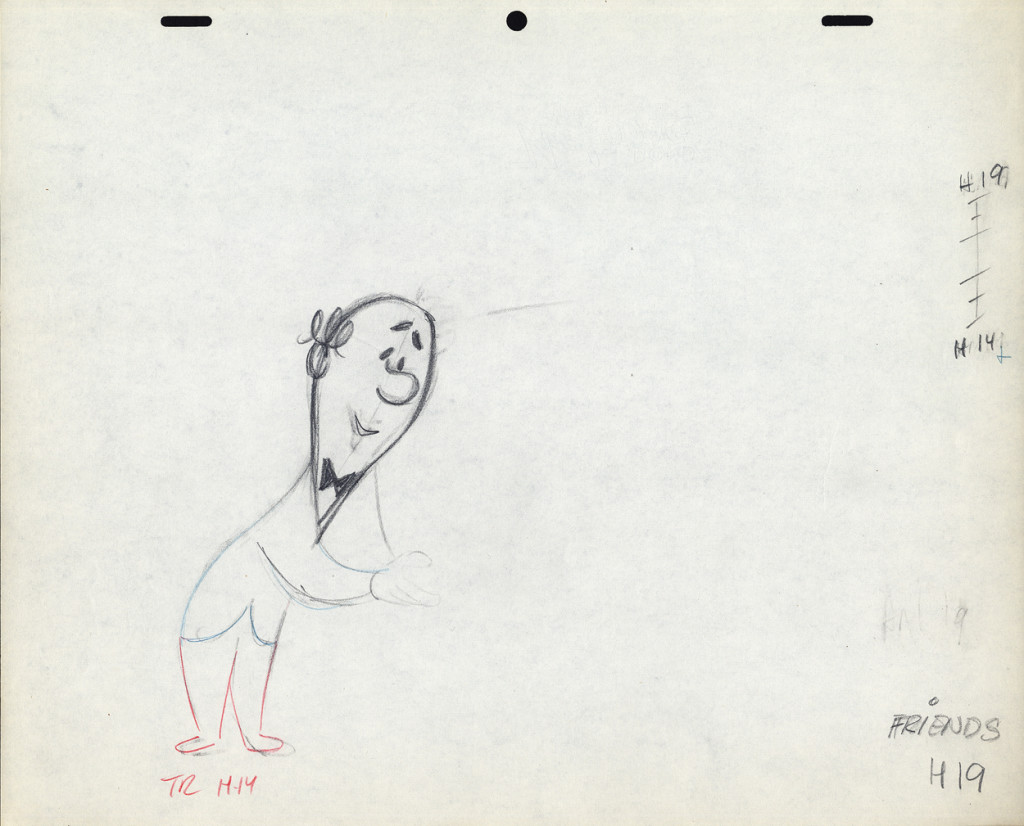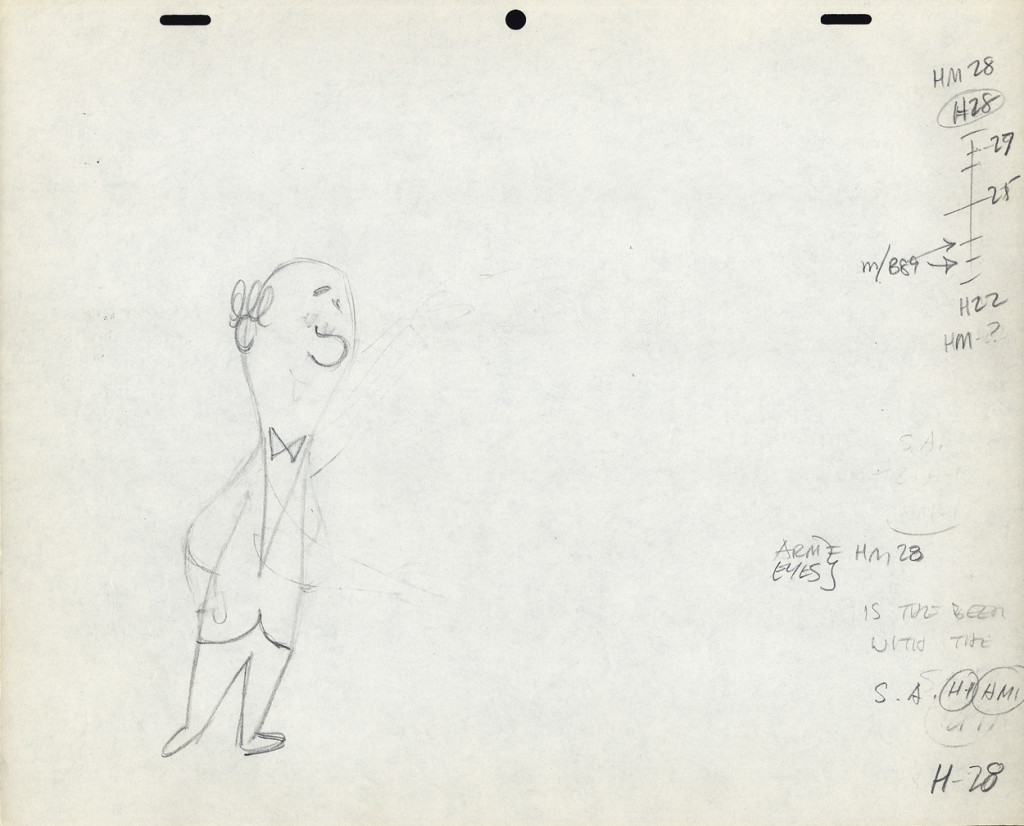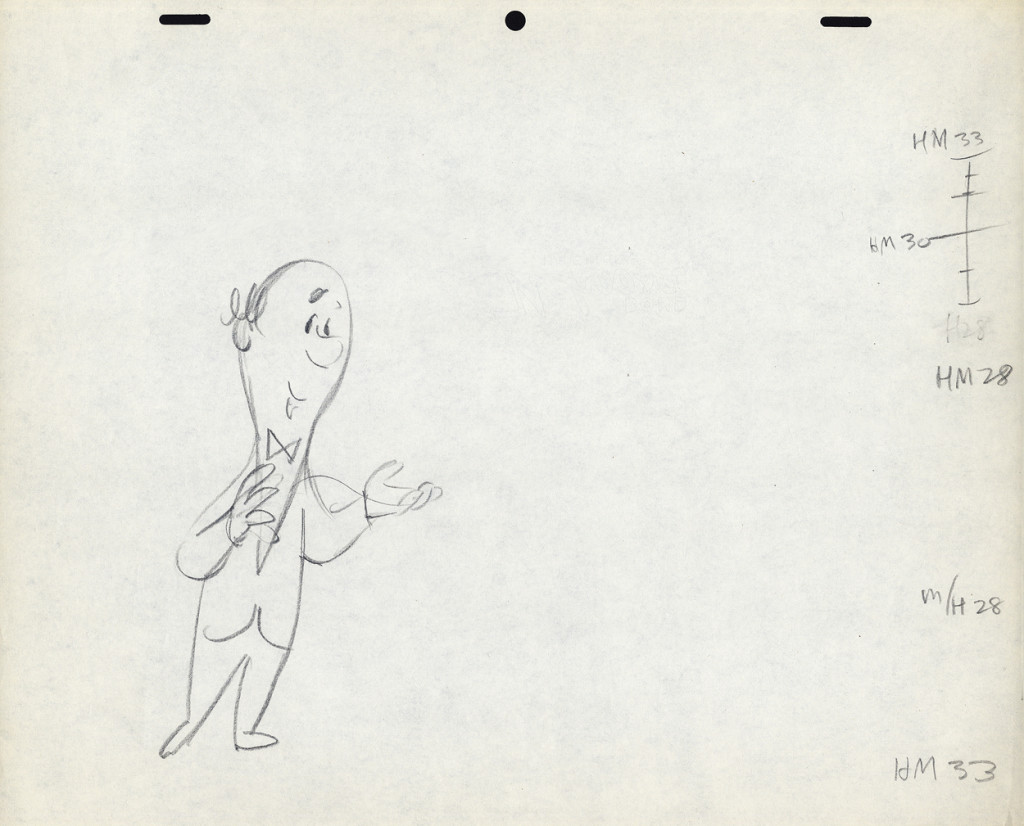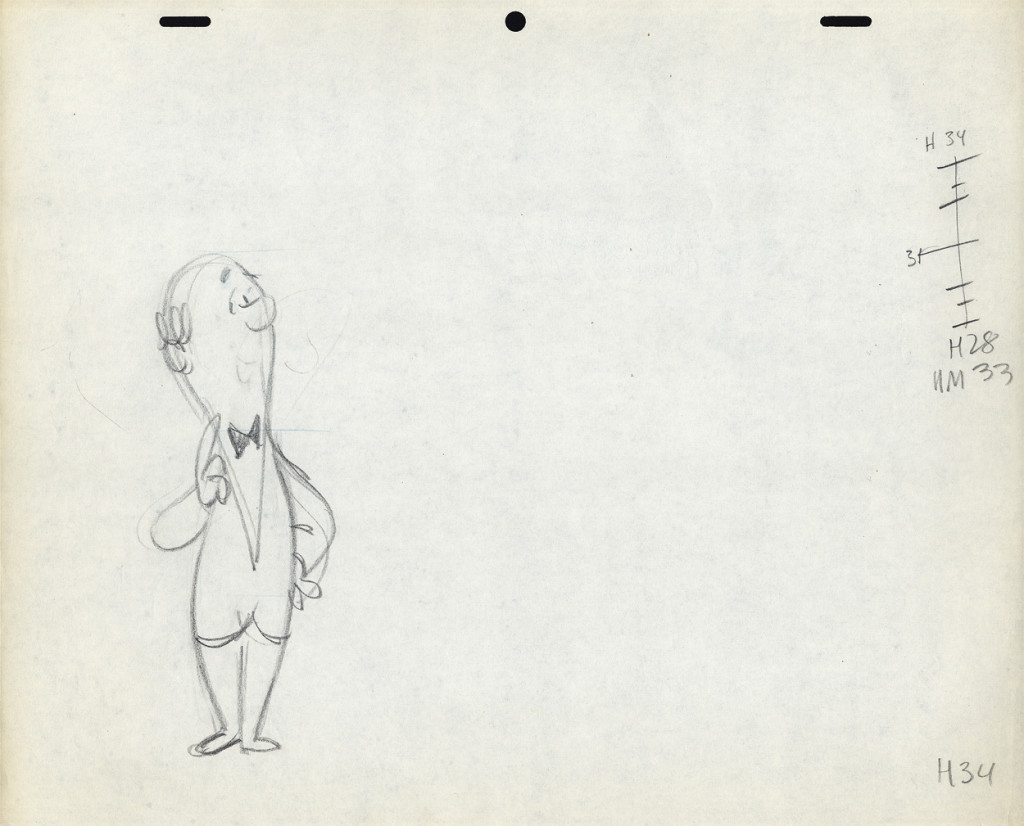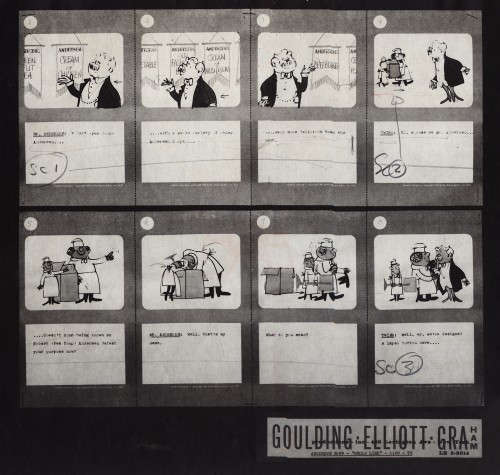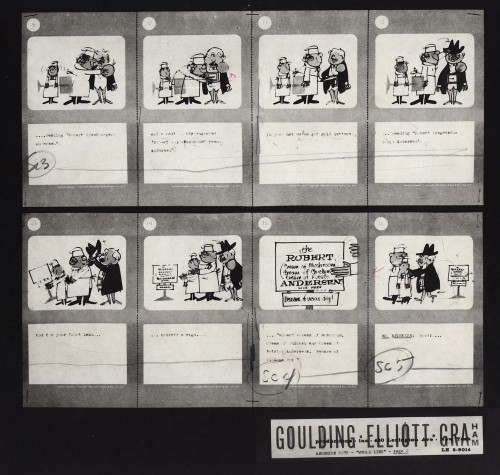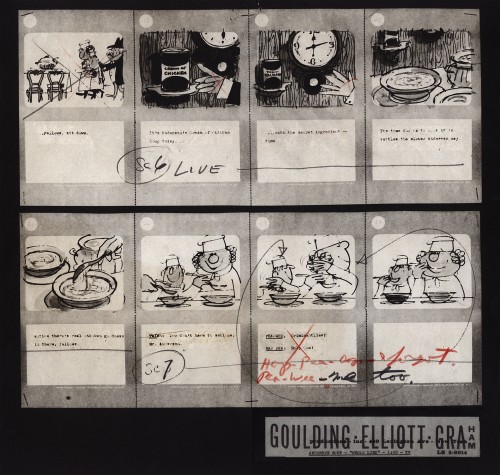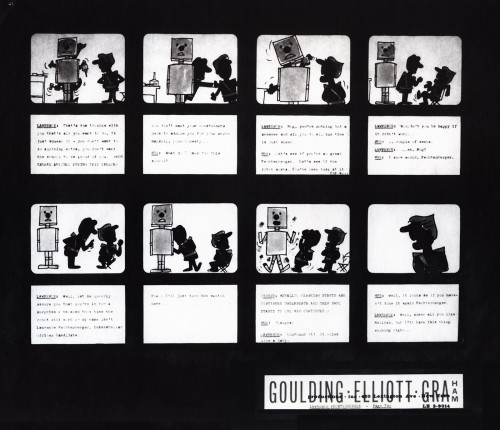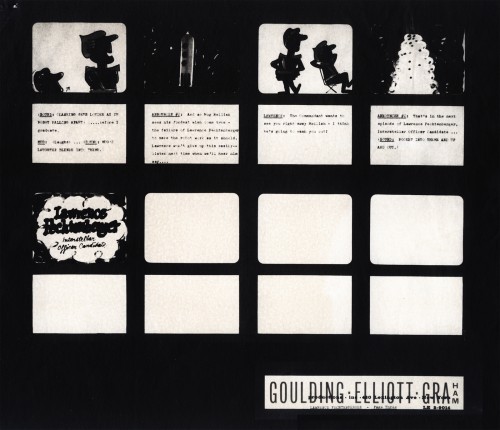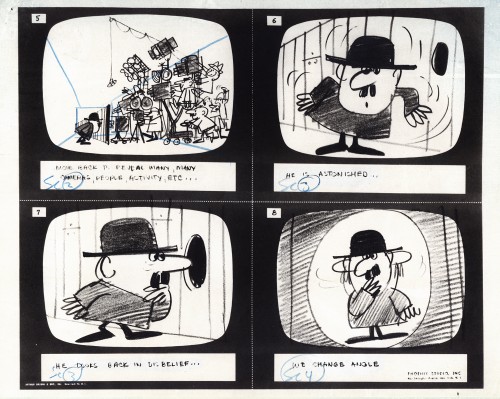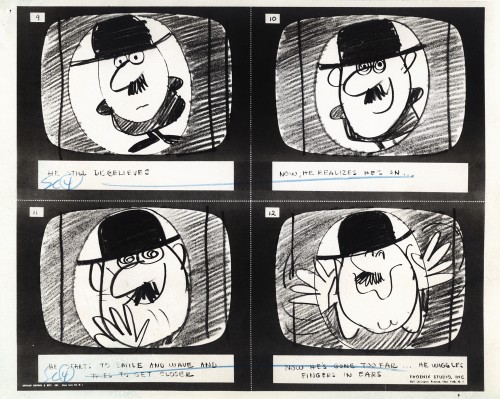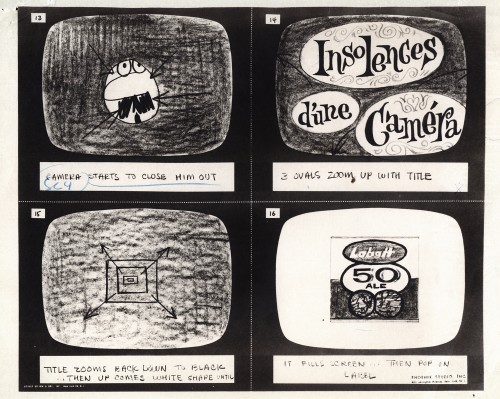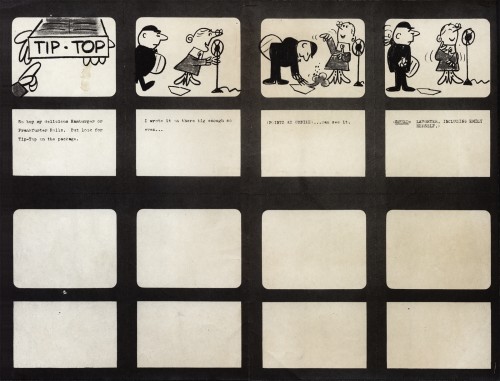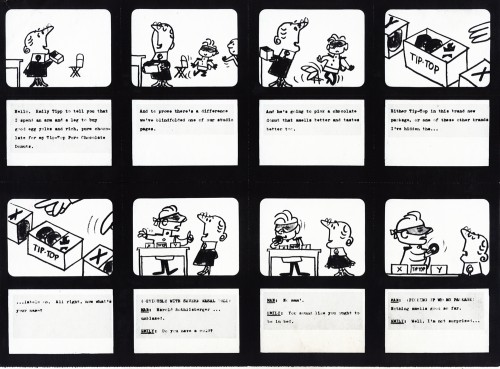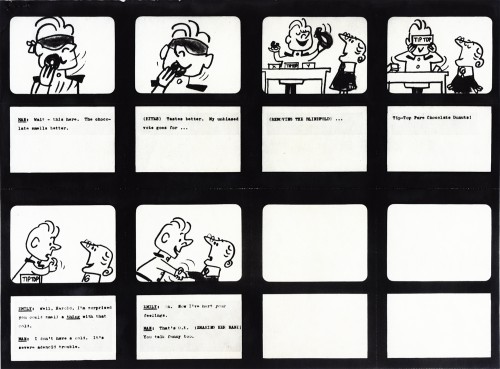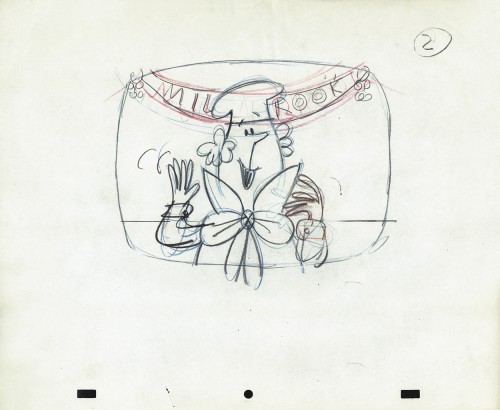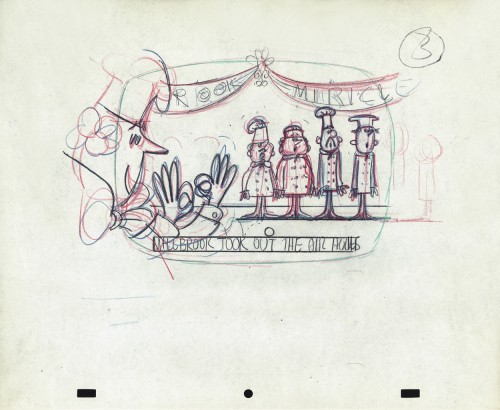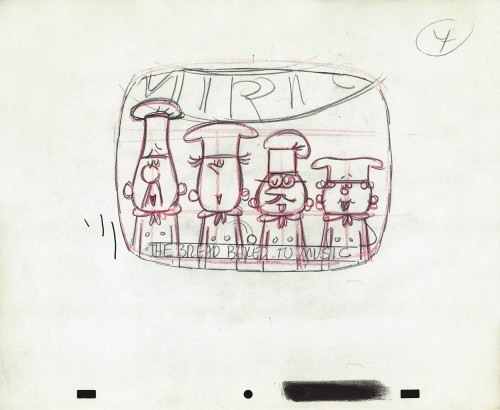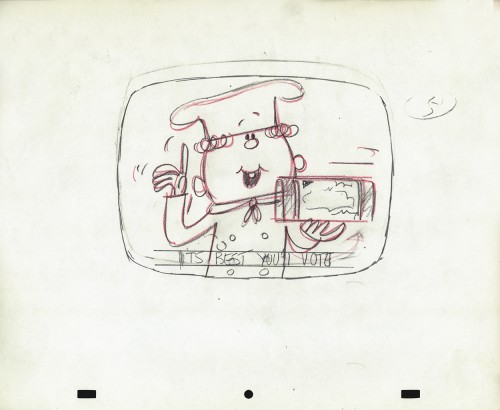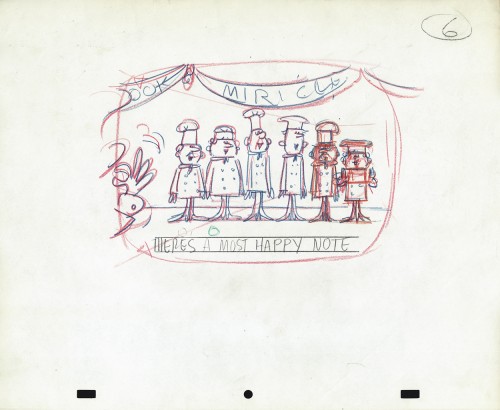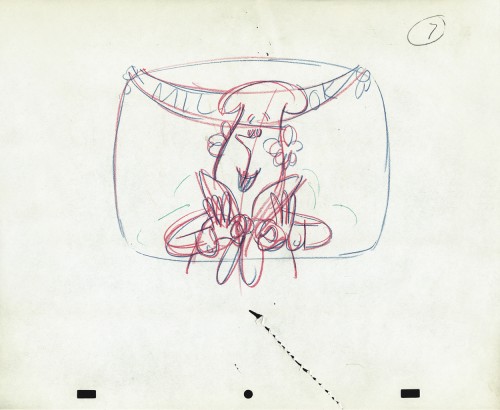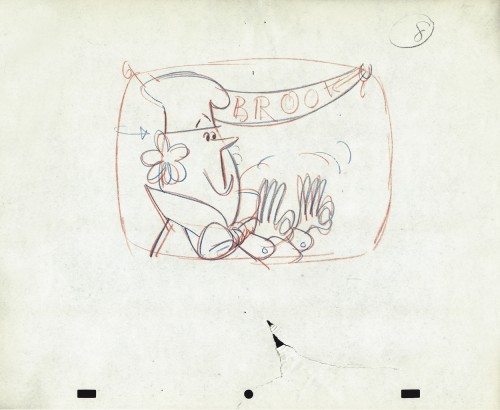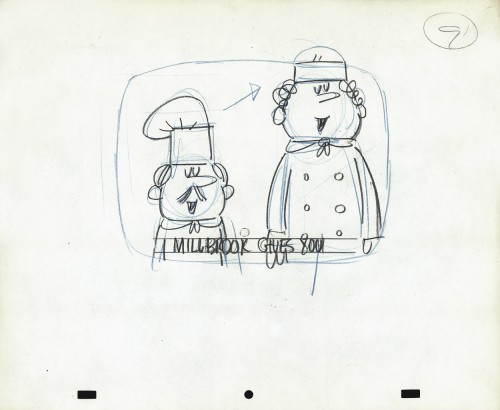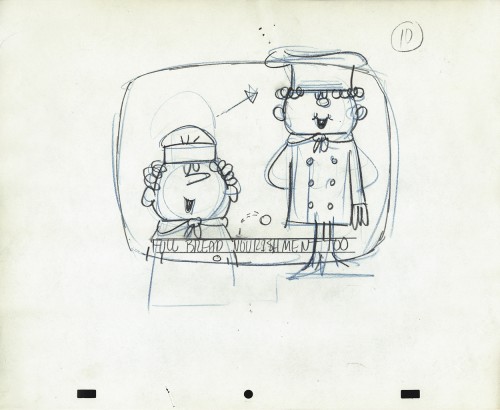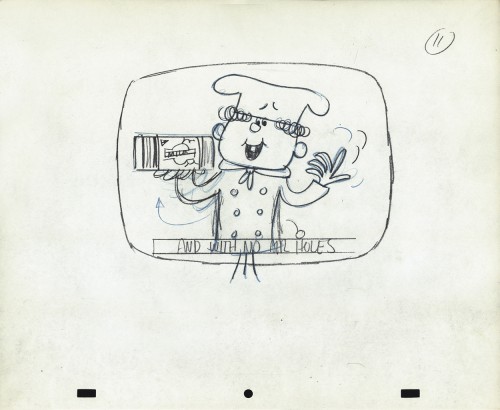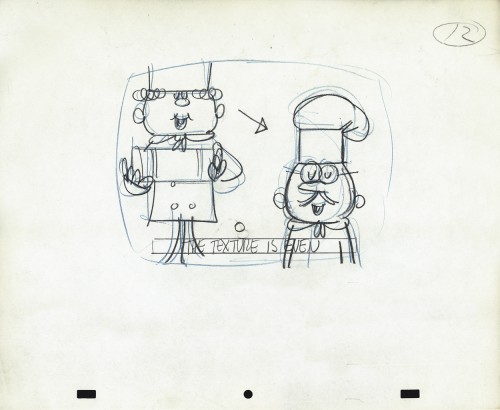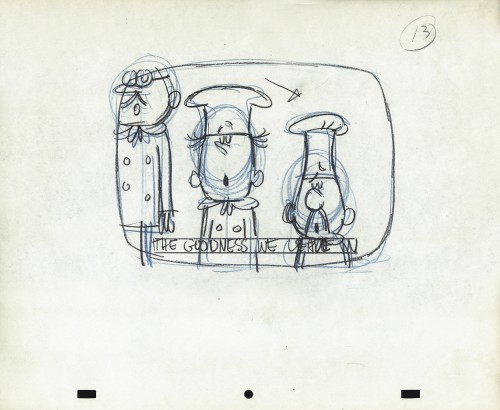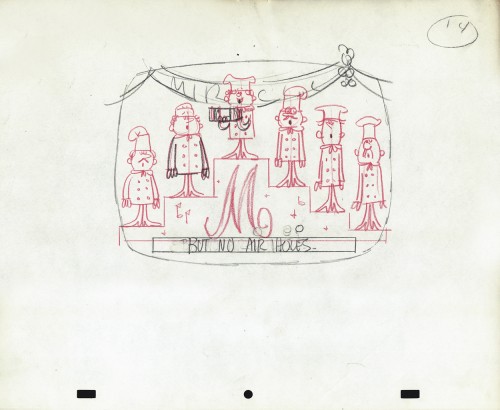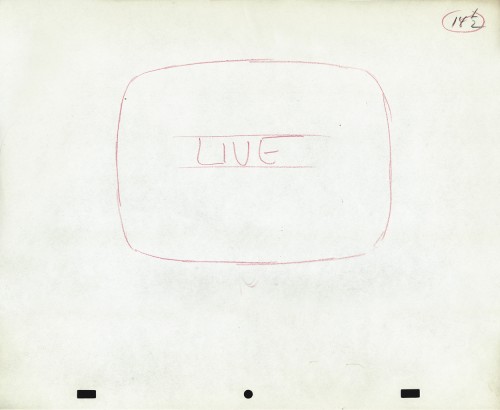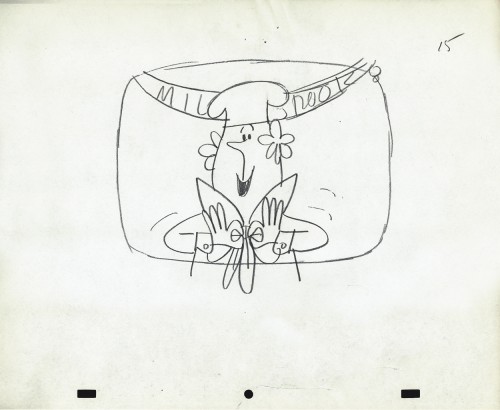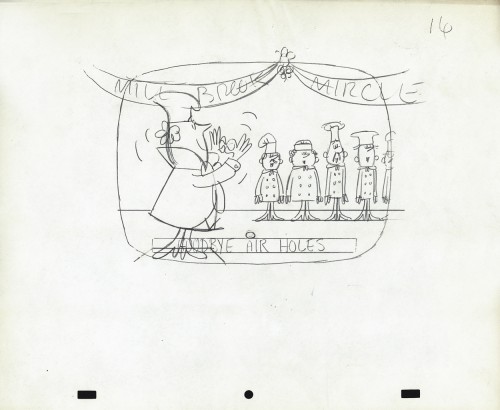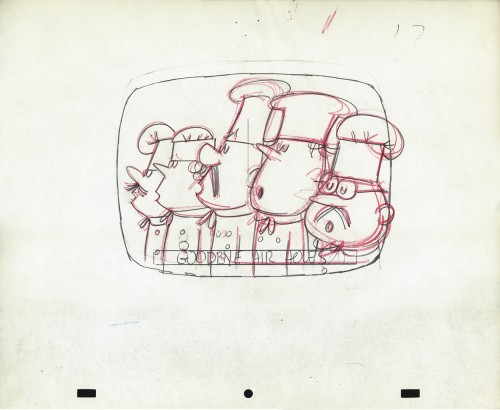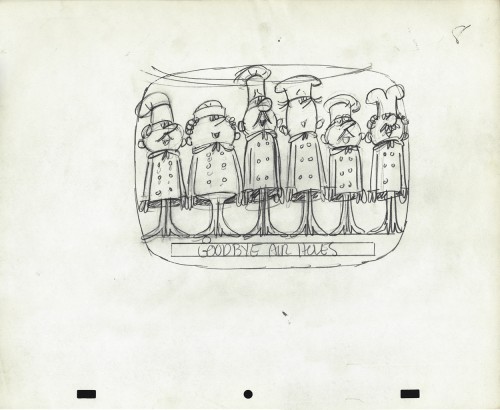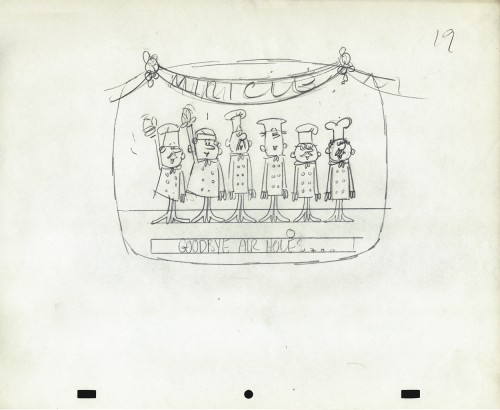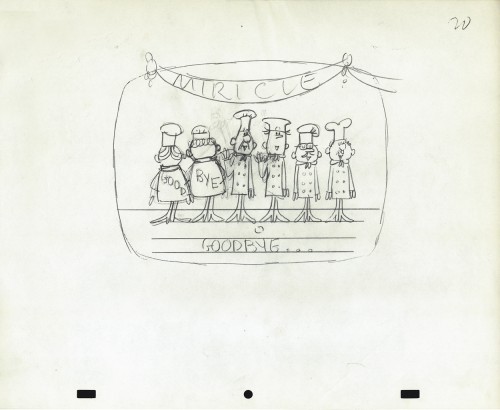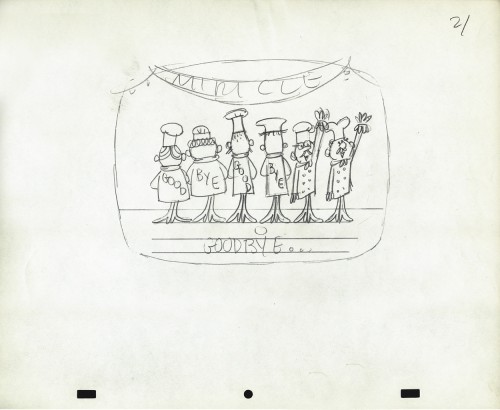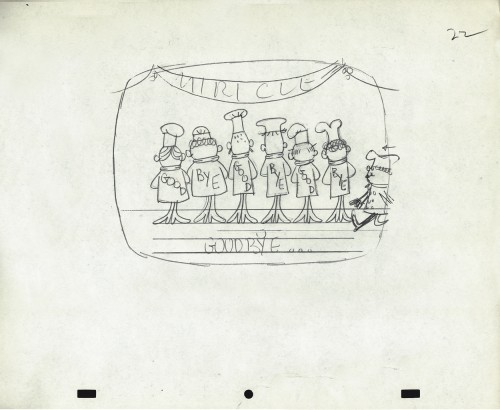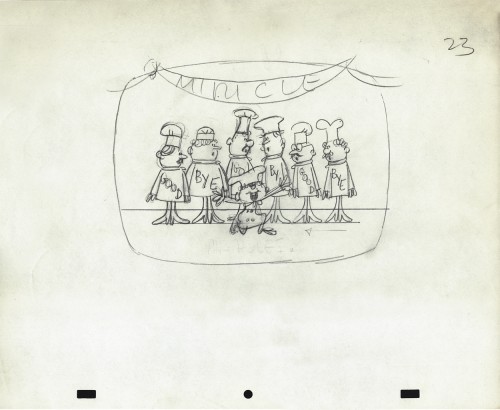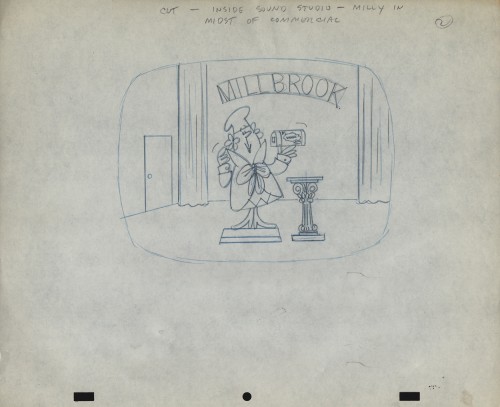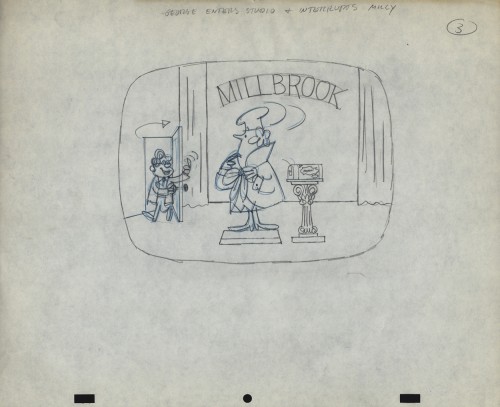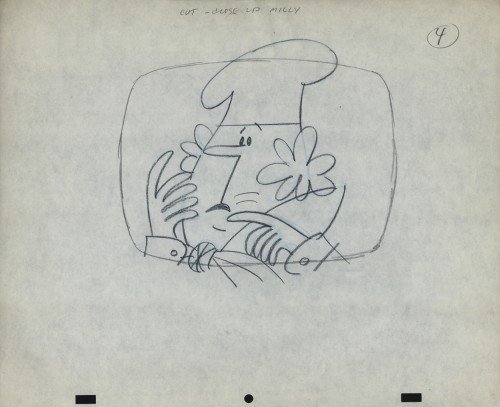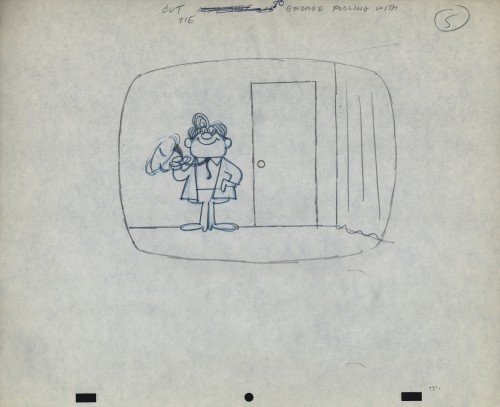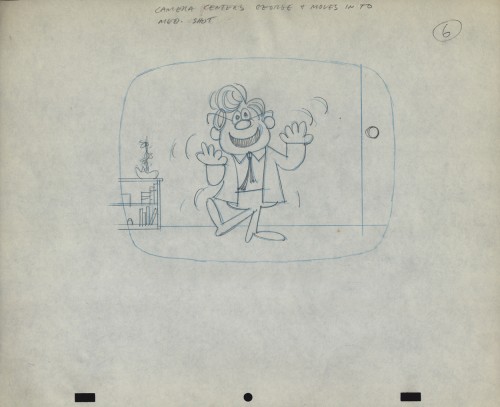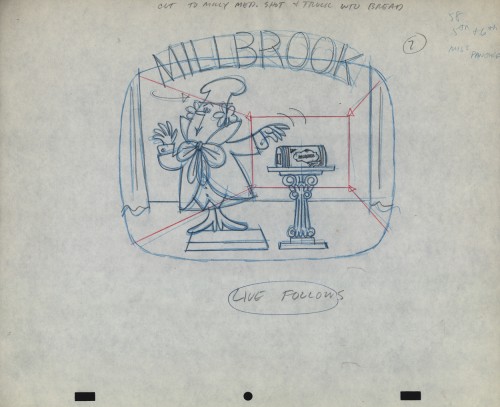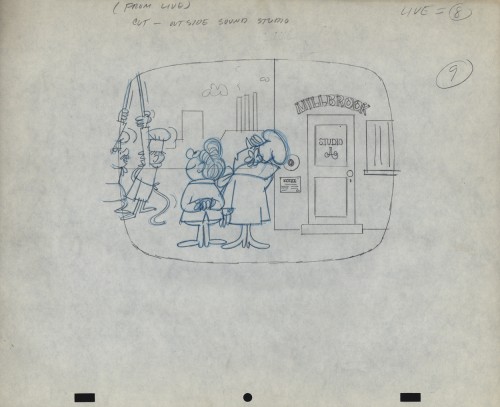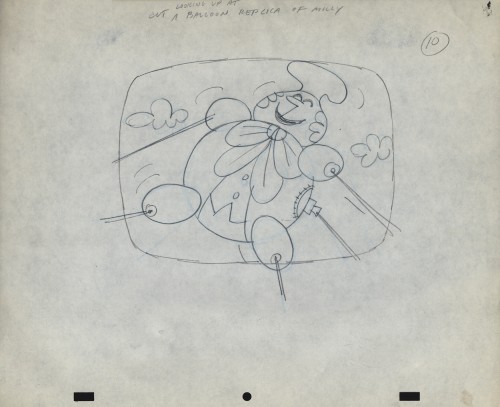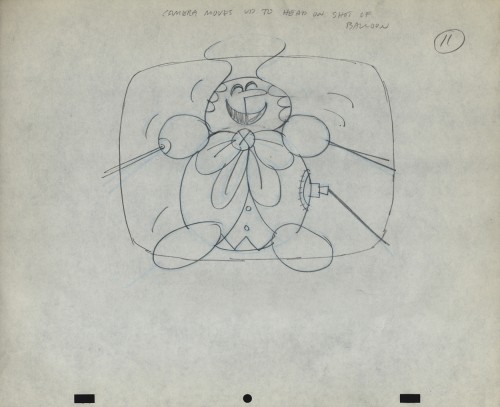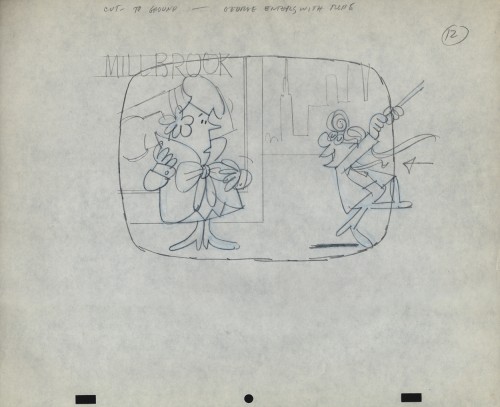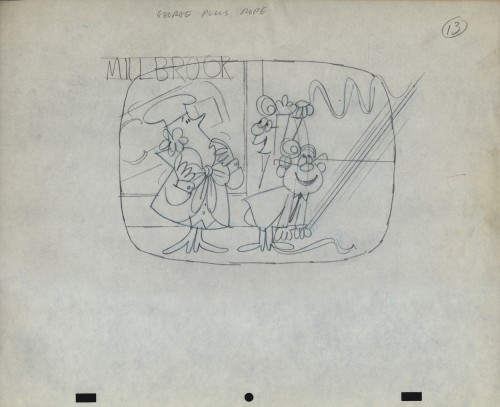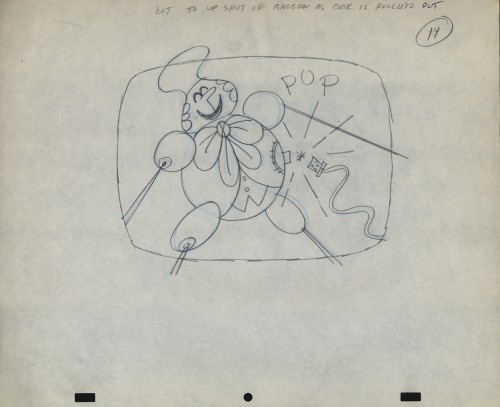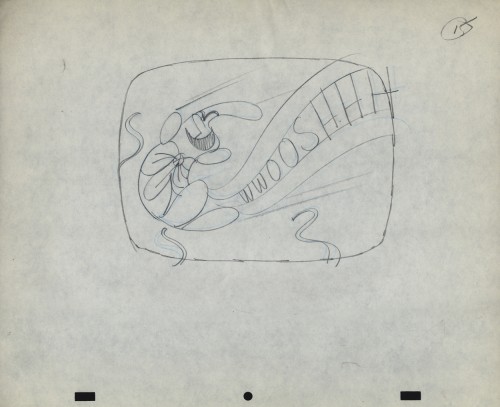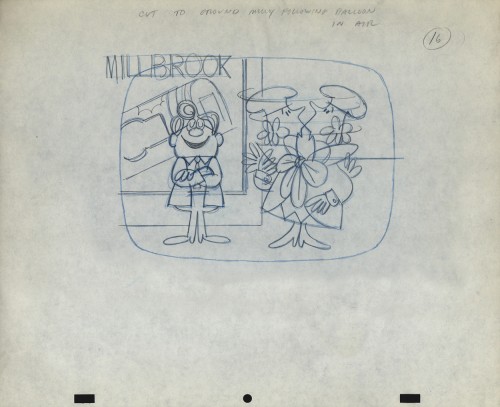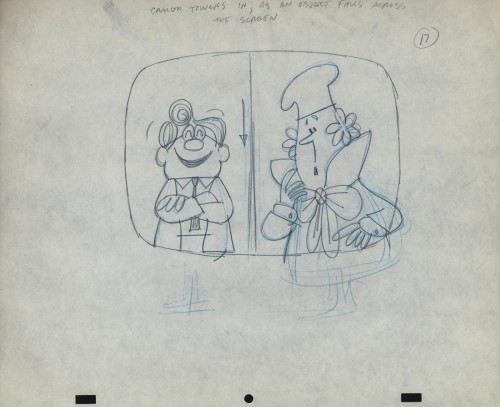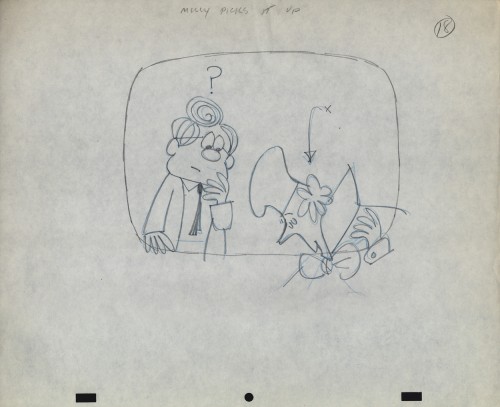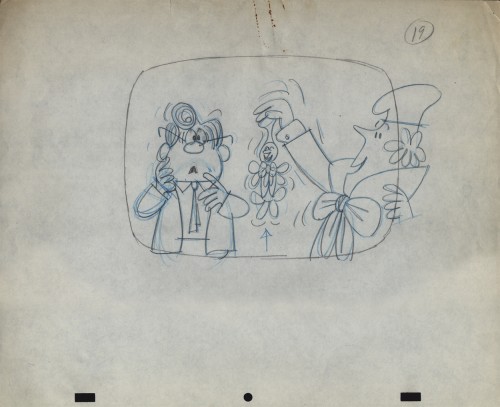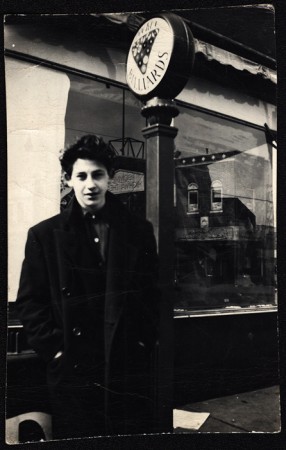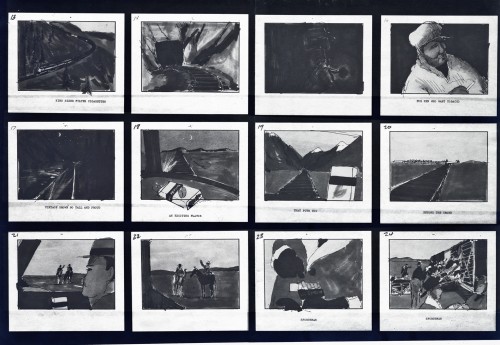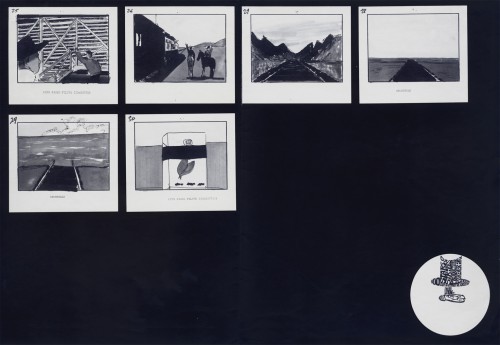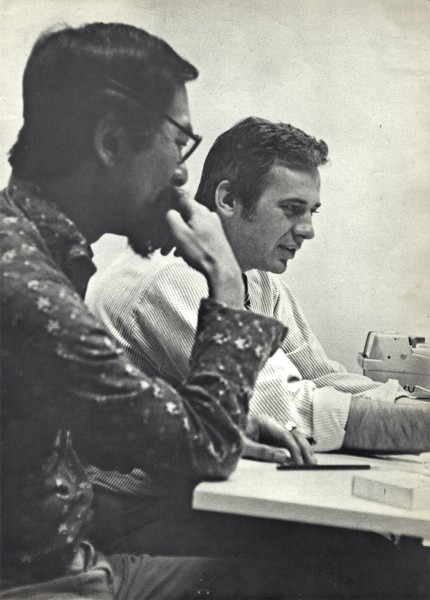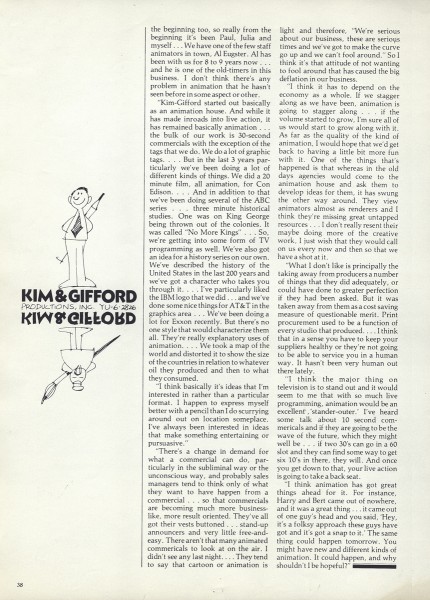Search ResultsFor "piels"
Daily post 13 Nov 2013 01:00 am
Good Will and Great Cartoons
Yesterday’s blog post was something I needed to write for myself.
Animation, as far as I can see hasn’t been going as well as I’d like. The good films have been few and far between.
During my career, I’ve been asked to be involved in a number of fine films. However, it’s the luck of the draw to be involved in good movies, also the power of your own abilities. I can’t tell you how many films, bad films, that have requested my help and participation. Also good films. They’ve been few and farther between, but they’ve been there.
The moment Weston Woods asked me to work on The Man Who Walked Between the Towers I knew this was a good one. It took me about five seconds to read the script and know it was great, and I knew I was working on a winner. There are other films that had the opposite reaction for me, and I was correct there as well.
Yesterday I wrote about a film I was asked to participate in. I knew the very second I saw the project that it would make a great film. None of the story stuff I wrote about – 60,000 flyer pilots (just a metaphor) coming to the rescue – was actually in the film. But the result is the same. The film is a feel good moment, and I know it will make a very good film. Even, god help me, if I’m not allowed to be part of it. It’s a good movie with a good story line. I just hope I am part of it, because I like it enormously.
-
My point, here, is this. Please allow me the use of Miyazaki for my example. The man is a good = no, take that back, a great filmmaker. He not only knows a good film, but he knows how to make them better. The films ha makes become automatically better. He has something to say; he finds curious and complicated ways of telling those stories, and when he is part of a project he gets the most of the story.
He knew he had to make it a children’s film with the simplest of story directions. He had to reach the largest possible audience and be direct. He was, and the film he made was an unmitigated success.
With The Wind Rises he has made an adult film it’s the only way he could tell this tale. He also complicates the structure of the story, and despite the fact that he will not get the largest possible audience, he wants to be sure every aspect of the complicated story is told. This he does. He ignores a large section of the audience for the sake of making a richer story.
His work on the two films, in my mind, can only be seen as the work of a genius. His story is as full as it can ever become, yet he disappoints a small part of the audience searching for the obvious. I can only credit the man, the artist. I also take away very deep lessons about his artistry and what he wanted to do with it. I’ve seen Ponyo half a dozen times with full joy. With The Wind Rises, occurring post Tsunami and post nuclear meltdown, I am sure he has plenty to tell me, and I will see it again and again until I’ve gotten all of its pleasure.
Most prominently I believe he wants to be heard about man’s inhumanity to man. Despite all the natural disaster and chaos in our lives, he uses a man intent on carrying out the best war to get the full tale told. His method is enough to make me tear up, his story goes even deeper.
-
So back to that film that I praised last night. The one that asked me participate in telling a sad and deep story. I am beside myself with joy at having been asked. I hope I remain connected with it. I am honored at having been asked. If I am allowed to continue with it, I will do my very best. If I am not allowed to continue through to the end,I’ll watch and have my opinion, and that’s one opinion I’ll keep to myself.
It’s been a few days since I posted some artwork. Here are some piece I repost which were taken from the collection of Vincent Cafarelli. I’m curently sitting in his desk at Buzzco, so I’d like to see more of the great art that passd his way during the heyday of the commercial in NYC.
Among Vince Cafarelli‘s remaining artifacts there are lots of bits and pieces from several Piels Bros. commercial spots. I decided to put some of it together – even though they’re not really connected – into this one post.
There are animation drawings I’ll try to post in other pieces.
Here, we have a storyboard for a spot; I believe this is an abbreviated spot promoting some contest Piels beer was running. I think this is from a shortened version of a one minute spot since there are animation drawings which are obviously from the same setup, but they’re not part of this storyboard. (There’s an unveiling of the barrel, which is upside down.)
Since the boards are dated 1957, and given the use of signal corps pegs, I believe these were done for UPA.
Regardless, the drawings are excellent. I presume they’re hand outs to Lu Guarnier, animating, and Vince Cafarelli, assisting.
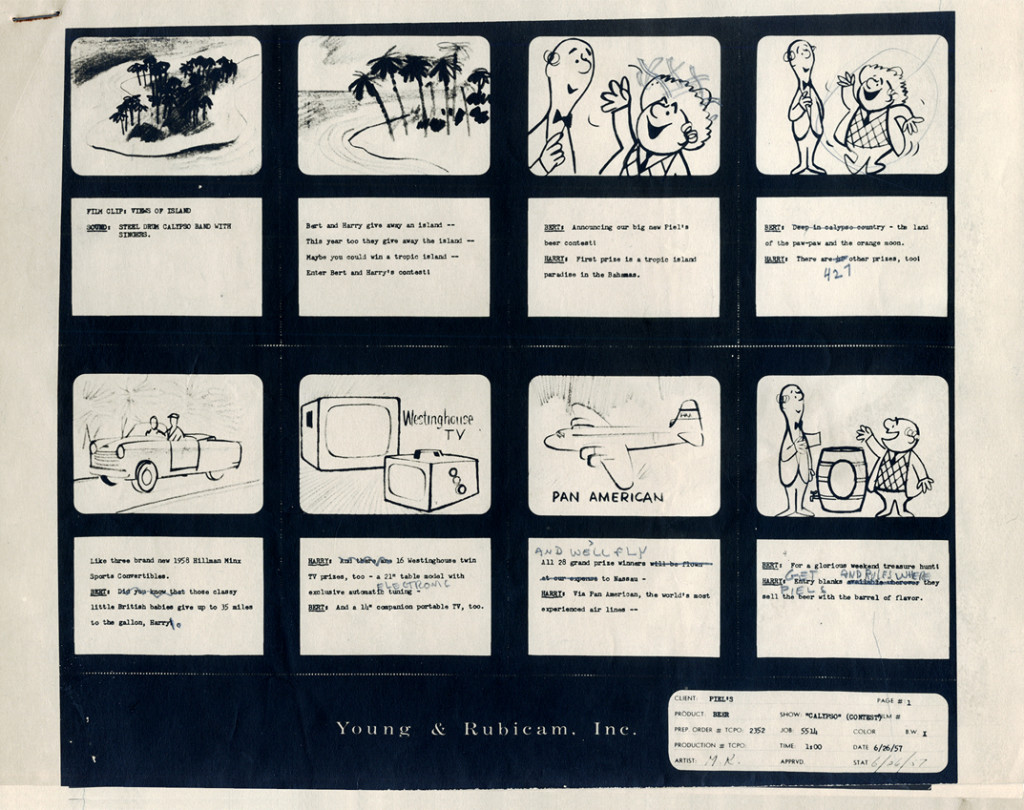 1
1
The following are three drawings from the opening scene of this storyboard. Others from this scene weren’t saved.
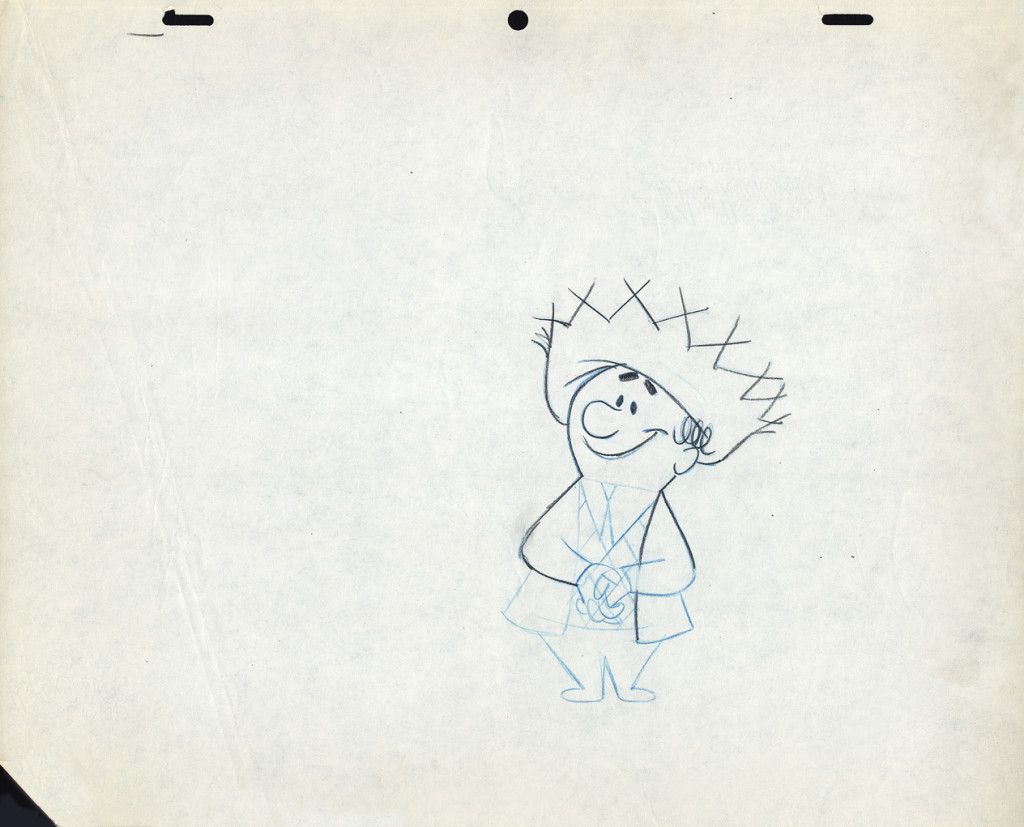 1
1Here’s Bert.
Let’s follow that with layout drawings from two different spots. The first doesn’t really offer much, but the quality of the clean-ups and the drawing is first rate. I’m pleased to post it:
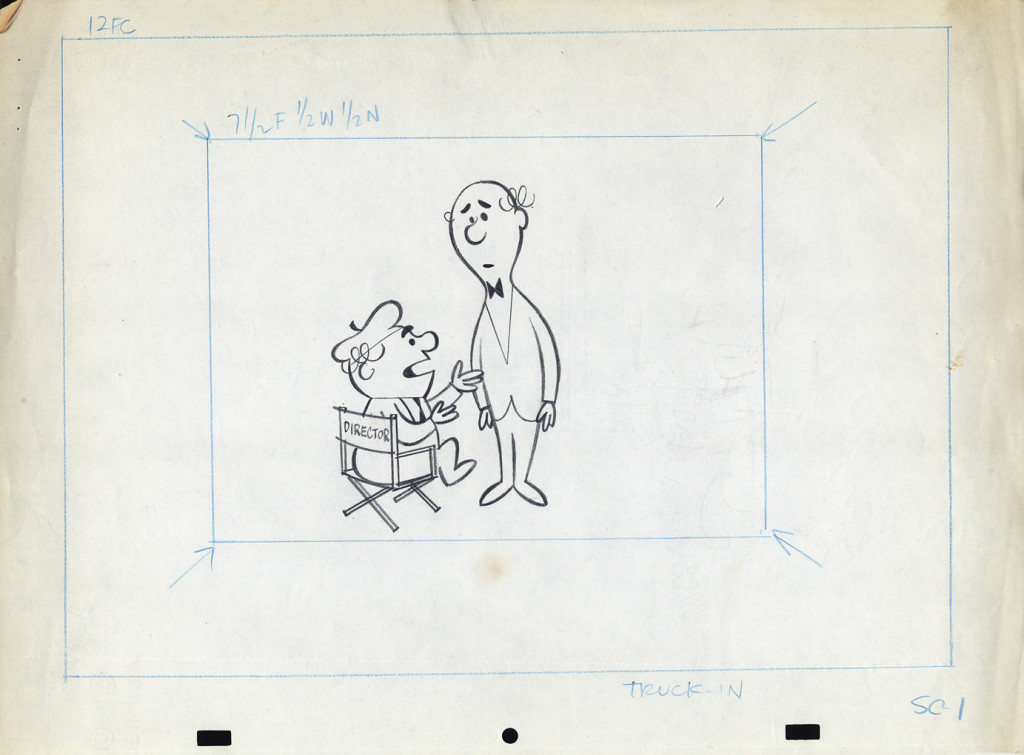 1a
1a
Here are layout drawings for the second of the two spots I have in hand. I presume this is also a spot promoting that contest.
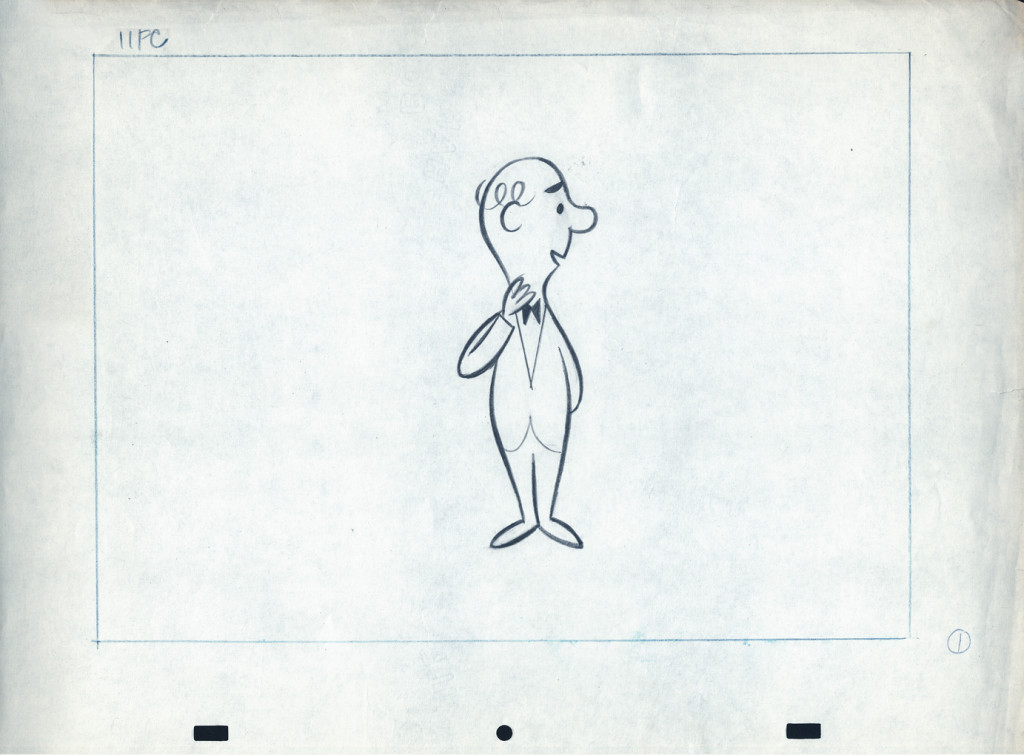 1
1
- Here’s one of the scenes saved by Vince Cafarelli from a commercial he did while at Goulding-Elliott-Graham. The commercial was animated by Lu Guarnier, and Vinny was the assistant on it. Hence, he saved the rough drawings (instead of Bert Piels. (Sorry I don’t know what he’s saying, though I’m looking for the storyboard.)
So, here are Lu’s rough drawings in this CU
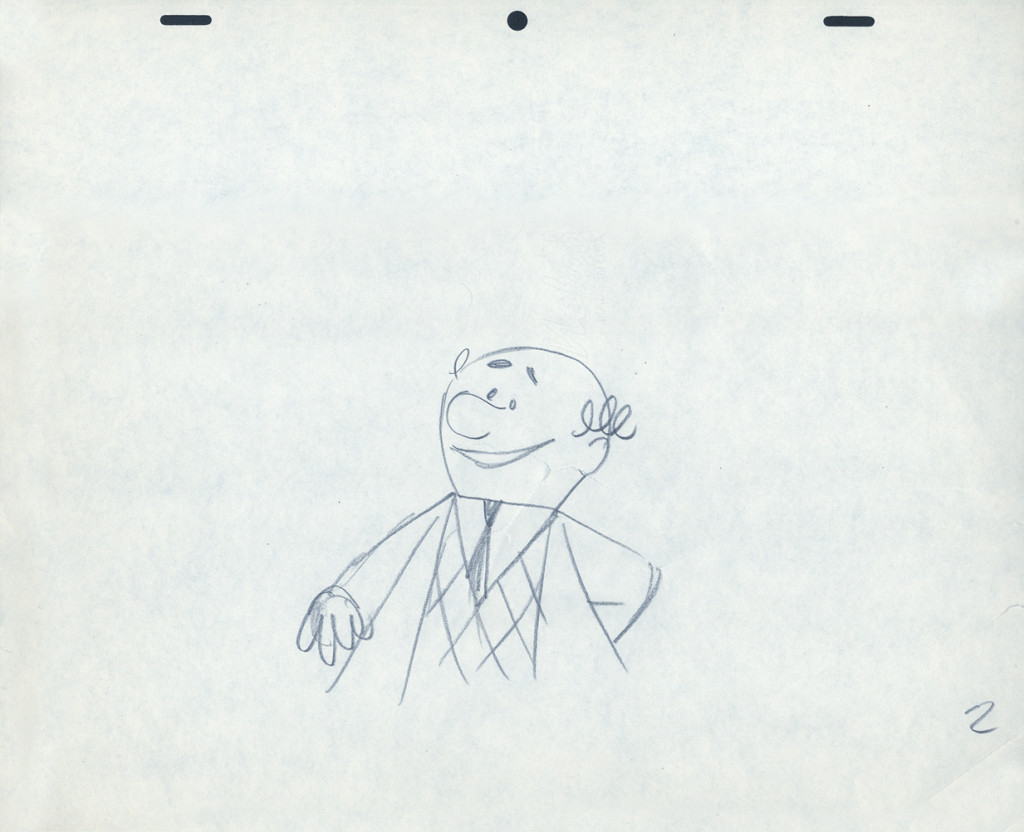 2
2
The following QT movie was made by exposing all drawings on twos
except for the extreme positions that were missing inbetweens.
For those, I dissolved from one extreme to the next.
It drove me crazy that Lu Guarnier always animated on top pegs.
Next week with the last of these three posts on this Piels Bros commercial, I’ll talk about Lu’s animation and some of my pet peeves.
Here’s the last of the three posts I’ve been able to cull from the drawings left behind in Vince Cafarelli‘s things. The 60 second spot was animated by Lu Guarnier and clean-up and assisting was by Vinnie.
Within this post there are drawings from two separate scenes. If you look at the storyboard (I’d posted the entire board in another post, but I’ve pulled the particular frames from the board to show again here), you can see what it is the characters are saying. I don’t have all the drawings for these two scenes; just those I’ve posted.
I’m also going to use these drawings of Lu’s to write about his style of animation. I was taught from the start that this was completely done in an incorrect way. I don’t mean to say something negative about a good animator, but it is a lesson that should be learned for those who are going through the journeyman system of animation.
 Right from the get-go I had some difficulty assisting Lu’s scenes. He started in the old days (early-mid Thirties) at Warner Bros, in Clampett’s unit, and moved from there to the Signal Corps (Army); then to New York working at a few studios before landing at UPA’s commercial studio. After that, he free lanced most of his career, as had so many of the other New York animators. They’d work for six months to a year at one studio then would move on to another.
Right from the get-go I had some difficulty assisting Lu’s scenes. He started in the old days (early-mid Thirties) at Warner Bros, in Clampett’s unit, and moved from there to the Signal Corps (Army); then to New York working at a few studios before landing at UPA’s commercial studio. After that, he free lanced most of his career, as had so many of the other New York animators. They’d work for six months to a year at one studio then would move on to another.
I suspect the problems in Lu’s animation all generated from the training he’d gotten at WB. Lu worked in a very rough style. No problem there. An animator should work rough. These drawings posted aren’t particularly rough, but in his later years (when I knew him) there was hardly a line you could aim for in doing the clean-up. His style was done in small sketchy dashes that molded the character. Rarely was it on model, and always it was done with a dark, soft leaded pencil. There were others who worked rougher, Jack Schnerk was one, but Lu’s drawing was usually harder to clean up.
There was a rule that came out of the Disney studio, and, as both an animator and an assistant, I’ve followed it closely. When doing the breakdown charts (those ladders to the right of the drawing) all inbetween positions had to be exactly half way between drawing “A” and drawing “B”. If the animation called for it to be 1/4 of the way, you’d indicate that half-way mark then indicate your 1/4. If a drawing had to be closer or farther away – say 1/3 or 1/5th of the way – the animator should do it himself. This, as I learned it, was the law of the land. However, Lu would rarely adhere to it, and an assistant’s work became more complicated. The work was too easily hurt by a not-great inbetweener. I’ll point out an example of Lu’s breaking this rule as we come to it).
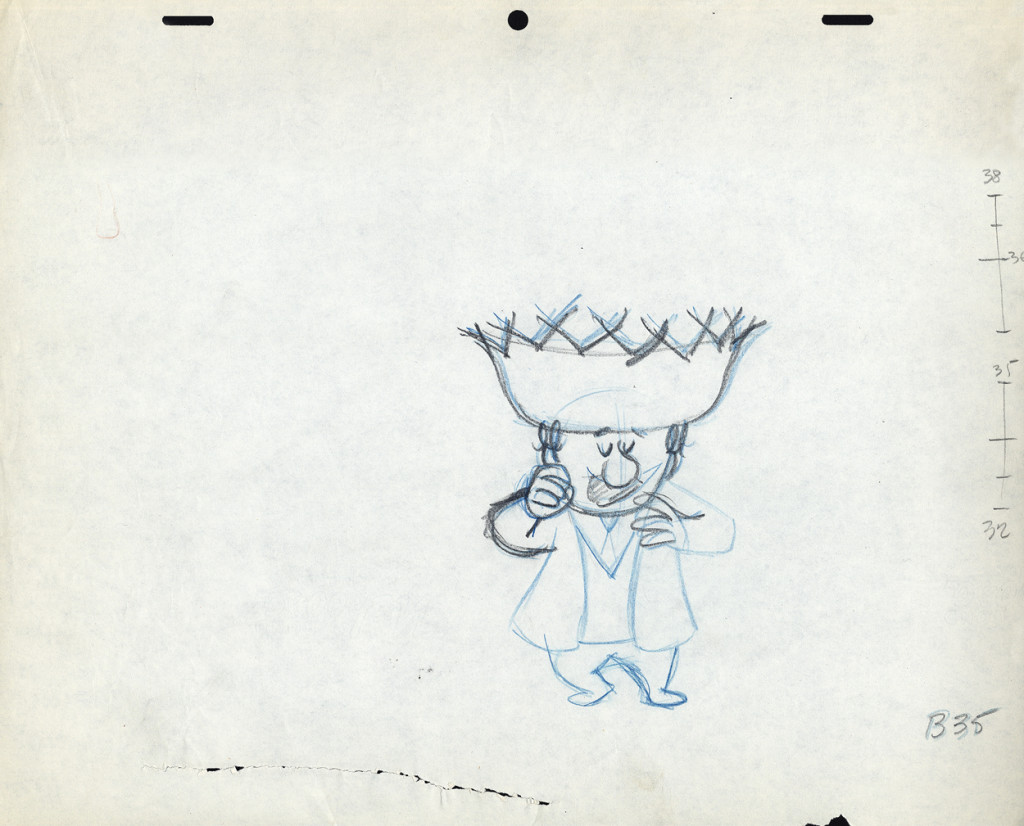 B35
B35
These ladders are done correctly, per the Disney system.
#34 is half way between #32 & #35;
#33 is half way between #32 & #34.
#36 is half way between #35 & #38;
#37 (the 1/4 mark) is half way between #36 & #38.
However, Grim Natwick told me
- demanded of me –
that all ladders should appear on the lower numbered drawing.
The ladder here should be on drawing #32 for all art
going into the upcoming extreme, #38.
Lu never followed this rule, which means the
assistant generally had to search for the chart.
The Second scene
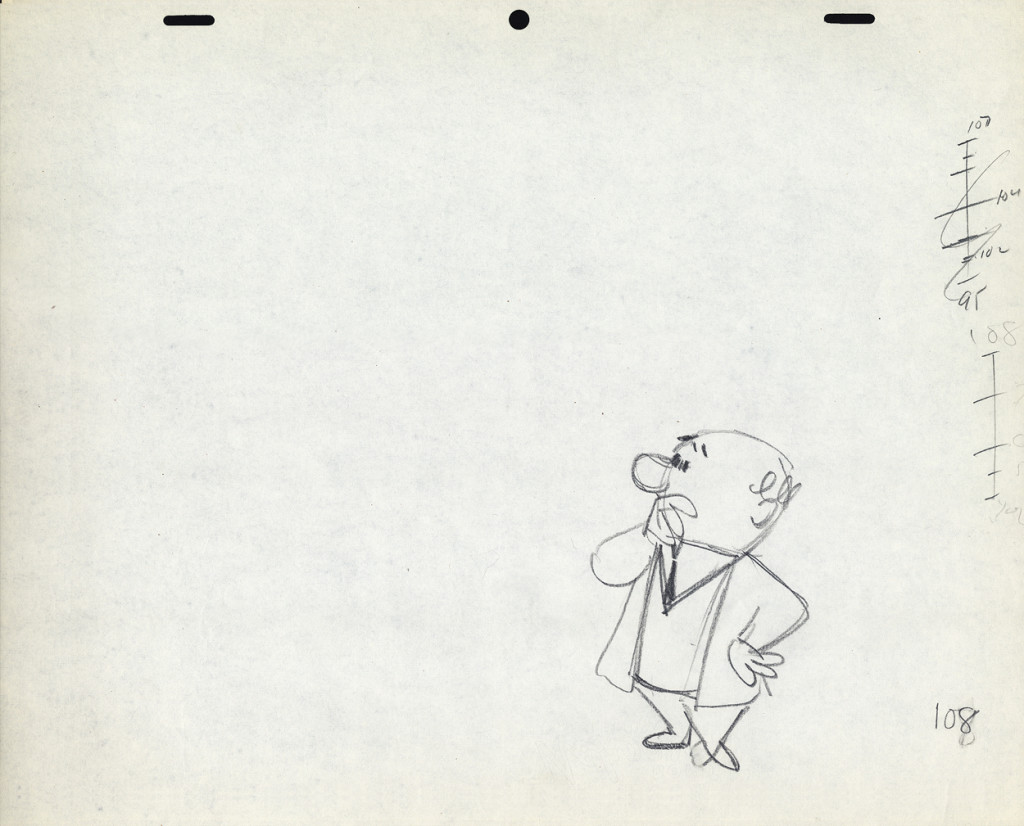 B108
B108
This ladder is typical of Lu’s animation.
It would seem that #106 is 1/3 of the way between #108
and #105 is half way between #106 and #109.
and it also looks like #107 is 2/3 of the way between #108 and #109.
Because the numbers come on the last of the extremes, here,
more confusion is allowed to settle in.
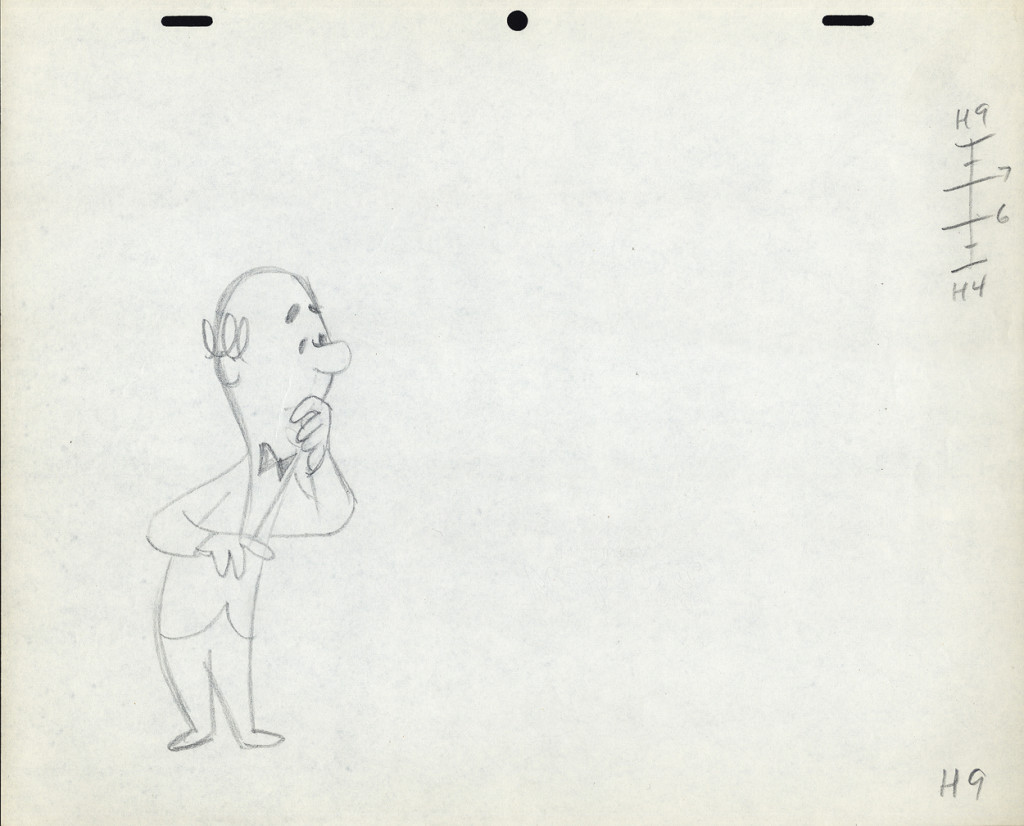 H9
H9
Again, the ladder appears on the later extreme. The assistant
shouldn’t have to go looking for it. The ladder should be on
the first drawing involved in the breakdown.
Again, the breakdown drawings are on 1/3′s, and
the inbetweens are 1/2′s of that. It makes it harder on the
people following up on the clean-up & inbetweens.
I don’t know if this style of Lu’s was a product of where he learned to animate or not. Jack Schnerk, a comparable animator – whose work I loved (even though he had a rougher, harder to clean up drawing style) – always broke his timing in halves and halves again. There were times when his animation went to one’s and he did most of all the drawings. I assumed he had an unusual timing, and he didn’t want to burden the Assistant with his schema. He also always carried the breakdown charts on the earlier numbered drawing – per Grim Natwick’s comment. In some way I felt that Lu was rushed to get on with the scene, and whatever method he used would be to get him there more quickly. (It was the assisting that was slowed down.) This may have been a product of his attempts to devise some type of improvisation in the animation. Lu’s work, on screen, was usually excellent, so he didn’t much hurt anything in his method.
It might also have been his method of trying to put SNAP into the animation. This was a WB trait from the mid-late Thirties. It was certainly in Lu’s animation. No doubt a hold-over from Clampett’s early days of directing.
The final thing to note is that Lu usually worked on Top Pegs. Animating on Top Pegs makes it impossible to “roll” the drawings and check on the movement of more than 3 drawings. You can only “flip” the three, checking the one inbetween, but it didn’t give you a good indication of the flow of the animation. This is obviously necessary in animating on paper. It also made it difficult for the cameraman as well as those following behind the animator. If there were a held overlay, this would have to be on bottom pegs since the animation is on top pegs. That requires extra movement of the expensive cameraman to change all the animation cels after lifting the bottom pegged overlay. It also risks the possible jiggling of the overlay as it’s continually moved for the animating cels.
Animation &Animation Artifacts &Commentary 01 May 2013 06:52 am
Piels Bros Commercial Animation Dwngs
Here’s the last of the three posts I’ve been able to cull from the drawings left behind in Vince Cafarelli‘s things. The 60 second spot was animated by Lu Guarnier and clean-up and assisting was by Vinnie.
Within this post there are drawings from two separate scenes. If you look at the storyboard (I’d posted the entire board in another post, but I’ve pulled the particular frames from the board to show again here), you can see what it is the characters are saying. I don’t have all the drawings for these two scenes; just those I’ve posted.
I’m also going to use these drawings of Lu’s to write about his style of animation. I was taught from the start that this was completely done in an incorrect way. I don’t mean to say something negative about a good animator, but it is a lesson that should be learned for those who are going through the journeyman system of animation.
 Right from the get-go I had some difficulty assisting Lu’s scenes. He started in the old days (early-mid Thirties) at Warner Bros, in Clampett’s unit, and moved from there to the Signal Corps (Army); then to New York working at a few studios before landing at UPA’s commercial studio. After that, he free lanced most of his career, as had so many of the other New York animators. They’d work for six months to a year at one studio then would move on to another.
Right from the get-go I had some difficulty assisting Lu’s scenes. He started in the old days (early-mid Thirties) at Warner Bros, in Clampett’s unit, and moved from there to the Signal Corps (Army); then to New York working at a few studios before landing at UPA’s commercial studio. After that, he free lanced most of his career, as had so many of the other New York animators. They’d work for six months to a year at one studio then would move on to another.
I suspect the problems in Lu’s animation all generated from the training he’d gotten at WB. Lu worked in a very rough style. No problem there. An animator should work rough. These drawings posted aren’t particularly rough, but in his later years (when I knew him) there was hardly a line you could aim for in doing the clean-up. His style was done in small sketchy dashes that molded the character. Rarely was it on model, and always it was done with a dark, soft leaded pencil. There were others who worked rougher, Jack Schnerk was one, but Lu’s drawing was usually harder to clean up.
There was a rule that came out of the Disney studio, and, as both an animator and an assistant, I’ve followed it closely. When doing the breakdown charts (those ladders to the right of the drawing) all inbetween positions had to be exactly half way between drawing “A” and drawing “B”. If the animation called for it to be 1/4 of the way, you’d indicate that half-way mark then indicate your 1/4. If a drawing had to be closer or farther away – say 1/3 or 1/5th of the way – the animator should do it himself. This, as I learned it, was the law of the land. However, Lu would rarely adhere to it, and an assistant’s work became more complicated. The work was too easily hurt by a not-great inbetweener. I’ll point out an example of Lu’s breaking this rule as we come to it).
 B35
B35
These ladders are done correctly, per the Disney system.
#34 is half way between #32 & #35;
#33 is half way between #32 & #34.
#36 is half way between #35 & #38;
#37 (the 1/4 mark) is half way between #36 & #38.
However, Grim Natwick told me
- demanded of me –
that all ladders should appear on the lower numbered drawing.
The ladder here should be on drawing #32 for all art
going into the upcoming extreme, #38.
Lu never followed this rule, which means the
assistant generally had to search for the chart.
The Second scene
 B108
B108
This ladder is typical of Lu’s animation.
It would seem that #106 is 1/3 of the way between #108
and #105 is half way between #106 and #109.
and it also looks like #107 is 2/3 of the way between #108 and #109.
Because the numbers come on the last of the extremes, here,
more confusion is allowed to settle in.
 H9
H9
Again, the ladder appears on the later extreme. The assistant
shouldn’t have to go looking for it. The ladder should be on
the first drawing involved in the breakdown.
Again, the breakdown drawings are on 1/3′s, and
the inbetweens are 1/2′s of that. It makes it harder on the
people following up on the clean-up & inbetweens.
I don’t know if this style of Lu’s was a product of where he learned to animate or not. Jack Schnerk, a comparable animator – whose work I loved (even though he had a rougher, harder to clean up drawing style) – always broke his timing in halves and halves again. There were times when his animation went to one’s and he did most of all the drawings. I assumed he had an unusual timing, and he didn’t want to burden the Assistant with his schema. He also always carried the breakdown charts on the earlier numbered drawing – per Grim Natwick’s comment. In some way I felt that Lu was rushed to get on with the scene, and whatever method he used would be to get him there more quickly. (It was the assisting that was slowed down.) This may have been a product of his attempts to devise some type of improvisation in the animation. Lu’s work, on screen, was usually excellent, so he didn’t much hurt anything in his method.
It might also have been his method of trying to put SNAP into the animation. This was a WB trait from the mid-late Thirties. It was certainly in Lu’s animation. No doubt a hold-over from Clampett’s early days of directing.
The final thing to note is that Lu usually worked on Top Pegs. Animating on Top Pegs makes it impossible to “roll” the drawings and check on the movement of more than 3 drawings. You can only “flip” the three, checking the one inbetween, but it didn’t give you a good indication of the flow of the animation. This is obviously necessary in animating on paper. It also made it difficult for the cameraman as well as those following behind the animator. If there were a held overlay, this would have to be on bottom pegs since the animation is on top pegs. That requires extra movement of the expensive cameraman to change all the animation cels after lifting the bottom pegged overlay. It also risks the possible jiggling of the overlay as it’s continually moved for the animating cels.
Action Analysis &Animation &Animation Artifacts &commercial animation 24 Apr 2013 05:07 am
Piels Bert CU
- Here’s one of the scenes saved by Vince Cafarelli from a commercial he did while at Goulding-Elliott-Graham. The commercial was animated by Lu Guarnier, and Vinny was the assistant on it. Hence, he saved the rough drawings (instead of Bert Piels. (Sorry I don’t know what he’s saying, though I’m looking for the storyboard.)
So, here are Lu’s rough drawings in this CU
 2
2
The following QT movie was made by exposing all drawings on twos
except for the extreme positions that were missing inbetweens.
For those, I dissolved from one extreme to the next.
It drove me crazy that Lu Guarnier always animated on top pegs.
Next week with the last of these three posts on this Piels Bros commercial, I’ll talk about Lu’s animation and some of my pet peeves.
Action Analysis &Animation &Animation Artifacts &commercial animation &Layout & Design 17 Apr 2013 05:51 am
Piels Bros. Odds & Ends
Among Vince Cafarelli‘s remaining artifacts there are lots of bits and pieces from several Piels Bros. commercial spots. I decided to put some of it together – even though they’re not really connected – into this one post.
There are animation drawings I’ll try to post in other pieces.
Here, we have a storyboard for a spot; I believe this is an abbreviated spot promoting some contest Piels beer was running. I think this is from a shortened version of a one minute spot since there are animation drawings which are obviously from the same setup, but they’re not part of this storyboard. (There’s an unveiling of the barrel, which is upside down.)
Since the boards are dated 1957, and given the use of signal corps pegs, I believe these were done for UPA.
Regardless, the drawings are excellent. I presume they’re hand outs to Lu Guarnier, animating, and Vince Cafarelli, assisting.
 1
1
The following are three drawings from the opening scene of this storyboard. Others from this scene weren’t saved.
 1
1Here’s Bert.
Let’s follow that with layout drawings from two different spots. The first doesn’t really offer much, but the quality of the clean-ups and the drawing is first rate. I’m pleased to post it:
 1a
1a
Here are layout drawings for the second of the two spots I have in hand. I presume this is also a spot promoting that contest.
 1
1
In the next week or two, I’ll post some of the animation drawings left behind so you can get an idea of the movement and Lu Guarnier‘s animation. I’ll probably have some to say about Lu’s style of movement. It drove me crazy when I had to assist him. The movement always looked great on screen, but it took a lot for an assistant to get it there.
Animation Artifacts &commercial animation &Story & Storyboards 24 Oct 2012 06:13 am
Goulding/Elliott/Graham Storyboards
- Goulding, Elliott, Graham was a company made up of comedians, Ray Goulding and Bob Elliott (“Bob & Ray”) and designer/director, Ed Graham. After the Piels Bros beer account did so well, Bob and Ray realized that they should have a larger piece of the pie, so they set up their own studio to produce commercials that featured their voices and their writing talents. This was an instant success which soon dissipated until the studio closed only two years later.
But they had a nice run. Vincent Cafarelli, obviously, had a good time at the studio (he’d left assisting at UPA to work there). In his collection of animation artifacts, there’s a folder of storyboards for commercials they’d made. I’ve put together a number of these boards and will show them here. I do notice that the writing is interesting (compared to any commercial on the air today) and the design is often exceptional. I hope you agree.
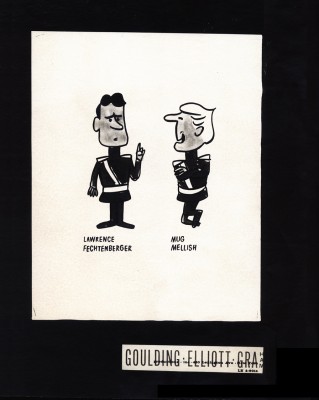
A model of the two characters in this spot.
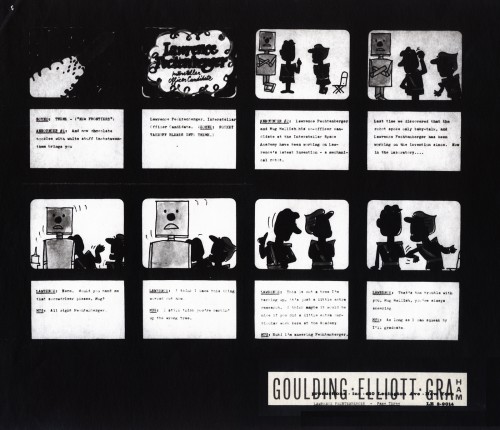 1
1
I can only assume this is an ad for some kind of
“Oreo”- like cookie. The sell is so soft that I can’t
even figure out the client. Doesn’t sound successful.
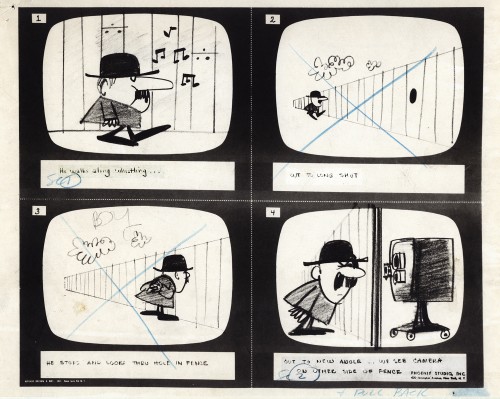 1
1
There’s no doubt that Len Glasser designed this.
It looks just like a character he later did for Ernie Pintoff.
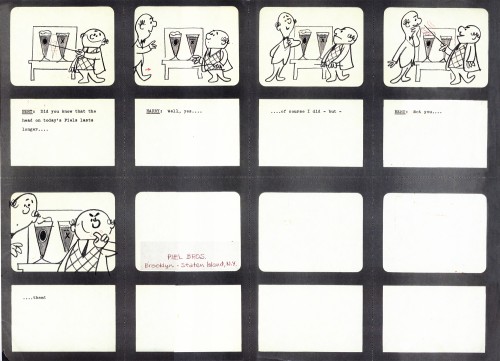
The only spot for Piels, in the collection, is obviously
this short ID – probably 10 secs. long.
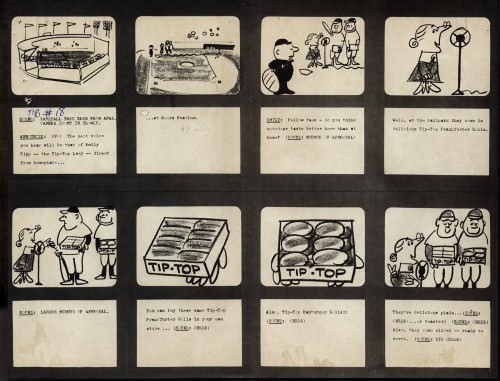 1
1
We’ve seen a number of these Tip-Top Bread spots.
They were certainly a primary client for the company.
These boards were in with the Goulding-Elliott-Graham material,
actually was done at Gifford Studios (Lou Gifford & Paul Kim).
Vince has a lot of these folders in his collection improperly labeled.
Animation &Animation Artifacts &commercial animation &Layout & Design 26 Sep 2012 05:15 am
Vince Cafarelli’s Millbrook Bread – 2
- Last week we saw the first of these two spots Vince Cafarelli did while working for Goulding-Elliot-Graham Prods., Inc. Millbrook Bread was the client and the Piels Bros. voices, Bob Elliott & Ray Goulding, owned the studio with Ed Graham. They also did the voices for these bread spots. This particular one must have been pretty big; the video survived these many years later, and I’ve attached it to the end of this post.
But first, here are the Layout drawings which I believe were done by Vinnie Cafarelli.
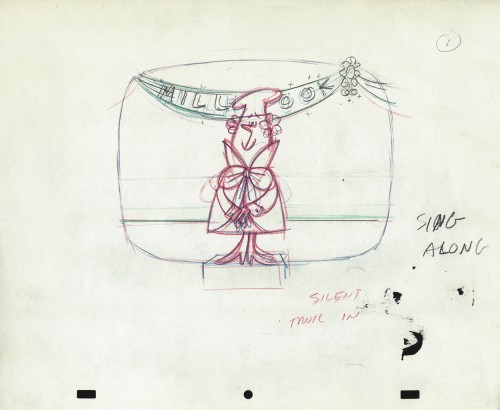 1
1
Animation Artifacts &commercial animation &Layout & Design 19 Sep 2012 05:22 am
Vince Cafarelli’s Millbrook Bread – 1
- When Bob Elliott and Ray Goulding (of Bob & Ray fame) found a chance, they scooped up the Piels Brothers account from UPA and, with Ed Graham, they opened their own animation studio to do the Piels commercials. The blend didn’t last long, and they soon went out of business. Vince Cafarelli worked at Goulding-Elliott-Graham Prods. for a while and several Millbrook Bread commercials were produced, featuring “Milly” the baker.
I remember these commercials from my childhood well. I loved the very graphic style of the spots. I remember seeing how the character turned his head (see number 16, below) and was taken by the movement. I think I was probably 11-12 years old at the time. The video records the date as 1963, but I’m sure they’re wrong – 1959, maybe?
I previously posted this Christmas card from Goulding-Elliott-Graham Prods., Inc. If you click on the card and look in the window of the house, you’ll see “Minny” the Millbrook baker (centered) within, singing Christmas Carols.
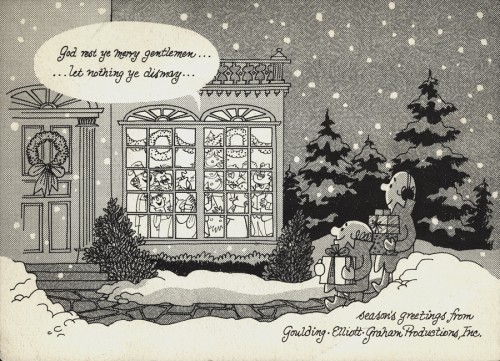
Michael Smollin takes credit for directing the commercials, but I’m not sure he worked for Elliott-Gould-Graham. I thought that Ed Graham had directed all spots in house. Smollin may have designed the characters. We’re assuming that Vinnie drew these images. The writing is his. It’s doubtful he would have been directing at this point, so he probably drew the Layout drawings.
In Vinnie’s collection of art, the layouts for two of these spots were found. I’ll post these from the first spot this week and the second spot will come next Wednesday.
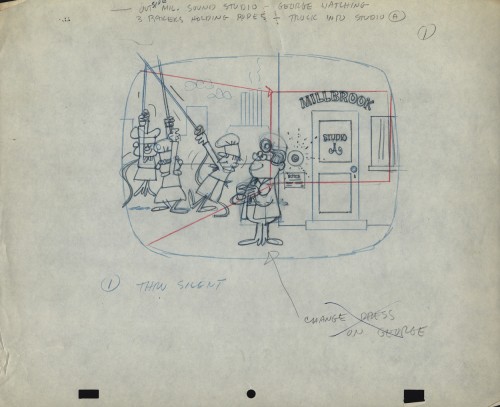 1
________________________________
1
________________________________We don’t have a copy of this spot that we could post. However, to give you an idea of how the voices sounded, here’s a vradio spot done for Millbrook Briead by Bob and Ray.
Animation Artifacts &commercial animation &Illustration &Models 05 Sep 2012 05:40 am
Odds & Ends from the Cafarelli collection
- Going through a stack of boxes searching for genuine animation, one tends to find a number of gems that represent animation past but don’t nicely link to other pieces. The end result is that you hold a lot of odds and ends in your hands and you seek a way to post them. That’s certainly the case with Vinnie Cafarelli’s collected works.
I’ve located a lot of pieces that interest me, but I don’t necessarily know where they come from or why they were saved. So today I’m posting a number of these bits of art.
Here we have Layouts, cel setups, photos, models and more than a small share of invitations and Christ cards. Here they are:
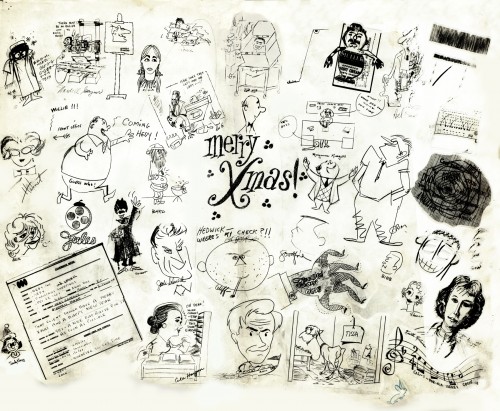 1
1A Christmas Card from the NY-UPA Studio.
Many of the employees signed it.
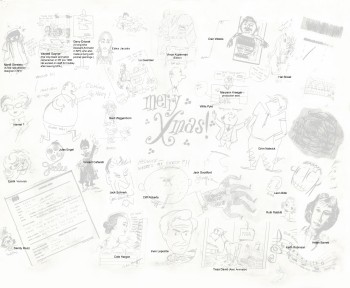 1a
1a
A guide to many of the names
of those who signed the card.
(Click to enlarge)
I had a scanning problem on the upper
right and will try to correct that.
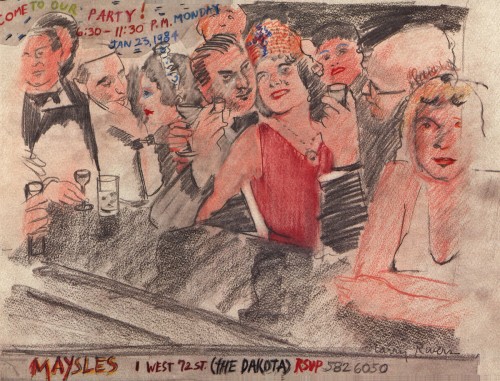
An invitation to a Christmas party at the Maysles Bros
studio. Certainly only for a member of the elite.
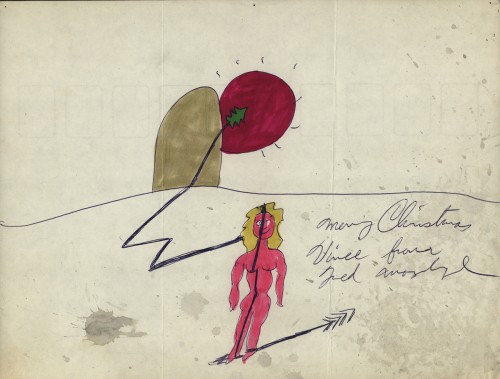
A Christmas Card from Fred Mogubgub.

A Christmas Card from the Goulding-Elliott-Graham Prods.
Ray Goulding and Bob Elliott, together with Ed Graham formed
this studio to do Piels commercials. (Bob Goulding & Ray Elliott were the
voices and held onto ownership of the characters. work dried up soon
since one commercial product & client couldn’t maintain the studio.)
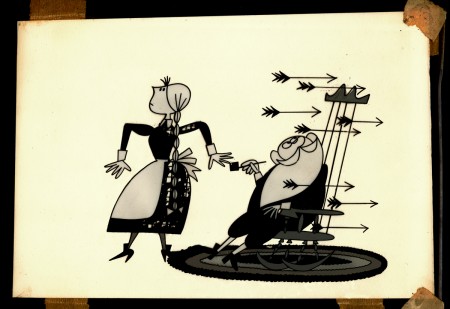
A finished setup from a Yellow Pages commercial.
This was done at Gifford Productions.
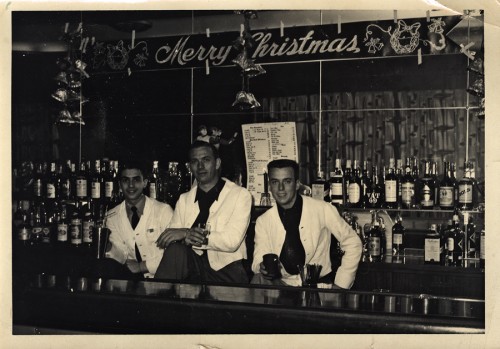
Vince Cafarelli (far left) while in the military at
Fort Benning, Ala. made extra money as a
bartender. These are the days just prior to his
workng at UPA.
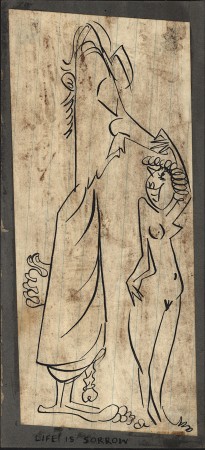
A small racy sketch among the art.
We’re not sure who drew it but guess
it might be Vince Cafarelli’s work.
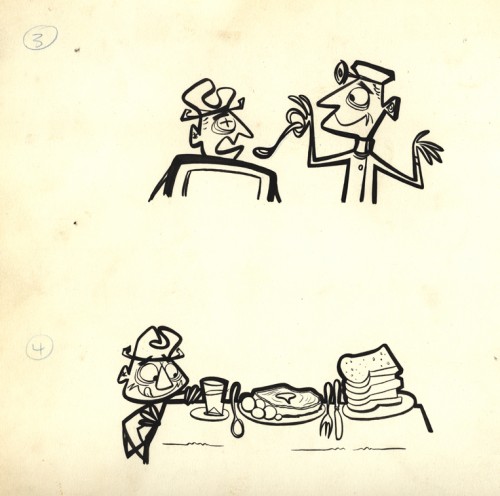
All that remains of a pitch for an antacid spot.
Obviously drawings 1 & 2 are missing, but
these two were interesting enough for me to post.
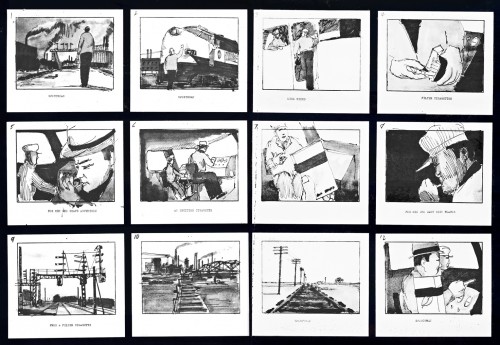 1
1
A storyboard (3 pages) for a cigarette company
(Sportsman Cigarettes?). Obviously a sample board.
Is it a live action spot? Probably for Gifford Studio
which also did live action spots.
Articles on Animation &commercial animation 10 Jul 2012 04:33 am
Gifford on Animation
- The Gifford Studio, in NYC, was one of the prime boutique shops for animation from the 50s through the 80s. The studio was formed in 1958 to service Bob and Ray who hoped to dominate the Bert & Harry Piels Brothers account. Eventually, they came to feel as though there were too many bosses, and they separated. Eventually, the studio became Kim-Gifford Studio, and they continued to operate primarily as a commercial producer for many years.
Al Eugster was the permanent/on-staff animator through many of those years. You can see more photos of him at Mark Mayerson’s vital website: Eugster’s Photo Album.
I recently found this article among Vince Cafarelli’s collection of artwork. resumably, though this article was not when Vince worked at Kim-Gifford where he did the Emily Tipp series, he was interested enough to hold onto the piece. The article is from Making Films in NY, Dec.75 issue, and thought it interesting enough to post.
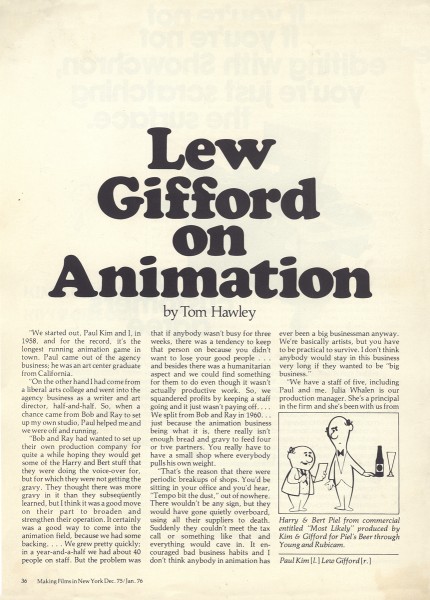 1
1
Commentary &commercial animation 04 Dec 2011 07:51 am
Vince Cafarellii (1930-2011)
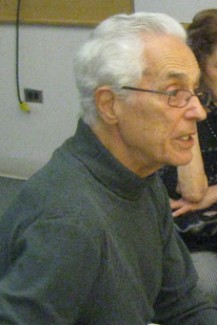 - I’m sorry to report the sad news that Vincent Joseph Cafarelli died in his sleep yesterday.
- I’m sorry to report the sad news that Vincent Joseph Cafarelli died in his sleep yesterday.
He was 81 years old.
“Vinnie” was a principal mainstay in the New York animation industry. He worked at Famous Studios on classic characters Popeye, Little Audrey and Baby Huey.
Later he worked at Gifford Animation on such advertising campaigns as the Piels Brothers and TipTop Bread. Margaret Hamilton provided the voice for Emily Tipp! You can go here to see 3 examples of the TipTop Bread commercials produced in the 1950′s.
Vince joined Stars and Stripes Forever, Inc, as their first employee upon his return from London, England where he worked with Pablo Ferro. Stars and Stripes was owned by producer Bob Staats and designer Len Glasser. They became the hottest boutique shop in the psychedelic 60’s creating such classics as: Chicken of the Sea “Mermaidâ€, Speakeasy, Sparklettes, and Ortho.
While at Stars and Stripes Vince worked with designer, Hal Silvermintz and film editor, Buzz Potamkin. Those two left to form Perpetual Motion Pictures, Inc. and after Stars and Stripes folded, Vince went to join them. There he was responsible for many ad campaigns and co-directed Strawberry Shortcake in Big Apple City and animated on all 5 Berenstain Bears holiday specials. He co-directed Deck the Halls With Wacky Walls.
Ultimately, Vinnie joined with Candy Kugel to form Buzzco Associates where he remained to the end. The two of them worked together for many years. You can check out a gallery of his art at AWN.
I’ve known Vinnie for 35-40 years, and can’t think of a sweeter gentler soul in animation. Most recently we’ve met on a number of occasions at the Academy. We spent a lot of the ten hours watching the long list of shorts and had a good time talking about them. I’ll miss his presence. My heart goes out to his family as well as Candy Kugel and Marilyn Kraemer who’ve spent every day with him for the past forty-odd years together. The three were partners in business and friendship and were completely dependent on each other.
More details of his life as well as information on memorial services will be forthcoming later. Buzzco is intending a memorial to take place on the Epiphany, January 6th, 2012; I will make sure to post further information on this site.
